Fearlessly Italy

Planning a Trip to Italy – Our Easy Step-by-Step Guide
Are you planning a trip to Italy and don’t know where to start? We’ve made a list of the most essential tips on how to plan a trip to Italy with both a foreign (my husband) and a local’s (myself) insight.
We touched on the most important details you shouldn’t neglect in your Italy trip planner and gave you the necessary tools to plan your holiday on your own.
Even though Italy is a very popular travel destination, proper trip planning is necessary to avoid unwanted surprises. Do you need a visa to travel to Italy? Do you have a favorite type of accommodation? When is the best time to visit Italy and where would you like to go?
We are going to give you handy tips on how to say basic sentences in Italian, we will give you some itinerary-planning suggestions, and even list some of the most popular food stores in Italy where to buy your groceries if you are renting an apartment.
From getting around to deciding where to stay and what to pack, here is all you need to plan a perfect trip to Italy. For more detailed information about the cost breakdown, how to get to Italy, how to get around with local public transport, and important numbers to know in case of emergency , check out our complete Italy travel guide .
Table of Contents
How many days in Italy is enough?
The ideal amount of time to set when you planning a trip to Italy is 2 weeks . If you are visiting for the first time, two weeks is a perfect time to explore the most famous cities and also include some day trips.
If you have already seen the biggest tourist draws and want to go offbeat, 2 weeks still is an ideal time to set for Italy. Alternatively, you can also opt for 10 days in Italy and stick to the most famous destinations and mainly big cities to reach by train.
What is the best way to plan a trip to Italy?
The best way to plan a trip to Italy is to make a list with all the necessary steps ahead of time. While things like packing can be done right before leaving, other things need to be planned in advance. This is what you need to plan and book ahead when organizing your Italy vacation.
- International flights. This is especially necessary if you have fixed holidays and can’t play too much with the dates.
- Travel documents. You need to make sure your passport has 6 months of validity and you need to check your visa requirements in advance.
- Hotels. Especially in the high seasons and in smaller towns with limited options.
- Tours and tickets. Even if you don’t want to book a private tour, purchasing a skip-the-line ticket to crowded attractions will save you plenty of time.
- Restaurants. It’s better to book your table ahead on important days like Christmas for lunch and dinner, New Year’s Eve “cenone” dinner, or lunch on Easter Sunday because many Italians go to eat out and restaurants are very crowded.
- Domestic travel. Whether you are taking a domestic flight, a train, or an extra-urban bus, I highly recommend booking your tickets early to avoid finding all sold out.
- Itinerary planning. This is pretty much one of the very first things to plan so that you know which flights or trains to book, where you will need a hotel, and what landmarks you will want to visit.
How to plan a trip to Italy – All you need to know step-by-step
Research the best time to travel to italy.
When planning a trip to Italy, the first thing you should consider is when it’s the best time to travel also depending on when your holidays are. Every season is a good time to visit Italy .
Do you want to enjoy the beach? How about Sardinia, Sicily, or Puglia in the summer?
July and August are hot and very crowded, but if you can make it in June before the mass tourism starts or September after the crowds are gone, you will love it. If you are planning your trip in the summer, keep in mind that you will find quite a few mosquitoes in many regions of Italy .
If you are a practicing Catholic or love ancient history, then Rome is your ideal destination. If you are a Renaissance art lover, you can’t miss Florence , while if you are hiking and skiing passionate, you will certainly enjoy Trentino Alto Adige’s Dolomites in both summer and winter.
Even though winter is cold (and in northern Italy very cold), this is a great season if you are a ski lover, or even to visit more southern regions where the weather is definitely milder. If you want to celebrate and experience the Christmas vibe, December in Italy is a magical time. To attend some Carnival parties, you should travel to Italy in February .
Weather-wise, spring and fall are probably the best seasons to plan a trip to Italy. In spring, flowers are blossoming, the colors are bright and the scents are intoxicating. Plus, the weather is lovely and even if sometimes it does rain, it makes for a very pleasant walk. Both March and April are great months to visit Italy. April is usually when we celebrate Easter in Italy and big cities can get very crowded.
Autumn is a good season because it’s not too hot anymore and not cold yet, so easy to walk around. During fall, too, it can rain, but the colors of the falling leaves and day and evening lights are very romantic.
Check if you need a visa
When planning a trip to Italy, check out the visa requirements. Several nationalities can get an Italian visa on arrival, while others need to apply in their home country for an Italy/Schengen visa. If you were granted a Schengen visa and you enter the area from another EU country, you can then travel to Italy, too.
The conditions to be granted a visa to Italy go from the type of visa you are applying for, the duration of your stay and your nationality. Nationalities like the US, Brazil, Argentina, Israel, UAE, Australia, New Zealand, Singapore, and Japan don’t need to apply for a visa for up to 90 days’ stay. They only need to show their passport with at least 3 months’ validity to the border police at the airport.
To make sure if you need to apply for a visa and what documents are required, answer a couple of questions on the Foreign Ministry’s official website and you will get all the information you need.
Find the best flights to Italy
There are several websites where you can check for the best flight deals to Italy. The portal I normally use is Skyscanner because it compares different airlines and other comparison websites, so you will have a broader view.
You can also check the prices and promotions in different Italian cities, so depending on where it’s more convenient, you can start planning your Italy itinerary. On top of that, Skyscanner allows you to receive price alerts for the flights you are looking for directly in your email.
Alternatively, you can check the single airline websites such as ITA, Delta, American Airlines, British Airways, Lufthansa, Iberia, Tap, and many others that land in Italy. Some of the low-cost you can take from other European countries are EasyJet, Ryanair, and WizzAir.
I found that they are actually low-cost when you travel only with small hand luggage. But if you start adding checked-in luggage and services, their fares are not much different from the ordinary airlines. Whichever airline you are booking your ticket with, make sure you check the TSA liquid rules .
How to get around Italy – Using extra-urban public transport
Italy has a great and very widespread railway system , so if you are traveling independently, you can totally rely on Trenitalia or Italo Treno. After each major city, I mentioned the transport you can book to get to your next stop but the Italy railway is great for reaching also smaller towns and even tiny villages. The perfect way of traveling around Italy for two weeks.
So if you are in Rome and want to visit nearby towns like Bracciano or Viterbo, you can easily take the train, or reach the towns of Terni, Perugia, Orvieto. Or even if you are in Sardinia, the railway really reaches improbable tiny villages.
For train routes, prices and connections, you can check the websites of Trenitalia , Italo Treno , and Omio (formerly GoEuro).
If you are visiting cities and towns within the railway network, you are covered. But if you are planning on getting off the train route, relying solely on the buses might not be as straightforward. In this case, I suggest renting a car, a great option for an Italy road trip.
Decide when to rent a car in Italy
If you want to visit also other places without sticking only to the major cities, the easiest and best way to travel in Italy is by renting a car. For example, if it’s not your first trip to Italy and you want to go off the beaten path to explore some gorgeous and famous countryside, your own car becomes essential.
For example, in Sardinia, you totally need to rent a car . The trains get you only this far, stopping mainly in Cagliari , Orist ano, Sassari and Olbia, several smaller villages but most of the archaeological sites , as well as the beaches, are impossible to reach with public transport. There are some buses but very few.
The same goes for regions like Umbria and Tuscany. They boast fantastic countryside, but you will need a car to get there. In general, southern and central Italy requires a car, while in the north you will have a more widespread public service. Even though in mountain areas solely relying on the buses will prevent you from seeing many places and you won’t be free to manage your time.
Please note that in order to drive in Italy, you need an international license that you can get in your home country.
Click here to see prices, cars, and deals.
Decide what to pack, essential when planning a trip to Italy
You can decide what to pack for Italy when you know in which season you are taking your trip. For example, since Spring is a very popular season, what to wear in Italy in May? While the weather is lovely this time of the year, it can sometimes be tricky as temperatures change all of a sudden.
My advice would be to wear different layers so that you can cover quickly if you stay out all day until evening when it’s usually colder. So if you are planning a 2-week trip to Italy in Spring, make sure you pack some pretty flexible clothes and are ready for the warm and crisp weather.
On the other hand, what to wear in Italy in September ? The beginning of the Fall in Italy is pretty nice as the summer heat is mostly gone and the winter cold has not arrived yet. Mostly, you can wear summer clothes with a jacket, a light jumper, and a light scarf for the evening. You might find some showers, too, so make sure you pack an umbrella. Better if small so you can carry it around easily.
If you are wondering what to pack for Italy for the winter, it’s pretty straightforward: definitely warm clothes, a jacket, a coat, warm trousers, socks, and everything you are comfortable with. Quite straightforward is also packing for a summer Italy trip: shorts, T-shirts, sandals or summer runners, and obviously a bikini if you are going to the beach!
Avoid annoying online surcharges and nasty surprises by weighing your suitcase with one of the best digital luggage scales .
Sadly, on public transport in Rome, you need to be careful about the pickpockets as it’s still a problem both on the buses and on the metro. This is why, for your peace of mind, you can buy anti-theft clothes. Clever Travel Companion has a great choice of models, colors, and clothes such as scarves, boxers, leggings, tops, t-shirts, women’s underpants and more. Click here to check models and prices.
Tailor your own Italy itinerary
A major point of your Italy trip planner will be designing the perfect itinerary. This depends on many factors, if it’s your first time in Italy and you want to visit the most popular landmarks, whether you prefer the beach or the mountain, or maybe relaxing on a quiet hill surrounded by nature and silence. And obviously how much time you have, if you are staying two, three weeks, or ten days in Italy.
Here are some examples of itineraries:
- Two-week classic itinerary. Perfect for those who are planning their first trip to Italy and want to see classics like Rome, Florence, and Venice. Check out our classic Italy itinerary suggestions where we include also Cinque Terre and Naples plus some other detours if you have more than 2 weeks.
Check out our tailored Rome itineraries and travel services!
- Italian islands. This is great if you have been to Italy already and want to go a bit off the beaten path. You can visit Sardinia and Sicily, and enjoy fantastic food and beautiful landscapes. Sardinia is wilder and home to countless archaeological sites. In Sicily, you can explore its Greek past in places like Valle dei Templi near Agrigento, beautiful Baroque and Norman cities like Catania, or the wonderful capital, Palermo, known as Italy’s most “Arab”. If it’s summertime, both islands will spoil you wonderfully with their beaches. Check out our guide to the most beautiful beaches in Sardinia .
Do you need help to plan your trip to Sardinia? Check out our customized itineraries and travel services!
- Northern Italy itinerary. Are you a sport, mountain, and adrenaline junkie? Then northern Italy is for you. Go hiking, trekking, climbing, and skiing in the Italian Alps and the Dolomites and be surrounded by breathtaking landscapes, wild nature, and wonderful snow-capped peaks. Do you prefer to explore the northern historical cities? Head to the beautiful Turin , Milan , Trento , Venice, Verona , Bolzano , or smaller towns like Merano and Bressanone.
- Southern Italy itinerary. The south of Italy will make for a different type of adventure but by no means less exciting. Regions like Puglia, Calabria, Basilicata and Campania are rich in culture, traditions, and great food. Some of the places not to miss in the south are Naples and Caserta in Campania, Bari, Lecce, Alberobello and Ostuni in Puglia, Matera, Maratea and Craco in Basilicata, Reggio Calabria, Tropea and Scilla in Calabria. If you are left with some days, the step from Calabria to Sicily is pretty short!
- Central Italy countryside. This trip is all about relaxing and enjoying the nature of the Apennine soft rolling hills. Regions like Abruzzo , Umbria, Tuscany, Lazio, and Marche are fantastic either if it’s not your first time in Italy and you want to discover some more offbeat places or if you are taking a holiday to just unplug from everything. If that’s the case, there is no better accommodation solution than an agriturismo . These are usually farms where the owners turn part of it into bungalows or rooms and the food is mainly produced in-house. You can find luxury agriturismi (plural) or more simple ones, so you can choose depending on your budget. For this type of experience, you will definitely need to rent a car.
Set your budget: average cost of a trip to Italy
As far as your trip to Italy costs go, much depends on where you are going. Rome will be more expensive than smaller villages in Sardinia for example, Tuscany is more expensive than Umbria, with Venice probably being the most expensive destination in your Italy trip planner.
Some of the costs you will have to face in Italy are:
- Accommodation. In cities like Rome and Florence, you will likely spend more on your accommodation, especially if you want to stay close to the city center, where a budget hotel can be some 80/100 euros per night. An agriturismo can charge you from 140 to 200 for two nights, while a hotel in a smaller town can cost as low as 40 euros per night.
- Food. Eating out in Italy is not that expensive. Even in places like Rome, Florence and Turin, you can find great restaurants with pretty affordable fares. Food-wise too, among the cities, Venice is likely to be the most expensive. In some restaurants, you will spend some 15/20 euros, wine included. Smaller towns and villages will be even cheaper and some lunches can cost you as little as 10 euros per person or even less if you are eating street food or in local markets.
- Transport. The public transport in Italy is not too expensive and in big cities, you can either purchase a tourist pass that includes transport or a daily/weekly ticket, depending on how long you are staying in a destination, which will save you a lot instead of using a single ticket every time. For extra-urban trips, traveling by train in Italy is your best bet. If you book in advance, you can find some pretty cheap fares, like 26 euros Milan-Rome. If you book the day before the high-speed trains Freccia Rossa or Frecciargento, expect to pay more, even 80/90 euros. The regional trains are usually slower as they stop at every station and are cheaper. Taxis are pretty expensive, including the taxis in Rome , so wherever you can, do use public transport. You can even check the fees of Uber in Italy if it’s more convenient.
- Landmarks. These vary a lot depending on the place and attraction. Usually, when there are city cards or passes, it’s convenient to buy them. First of all, you will have free access to some attractions and discounts on others. Secondly, often also public transport is included, so you’ll be saving money and time as you won’t have to look for a seller or newsagent every time you run out of tickets.
- Groceries. If you are renting an apartment and want to have some meals in the house, you will likely go grocery shopping. I suggest farmers’ markets for fresh fruits and veggies if you have any nearby, or stores like Conad/Leclerc, Carrefour, Esselunga and Pam. Some of the discount/cheap food chains are Lidl, Aldi (not very common yet), In’s, Todis, Tuodì, Eurospin, MD. One of my favorite store chains is NaturaSì as all their products are organic, even though it’s pretty expensive.
Find the right accommodation in Italy
One of the first things to consider when planning a trip to Italy is to book your ideal accommodation. If you are in a place for the first time, you might want to stay downtown close to the main attractions. If you’ve been already and are more confident in the area, you can look for more affordable accommodation, not in the city center.
When you are in a major city, you have a wider choice of hotels and also public transport to stay connected with the different areas. In smaller towns, usually, prices are lower, so staying in the city center can be easier.
There are several websites where you can compare hotel prices, check out guests’ reviews and search for several options before booking. To read users’ reviews and feedback, I use TripAdvisor .
However, when I want to book, I always use Booking and so far they never let me down. I find them reliable and accommodation options safe. Obviously, before booking, also here I check former guests’ reviews and never book those without reviews.
READ MORE: Check out our extensive guide to the best neighborhoods to stay in Rome .
Book your tours and tickets ahead
Booking your guided tours and entrance tickets ahead is necessary if you are visiting crowded attractions such as the Colosseum and the Vatican Museums in Rome, or Santa Maria del Fiore complex and the Uffizi in Florence, all among the most famous Italian museums .
This is especially true in the highest seasons, so from April through the summer and then again around Christmas.
Websites like Get Your Guide and Civitatis allow you to book both tours and skip-the-line tickets, while companies like Walks , Devour Tours , and Eating Europe offer guided tours, which usually come with fast-track entrances to the main attractions so you skip the queue anyway.
If you are looking for semi-private or private experiences, LivTours runs very exclusive tours across Italy.
Find where to eat
As Italian food is famous the world over and one of the reasons many tourists travel to Italy , I suggest you try traditional dishes and authentic restaurants instead of tourist traps and foreign fast-foods like McDonald’s, Burger King or KFC.
Every region in Italy has its own specialties and dishes, so I totally recommend you try some authentic recipes and local produce. For example, if you are in Rome, some of the famous dishes are bucatini amatriciana , spaghetti carbonara, tonnarelli cacio e pepe if you are vegetarian, or coda alla vaccinara oxtail.
In Sardinia, Sicily and Puglia, you might want to try some seafood dishes, while in the Liguria region they make delicious pesto pasta. If you are in Naples, I suggest you don’t miss their pizza, and in Turin , you might want to try their garlic-rich Bagna Cauda and Vitel Tonné veal dish.
As a general rule, I suggest you don’t stick to the restaurants right in front of the tourist landmark as they often offer “tourist meals”. Go a bit further and ask the locals, even your hotel reception, for a better address.
Check out the dos and don’ts of eating in Italy
Where to find WiFi and Sim Card in Italy
One of the things that can make your Italy trip cost soar is the phone and internet. While in Italy, I suggest you use a local Sim Card. You can buy a pre-paid Sim from any of the providers and top it up on the go.
Vodafone is the company with wider coverage, maybe a tad more expensive than others, but not too much. And certainly not enough to prefer others with little coverage, especially if you are going to the countryside or more offbeat areas.
Tim is the main network provider, so it does have decent coverage but is a little expensive. Wind and Tre are probably the cheapest options but their coverage is good mainly in the big cities and decreases sensibly in other areas. At least this has been my experience some time ago because since I switched to Vodafone years ago, I never looked back.
You can just pop in any of their stores and they will give you all the plan and price info.
Learn some Italian phrases
In the major cities and close to tourist landmarks, you will find most people able to speak English. But if you stray off the city center or you head to offbeat destinations, you might want to learn some Italian phrases to get by at least in the most basic situations like ordering food in the restaurant or asking for directions.
Some of the Italian words and expressions you might want to learn are:
- Buongiorno – Good morning
- Buonasera – Good evening
- Buonanotte – Goodnight
- Arrivederci – Goodbye
- Grazie – Thank you
- Sì/No – Yes/No
- Quanto costa? – How much is it?
- Come stai? (informal)/ Come sta? (formal) – How are you?
- Scusa/scusi/mi dispiace – I’m sorry
- Non lo so – I don’t know
- Permesso – Excuse me
- Colazione – Breakfast
- Pranzo – Lunch
- Cena – Dinner
- Sono vegetariano/vegano – I’m vegetarian/vegan
- Sono intollerante al glutine – I’m gluten-intolerant
- Sono allergico a X – I’m allergic to [whatever ingredient/food]
- Posso avere il menu per favore? – Can I have the menu, please?
- Posso avere il conto per favore? – Can I have the bill, please?
- Posso avere un bicchiere d’acqua per favore? – Can I have a glass of water, please?
- Dov’è il bagno? – Where is the toilet?
- Che strada devo prendere per raggiungere X? – How do I get to X?
- Dritto – Straight
- Destra – Right
- Sinistra – Left
- Dov’è il rifornitore di benzina più vicino? – Where is the closest petrol station?
- Dov’è la stazione ferroviaria/dei treni? – Where is the train station?
- Dov’è la stazione degli autobus? – Where is the bus station?
- Questo treno/autobus ferma a X? – Does this train/bus stop at [your destination]?
- Biglietto – Ticket
- Bancomat – ATM
- Polizia/Carabinieri – Police
- Parla inglese? – Can you speak English?
- Mi può aiutare per favore? – Can you help me, please?
Even though smartphones have made things easier, it would be useful to carry with you a small dictionary or glossary in case of need. Some examples are the Lonely Planet Italian Phrasebook and Dictionary or DK Eyewitness Travel Phrase Book .
Do you need more tips to learn Italian? Check out our guides:
- The days of the week in Italian
- Gelato flavors in Italian
- The colors in Italian
- Pizza toppings in Italian
- Hello in Italian
- Goodbye in Italian
- Shoes in Italian
- How to order food in Italian restaurants
- Foods and drinks in Italian
- House wine in Italian
Look for the best guidebooks for planning a trip to Italy
Here, too, while you can find a lot of information online, including this blog with many articles about Italy, travel tips, and travel guides, you can also carry a hard copy guidebook.
Some of the most popular guidebooks are Lonely Planet , Fodor’s , Frommer’s , DK and Rick Steves .
If you are traveling to Rome and spending some time there, you might want to check out our website entirely focused on the Italian capital, Rome Actually , and our Tasting Rome By Neighborhood food book where we suggest where to eat and what to see in five of Rome’s most exciting neighborhoods.
Peruse the best Italy tour packages
If you don’t feel like planning a trip to Italy and want to enjoy your holiday as relaxed as possible delegating all the logistics to an expert tour guide, a full Italy tour package is your best bet.
Whether you are looking for a one-week Italy itinerary, a 10-day Italy vacation package for two, or for the whole family, many companies offer them.
G Adventures’ Ultimate Italy Tour takes you to the most popular destinations going beyond the Rome Florence Venice itinerary and visiting also the Cinque Terre, Lake Como and Montepulciano in the Tuscany countryside. Click here for more details and rates
Their Highlights of Italy Tour is shorter and in a week you will see the most important places and their main landmarks such as The Last Supper in Milan, the Pantheon in Rome, and the Leaning Tower in Pisa, among others. Click here for more details and rates
If one of the main reasons that brought you to Italy is food, then you might enjoy one of the day tours organized by Eating Italy Food Tours that alongside introducing you to the diversity of Italian cuisine, is a great opportunity to tuck into local delicacies in the best eateries, from exclusive deli stores to popular restaurants. Click here for more details and rates
SAVE IT FOR LATER? PIN IT TO YOUR BOARD!
Leave a Comment Cancel reply
Save my name, email, and website in this browser for the next time I comment.
How to plan a trip to Italy
Book your individual trip , stress-free with local travel experts
Select Month
- roughguides.com
- how-to-plan-a-trip-to-italy
Plan your tailor-made trip with a local expert
Book securely with money-back guarantee
Travel stress-free with local assistance and 24/7 support

written by Joanne Owen
updated 06.06.2024
Radiating vitality from its natty north to its stylish southern heel, there are plenty of reasons Italy attracts a remarkable range of traveller types. Given its fabulous food, sun-soaked coastline, picture-perfect panoramas, and all those extraordinary ancient sites, it’s no wonder Italy sparks a desire to return. But how do you plan a perfect trip to Italy? There’s simply too much to see — and fall in love with — during a single trip, and planning a stay in Italy can be overwhelming.
Step 1 – Best time to go and budget
Step 2 - decide where to go in italy, step 3 - pre-book accommodation and attractions, step 4 – get ready for departure, step 5 - plan your italy itinerary, step 6 - leave time to seize the day, take a trip designed by local travel experts.
The question "how to plan a trip to Italy" is often related to weather and budget, so let's dive into this first.
- Best time to visit Italy
When it comes to visiting Italy timing is everything. The best time to visit largely depends on your preferences and what you hope to experience. If you seek pleasant weather, manageable crowds, and cost-effective travel, spring ( April and May ) and fall ( September and October ) are the best times to visit Italy . Since these are known as the shoulder months, you're likely to enjoy a milder climate, fewer tourists, and more affordable accommodations. Conversely, peak season, from June to August , sees a spike in temperature, crowded tourist spots, and higher prices. However, there are a few key times to avoid, such as Easter Week and around Christmas when Italy becomes very busy and prices soar.
Remember though, the best time to visit Italy is when it suits your schedule and your interests
How much will it cost?
When it comes to costs, it varies greatly depending on where you go, when you go, how you travel, and your personal preferences. Here are some average costs to guide your budgeting process.
- Lodging : A budget hotel for two people ranges from $50 to $150. For a mid-range hotel, expect $150-$350. Luxury hotels can start at $350 and go up from there.
- Food : Estimate around $25-$50 per person for city tours and add in your meals, you're looking at approximately $75-$100 per person/per day.
- Travel : For intercity travel, train fares vary from $15 to $60 depending on distance.
- Attractions : Prices for tourist spots can vary, but averaged out, expect to spend around $15-$25/day on entrance fees to museums, historical sites, etc.
Remember, these are just averages. You could spend less if you're traveling off-peak, cooking your own meals, or staying in more budget accommodations . You could also spend more if you're splurging on gourmet meals, staying in luxury hotels, or traveling extensively between cities.
Remember, similar to the best time to visit, the cost also depends on your personal preferences and style of travel

Riomaggiore of Cinque Terre, Italy © Shutterstock
That’s why we’ve created this guide to planning a trip to Italy - to help you make the most of your time in this perennial stunner. These simple steps will help you decide where and when to go, and where to stay. Crucially, we’ll also show you how you’ll stay connected while you’re away.
Best cities to visit
When it comes to cities in Italy, the options are boundless, each offering its own unique charm, history, cultures, and cuisines. Here are a few you might want to consider:
- Rome : Known as the 'Eternal City'. Rome's attractions include the iconic Colosseum , Palatino, Roman Forum , and Pantheon. Don't forget to toss a coin into the Trevi Fountain to ensure your return to Rome . For a real taste of Rome, visit Trastevere neighbourhood, known for its bohemian flare and delectable food.
- Venice : One of the most picturesque cities in the world, Venice is renowned for its charming canals, historic monuments, and ornate architecture. A gondola ride through its narrow canals or a walk through its labyrinth of winding streets is a must.
- Florence : Birthplace of the Renaissance, Florence is an art lover's paradise. Be sure to visit the Uffizi Gallery and Florence's famous Duomo. The city is also known for its leather markets and rich cuisine.
- Naples : For the pizza lovers, Naples, the birthplace of pizza, is a must-visit. Excursions to the ancient cities of Pompeii and Herculaneum, and down the scenic Amalfi Coast , are also highlights of the region.
Remember, this is just a taste of all that Italy. The country is littered with charming towns and bustling cities each holding its own unique attractions.
Best areas to visit
While Italy's cities are charming and packed with history, the northern regions of the country also offer stunning landscapes, charming towns, and unique experiences.
- Tuscany : Known for its stunning landscapes, art, history, and viticulture. Visit medieval towns like Siena, Pisa, and San Gimignano, and be sure to tour the vineyards for some of the best wine tastings you'll ever experience!
- Amalfi Coast : One of Italy's most breathtaking coastal regions. It's famous for its colorful towns like Positano, Amalfi, and Ravello, which are precariously perched on cliffs overlooking the sea.
- Cinque Terre : A string of five centuries-old seaside villages on the rugged Italian Riviera coastline. Its hiking trails and stunning views are a real treat for the eyes.
- Lake Como : Luxury, beauty, and tranquility all come together in Lake Como. The lake is surrounded by mountains and dotted with beautiful villas and resort villages.
These regions offer a unique experience, you can enjoy an urban experience in the morning and immerse yourself in the beautiful countryside or relax by a lake in the afternoon. Each region has its own distinct flavor and culture worth experiencing.

View of Montalcino town, Tuscany, Italy © Shutterstock
Best wine yards to visit
Italy, renowned for its world-class vineyards, offers a plethora of options for wine connoisseurs and novices alike. Here are some of the best regions to explore:
- Tuscany : Tuscany is home to some of the world's most notable wine regions. Chianti, Brunello di Montalcino, and Vino Nobile di Montepulciano are primarily made with Sangiovese grape whereas the Vernaccia grape is the basis of the white Vernaccia di San Gimignano.
- Sicily : Sicily's Marsala wines are world-famous. The region's hot climate, fertile soil, and hilly terrain offer perfect conditions for producing a variety of wines.
- Veneto : Known for its Prosecco and Soave wines. The region offers splendid views over terraced vineyards, unique to the region.
- Barbagia, Sardinia : For a truly authentic experience, consider exploring the vineyards of Sardinia, the island's climate and rugged terrain make for some distinctive wines.
When at these wineries, don't forget to pair the wines with some local cheeses and indulge in wine tours . Each vineyard has its unique methods of cultivation, fermentation, and aging wines that provide you an insight into the intricate and fascinating process of winemaking.
Best lakes to visit
Italy is famous for its picturesque lakes with awe-inspiring landscapes. Here are the ones worth a visit, including the breathtaking Dolomites.
- Lake Como : Surrounded by mountains and studded with charming villages and villas, Lake Como is a must-visit for its beauty and tranquillity. Celebrity spotting (such as George Clooney!) is also a fun activity on Como.
- Lake Garda : Italy's largest lake, Lake Garda, is home to charming medieval towns, thermal bath towns, vineyards, and the family-friendly Gardaland amusement park. The lake has a more rustic feel compared to Como.
- Lake Maggiore : Visit the stunning Isole Borromee with their ornate palaces and lavish gardens. Also, it's less crowded than Como and Garda, making it a peaceful retreat.
While each lake has its own unique charm, they all offer activities such as swimming, boating, and hiking along with exceptional hospitality. Choose a lakeside villa or hotel for maximum views and comfort.

Varenna old town in Como lake © Boris Stroujko/Shutterstock
Major attractions
Italy bursts with world-renowned historical sites and cultural landmarks. While you might not cover it all, ensure your Italy itinerary includes these major ones:
- Colosseum (Rome) : The iconic symbol of Imperial Rome, it's one of the best-preserved monuments of the Ancient world and provides an unparalleled insight into the life and times of ancient Rome.
- Vatican Museums (Vatican City) : Housing an extensive collection of art, sculpture, and cultural artifacts, the Vatican Museums are a triumph of human imagination and creativity. Also, visit the Sistine Chapel to marvel at Michelangelo's masterpiece ceiling.
- Pompeii (Naples) : Visit the ancient city of Pompeii, frozen in time since the catastrophic Vesuvius eruption of AD 79.
- Leaning Tower of Pisa ( Pisa ) : The famous leaning bell tower is a marvel of medieval engineering popularly known for its unintended tilt.
- The Venice Canals (Venice) : A gondola ride through these famous canals is an essential experience when visiting Venice.
Your experience isn't confined to these major landmarks. Italy is rich with cultural and historical splendors and even a short stroll down any street might lead you to a smaller, yet remarkable gem. [Insert images of the listed attractions].
Remember to pre-book your entrance tickets where possible to bypass lengthy lines and ensure a smooth visit.
Accommodation
Accommodation forms a crucial part of your travel planning. Italy offers a wide range of options from high-rise luxury hotels to budget-friendly hostels, and authentic agriturismo farm-stays. The choice depends on your budget, preferred location, and the kind of experience you seek.
- City Hotels : Major cities such as Rome, Florence, and Venice offer a multitude of options in various budgets. Websites like Booking.com are excellent for comparing rates and amenities, as well as for finding deals on hotels, bed and breakfasts, and apartments [Add screenshot of Booking.com interface].
- Bed and Breakfasts/Hostels : A comfortable and cost-effective choice, especially for solo travelers or those on a tight budget. Be ready for a homely, quaint experience and a chance to mingle with other travelers.
- Agriturismo or Farm Stays : Offered by Italian farmers as a way to supplement their income, these are very popular in Italy and range from budget to luxury. Besides providing accommodations, some also offer meals made from fresh farm produce. A unique way to enjoy Italy’s countryside [Insert image of an agriturismo].
- Apartments/Vacation Rentals : Ideal for family trips or a larger group of travelers. Websites like Airbnb and Plum Guide offer an extensive list, often cheaper than hotels and give you the freedom to cook your own meals if you wish [Add screenshot of Airbnb interface].
Remember to always check reviews before booking and take advantage of the flexible cancellation policies offered by many services. At some popular tourist locations, bookings can fill up quickly, so it’s wise to reserve your accommodation well in advance.
Check the best hotels in Italy here .

Aerial view Italy's famous medieval San Gimignano hill town © Shutterstock
Related articles from the blog

Italy tours
Italy's rich history and diverse landscapes make it a dream destination for (day) tours. They provide an excellent way to learn about the culture and history of the places you are visiting. Here are our top picks:
- Food tours : Delve into Italy's culinary delights with a food tour. Savor traditional dishes and learn about regional cuisines. These tours often include visits to local markets, cooking demonstrations, and tastings at renowned eateries.
- Senior tours : Tailored for comfort and accessibility, senior tours in Italy offer a blend of leisure and cultural immersion. These tours prioritize ease of travel, with guided visits to historical sites and scenic landscapes, ensuring a fulfilling experience without physical strain.
- Train tours : Experience the scenic beauty of Italy from the comfort of a train. These tours combine the romance of rail travel with the convenience of guided visits to iconic cities and hidden gems, all while traversing Italy's picturesque countryside.
- Wine tours : Explore Italy's renowned vineyards on a wine tour. Learn about wine-making traditions, visit esteemed wineries, and taste world-class wines. These tours often include guided tastings and insights into local viticulture, perfect for enthusiasts and novices alike.
Consider building a couple of these tours when planning your trip to Italy . Remember, tours using guidebooks fill up quickly during peak tourist seasons, so it's wise to book in advance. Of course, self-guided tours using our guide books or apps are another good option for those who prefer a self-paced experience.
Activities and experiences
Immersing yourself in Italian culture is part of the attraction. Here are some recommended experiences that vary from culinary tours to exploring the countryside:
- Road tripping: Explore Italy's diverse regions with a road trip adventure. Journey along the Amalfi Coast for stunning coastal views or through Tuscany’s vineyard-covered hills. Road trips offer the freedom to discover Italy’s hidden gems and picturesque landscapes at your own pace.
- Art and architecture exploration: Immerse yourself in Italy’s rich artistic heritage. Wander through world-famous museums, gaze at Renaissance masterpieces, and delve into ancient Roman ruins. This activity offers a deep dive into Italy's profound cultural and historical impact.
- Cycling adventures: Cycle through Italy’s scenic countryside, quaint villages, and along beautiful coastlines. Suitable for all skill levels, cycling adventures are an active way to engage with Italy’s landscapes and local culture.
- Boat excursions: Experience Italy from its captivating waterways. Glide in a Venetian gondola or cruise around the islands of Capri and Sicily. Boat excursions provide a unique perspective of Italy’s coastal beauty and maritime charm.
- Hiking: Traverse Italy's varied terrains on foot. Hike through the majestic Dolomites, the scenic trails of Cinque Terre, or historic pilgrimage routes. Hiking offers a perfect combination of natural splendor and cultural discovery.
Remember that while it's essential to have a well-planned travel itinerary, also leave room for spontaneity. This could be as simple as enjoying a cup of espresso in a quiet corner café or an unexpected detour into a local market. These unplanned moments often turn out to be the highlights of your trip.

View over the famous Village of Limone sul Garda, Italy © Shutterstock

Cathedral of Saint Mary of the Flower in Florence © Shutterstock
Get a credit card and budgetize
Getting a credit card that offers travel rewards can be highly beneficial for your trip to Italy. Look for cards with no foreign transaction fees, and good cash back or points systems. Visa and Mastercard are widely accepted in Italy, while American Express and Diners Club may not be as popular.
In terms of budgeting, set up a daily budget covering all essential aspects like food, accommodation, travel, and activities. Decide what you want to splurge on and where to save. If you're on a tight budget, cooking your own meals and choosing more budget-friendly accommodation can help significantly reduce expenses.
Also, be aware of foreign currency charges and ATM withdrawal fees in Italy. Consider getting a foreign currency card like the Wise Mastercard where you can convert Euros easily and cheaply from your US, Australian or Canadian dollar accounts.
Lastly, ensure you keep some funds aside for unexpected expenses. Planning a budget beforehand ensures your trip runs smoothly, and you can enjoy your dream Italian vacation without the stress of unexpected costs.
Look for airport transfers
Arranging airport transfers in advance can save you time and stress upon arrival in Italy. Most Italian airports are located quite a distance from the city center, and public transportation might not always be convenient, especially if you're carrying heavy luggage or traveling in a group.
Consider car rental deals or comparing different transfer services like Suntransfers or Welcome Pickups . They offer several options from budget to luxury that suit different needs, including coach, mini bus, private cars, and limo services. The service ensures that someone will be waiting for you at arrivals, and will take you directly to your accommodation in the quickest and easiest way.
For example, to transfer from Rome’s Fiumicino airport into the city center, taxis offer a set rate of €$50 and the ride takes around 45 minutes. Or, if you're a group traveling with multiple items of luggage, a pre-booked transfer can be a better option
Stay connected
Once you've figured out your transportation and lodging for your trip to Italy, don't overlook another essential aspect: staying connected while abroad — conveniently and without spending a fortune.
Even if you've decided to avoid work emails during your vacation (which is great), having access to affordable data will definitely enhance your experience.
For starters, it'll make navigation a breeze and keep you connected with people back home. You'll likely also want to share live updates and photos of your journey. To do this, you need immediate data access.
You're probably already aware of these advantages, but may be concerned about the cost — nobody wants to spend excessively to stay connected while traveling. Fortunately, with an international SIM card or eSIM from SIMCorner , a trusted partner of Rough Guides, you don’t have to worry about high costs.
Thanks to partnerships with top telecom providers worldwide, SIMCorner offers products for every type of traveler, especially those heading to Italy.
For those tired of hidden fees and reluctant to commit long-term, SIMCorner's data plans and services are contract-free. This means you can use your SIM card or eSIM as needed, and put it on hold when not in use. It's that simple.

If you plan a trip to Italy, make sure to check the Old Town of San Leo © Shutterstock
How many days do you need in Italy?
The ideal length of a trip to Italy greatly depends on your travel desires and time constraints. For a decent first visit, aim for at least 7 to 10 days, which will let you cover the country's major cities such as Rome , Florence, and Venice with a day or two for exploring smaller towns.
If you're happy to move fast though, Italy's highlights could be covered on a 10-day whirlwind tour. This would give you a couple of days in Venice and Florence, a day each in Bologna, Pisa and Naples, and around three days in Rome.
If your time is limited to only 3-5 days, it's advised to choose one region or city to explore deeply, rather than rush through several destinations.
On the other hand, with a longer stay of around two weeks, you have the opportunity to see both the north and the south, and perhaps even squeeze in a visit to Sicily or Sardinia.
Keep in mind, these durations are just general guidelines. Elongating the stay will allow a deeper connection with the country, its culture, and its people. Your travel duration should cater to your interests, be it history, cuisine, art, or simply relaxation. Remember, Italy is a country filled with endless wonders and even a lifetime might not be enough to explore them all.
How to spend 5 days in Italy
If you only have five days in Italy , you may want to focus your trip on one or two destinations. For example, you could split your trip between Rome and Florence, spending three days in Rome and two in Florence. Here's how:
Day 1-3: Rome Immerse yourself in the history of the Eternal City. Visit the Colosseum, Roman Forum, and Palatine Hill. Also, take a walk through St. Peter's Square, or take a tour of the Vatican Museums. Roam around Trastevere for an authentic Italian dinner.
Day 4-5: Florence Hop on a high-speed train to Florence. Enjoy Renaissance art at Uffizi Gallery, marvel at the view from Piazzale Michelangelo, and visit the Florence Cathedral. Dedicate half a day for a trip to Pisa or a Tuscan wine tour.
Remember, this plan for Italy travel planning offers a taste of Italy's rich culture and history within a short timeframe. Modify it as per your preferences. If you're more interested in slow-paced vacations, consider focusing just on Rome, exploring the city thoroughly, and embracing the local lifestyle.

Titus Arch and the Roman Colosseum in Rome, Italy as seen from the Palatine Hill © Shutterstock
How to spend 7 days in Italy
7 days in Italy is a wonderful amount of time to get a taste of Italy's treasures. For first-time visitors, a common itinerary is the classic trio of Rome, Florence, and Venice.
Day 1-3: Rome Spend the first few days exploring Rome's iconic landmarks like the Colosseum, Roman Forum, and the Pantheon. Visit the Vatican City, marvelling at Michelangelo's Sistine Chapel.
Day 4-5: Florence Take a train to Florence. Spend a day exploring the city’s art history in Uffizi Gallery, climb the Duomo, and take a sunset stroll across the Ponte Vecchio.
Day 6-7: Venice Board a train to Venice. Visit St. Mark’s Square to see the Doge’s Palace, tour the Bell Tower, or visit the Rialto Market. Don’t forget to take a traditional gondola ride through the canals, for an authentic Venetian affair.
Remember, while it’s a whirlwind tour, this example itinerary offers an introduction to three utterly different and equally enchanting Italian cities. Be flexible with the plan and adjust it according to your interests and energy levels. Travelling should also include enjoying a gelato on a city square, sipping a cup of rich Italian espresso at a streetside café, and taking leisurely strolls soaking in the city’s atmosphere.
How to spend 10 days in Italy
With 10 days in Italy you have more time to delve deeper into Italy's rich offerings. In addition to the must-see cities of Rome, Venice, and Florence, 10 days provide a sufficient window to explore additional cities, like:
- Rome (3 days) : Start by immersing yourself in the Eternal City's historical grandeur - from the Colosseum and the Roman Forum, to St. Peter's Square and the Vatican.
- Florence (2 days) : Head to the birthplace of the Renaissance, visit the Uffizi Gallery, Florence's iconic Duomo and savor Tuscan delights.
- Pisa (1 day) : Visit the remarkable Leaning Tower of Pisa and explore the surrounding area's historical sights.
- Venice (2 days) : Discover the unique city on water with its famous canals and gondolas. Visit St. Mark's Basilica and Doge’s Palace.
- Milan (2 days) : Conclude in Milan, Italy's fashion capital. Don't miss the Last Supper by Leonardo da Vinci and visit the majestic Duomo.
These select destinations give you a comprehensive flavor of Italy’s diverse culture, history, and landscapes. And you'll still have some downtime for savoring the food, wine, and the Italian way of life. [Add corresponding pictures of the city's main attractions here]
Remember, regardless of how detailed your pre-planned itinerary is, leave room for the unexpected to fully experience La Dolce Vita (The Sweet Life)!
How to spend 14 days in Italy
With 14 days in Italy at your disposal, you can cover more ground and enjoy a more relaxed pace. This could allow you to explore beyond the traditional Rome-Florence-Venice triangle, and immerse yourself in Italy's enchanting landscapes, rich history, and vibrant local cultures. Here's a suggested itinerary with train itineraries:
- Rome (4 days) : Spend 4 days soaking in Rome's ancient sites and vibrant café culture.
- Florence (3 days) : Discover this cradle of the Renaissance, its art treasures, and its delightful food scene.
- Cinque Terre (2 days) : Experience the quaint colorful seaside villages perched along the rugged Italian Riviera coast.
- Pisa (1 day) : Visit the iconic Leaning Tower and nearby attractions.
- Venice (2 days) : Explore Venice's romantic canals, historic landmarks, and charming cafes.
- Milan (2 days) : End in Milan to witness its modern side – towering skyscrapers, international fashion scene, and iconic Milan Cathedral.
In this itinerary, along with Italy's cosmopolitan cities you also experience its hidden gems and its rustic, authentic charm. Whether you're strolling Rome's ancient streets or tasting fresh seafood in Cinque Terre, these two weeks will provide a taste of Italy's diversity, history, and irresistible allure.
Remember, a slower schedule can often result in a richer experience. Balance your itinerary with rest and relaxation, and allow time to savour Italy's culinary delights, and just people-watch in beautiful piazzas. Leave room for some spontaneity, and you'll find your travel memories are all the richer!

You can't plan a trip to Italy, without adding Venice © Shutterstock
Don't overplan
One of the top mistakes people make while planning a trip to Italy is trying to fit in too much. While it's important to have an itinerary , don't fill every minute of your day with activities. Italy is best enjoyed at a slower pace, taking time to stroll through its cobblestone streets, sip an espresso at a sidewalk cafe, or linger over a delicious meal at a local trattoria.
It's also essential to be flexible. Perhaps you discover a picturesque spot perfect for a picnic that wasn't in your original plan, or you come across a charming street market that you would love to explore. Having some wiggle room in your itinerary allows you to seize these unexpected opportunities.
Finally, keep in mind that winding lanes and Google Maps often don’t mix. Allow extra time for getting lost - it’s part of the charm of traveling in Italy! You are on vacation after all, take time to enjoy, relax and let Italy slowly reveal itself to you.
Remember, the goal of the trip is to enjoy and experience Italy, not tick off a list of sites.
Plan some free days
In addition to structured activities and tours, you should always account for a few free days in your itineraries. These can be used for a wide variety of unscripted adventures such as:
- Exploring neighborhoods : Navigate through the winding streets of intriguing districts like Trastevere in Rome or Navigli in Milan.
- Enjoying local cuisine : Delve deeper into Italy's culinary scene. Maybe attend a cooking class or explore local markets to sample regional specialties.
- People watching : There's nothing quite like spending an afternoon relaxing in a beautiful piazza, eating gelato, and watching the world go by. This can easily turn into a highlight of your trip!
These free days give you the chance to dive deep into Italian life and culture, catch your breath, and savor the moments of your journey. They also give you the buffer needed if an attraction was unexpectedly closed or weather was harsh on a day with outdoor activities planned.
Remember, sometimes the most memorable moments emerge when there is no agenda at all!

Vernazza in Cinque Terre ©Shutterstock
Planning your Italy trip? Let our local experts help
Take a trip designed by local travel experts speaks to the heart of an authentic Italian adventure. Here's why choosing a trip curated by local experts elevates your Italian experience:
- Personalized itineraries: Our local travel experts craft itineraries that align with your interests and preferences. Whether you're an art aficionado, a food lover, or an outdoor enthusiast, your trip will be tailored to your passions, ensuring a deeply personal and fulfilling experience.
- Insider knowledge: Local experts possess invaluable insider knowledge. They guide you to hidden gems and authentic experiences that typical tourists might miss. This means dining at off-the-beaten-path trattorias, exploring lesser-known historical sites, and engaging in local traditions.
- Efficient planning: Navigating a foreign country can be daunting. Local experts streamline your trip, handling logistics like transportation, accommodations, and bookings. This efficient planning removes stress, allowing you to focus on enjoying your journey.
- Cultural immersion: A trip designed by locals immerses you in Italian culture. You gain insights into the local way of life, participate in traditional activities, and engage with the community. This cultural immersion fosters a deeper understanding and appreciation of Italy.
- Support and safety:** Traveling with the backing of local experts ensures you have support throughout your trip. They provide valuable advice, assist in case of emergencies, and ensure your safety, offering peace of mind as you explore.
In essence, a trip designed by local travel experts transforms your Italian vacation into an unforgettable, authentic, and hassle-free experience, enriching your journey beyond the ordinary.
Travel advice for Italy
To make the most of your Italy trip, here are a few tried-and-tested tips:
- Avoid peak season : Beginner travelers might want to avoid July and August, when Italy tends to get hot, crowded, and expensive.
- Public transportation : Train travel is highly efficient and cost-effective in Italy. Enjoy the scenery and save on car rental and parking fees.
- Water : It's safe to drink tap water in Italy, saving you money on bottled water.
- Tipping : Service charge is generally included in your restaurant bill, so tipping isn’t necessary but appreciated. A tip of one to three Euros or rounding off the bill is common.
- Dress code for churches : When visiting the numerous beautiful churches in Italy, it's appreciated to cover your shoulders and knees.
- Eat like a Local : Trying local food is half the fun of travel. Enjoy hearty Italian meals and make sure to try regional dishes.
- Safety : Italy is generally safe, but pickpocketing remains an issue. As always, it’s important to remain vigilant and take the necessary precautions, particularly in crowded areas.
Remember, travel destinations are about breaking away from the hustle of everyday life, discovering new cultures, cuisines, and people, and creating lasting memories.
Enjoy your trip and say "Ciao" to Italy on our behalf. Buon Viaggio (Safe Travels)!
Joanne is a Pembrokeshire-born writer with a passion for the nature, cultures and histories of the Caribbean region, especially Dominica. Also passionate about inspiring a love of adventure in young people, she’s the author of several books for children and young adults, hosts international writing workshops, and has written articles on the Caribbean and inspirational community initiatives for Rough Guides. Follow her @JoanneOwen on Twitter and @joanneowenwrites on Instagram.
- Sponsored content
- Inspiration
- Local Guides
- Travel Advice
- Travel Tips
Planning your own trip? Prepare for your trip
Use Rough Guides' trusted partners for great rates
From travel safety to visa requirements, discover the best tips for traveling to Italy
- Eating and drinking in Italy
- How to get to Italy
- Getting around Italy: Transportation Tips
- Shopping tips for Italy
- Sports and Outdoor activities in Italy
- Travel Tips Italy for planning and on the go
- How to spend 7 days In Italy - 8 unique itineraries
- The Best 10-Day Italy Travel Itinerary
- How To Spend 14 Days In Italy - 5 Unique Itineraries
- How to get from Rome to Florence
Find even more inspiration for 35 here
Ready to travel and discover italy, get support from our local experts for stress-free planning & worry-free travels.
- Where to stay
- Itineraries
- Travel advice
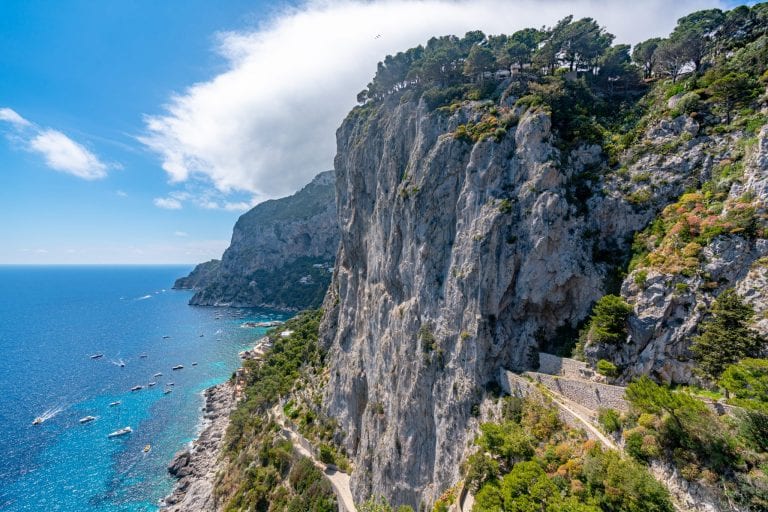
Planning a Trip to Italy: Your Easy 11-Step Checklist
Once you’ve decided to visit Italy, especially for the first time, it’s easy to catch yourself daydreaming daily about sparking blue seas, delicious wine, rolling hills, and ancient cities (and I definitely still do this on a near-constant basis), but successfully planning a trip to Italy requires some not-so-daydream-like steps as well!
From booking transportation to deciding exactly where to go, we’ve outlined all the important steps for planning your Italy trip here.
Use this checklist to ensure that you jet off on your Italian vacation without a single worry!
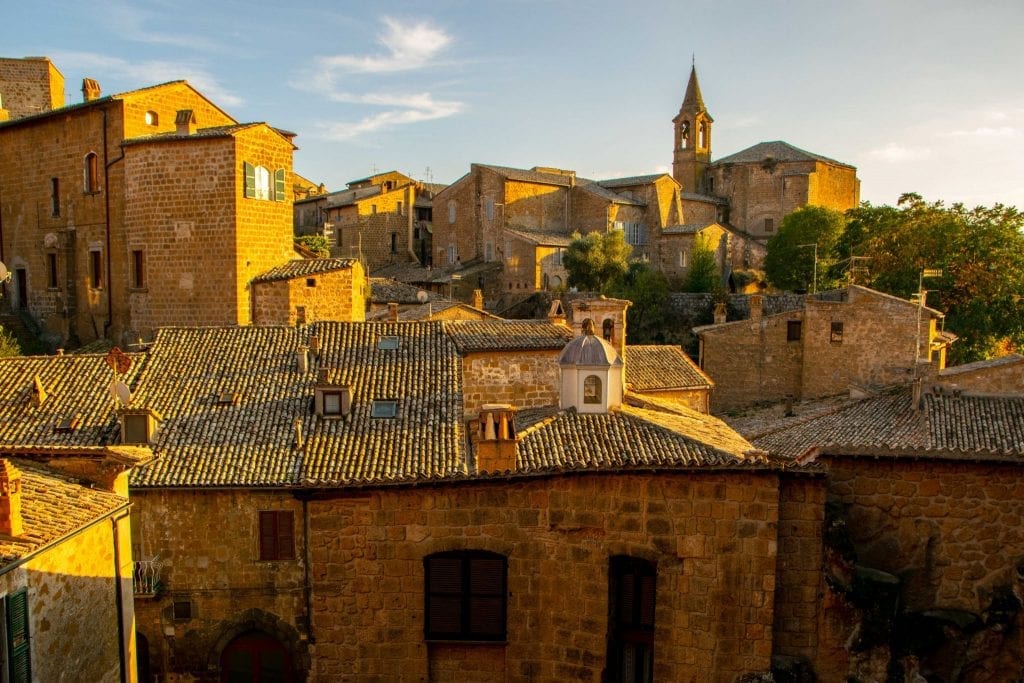
Some links in this post may be affiliate links. If you make a purchase through one of these links, we may earn a small commission at no extra cost to you. Please see our disclosure policy for more detail.
Step 1: Check visa requirements.
Based on the geographic readership of this blog, odds are that the vast majority of you will not need a visa to visit Italy for up to 90 days for tourism purposes.
This includes citizens of the USA, Canada, the UK, Australia, and of course, anyone from an EU member state.
Italy is part of the Schengen Zone, and therefore, anyone who needs a Schengen Visa to visit the area will need one for Italy.
Of course, while I strongly doubt that this policy will change in the near future, you should always confirm visa requirements through official sources before traveling!
Update: Can we all take a moment to collectively laugh at that last sentence? Now more than ever, be sure to regularly check official regulations and track the details of entry requirements! As of this summer, things in Italy are virtually back to “normal”–but be sure to double-check when booking your trip!
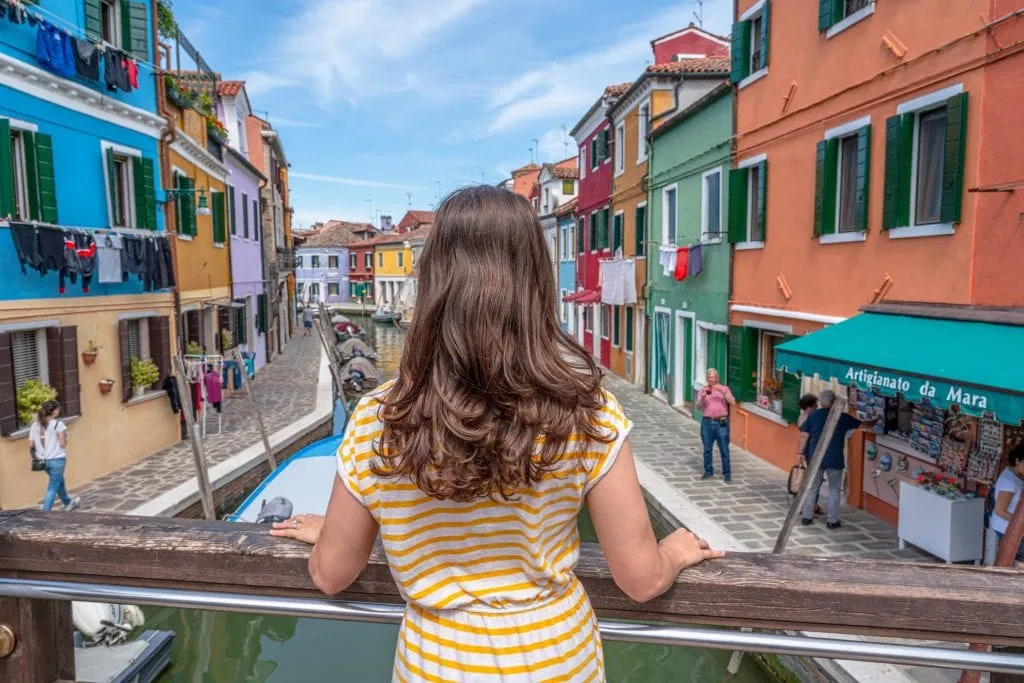
Step 2: Book your trip to Italy!
At this point when planning a trip to Italy, it’s time to make it official and book your tickets to the country!
If you’re flying a long distance or are planning to visit multiple regions in Italy, we recommend being pretty flexible with what airport you fly into in order to get the best flight prices.
Go ahead and check the prices to fly to Rome, Florence, Milan, Venice, and Naples for intercontinental flights.
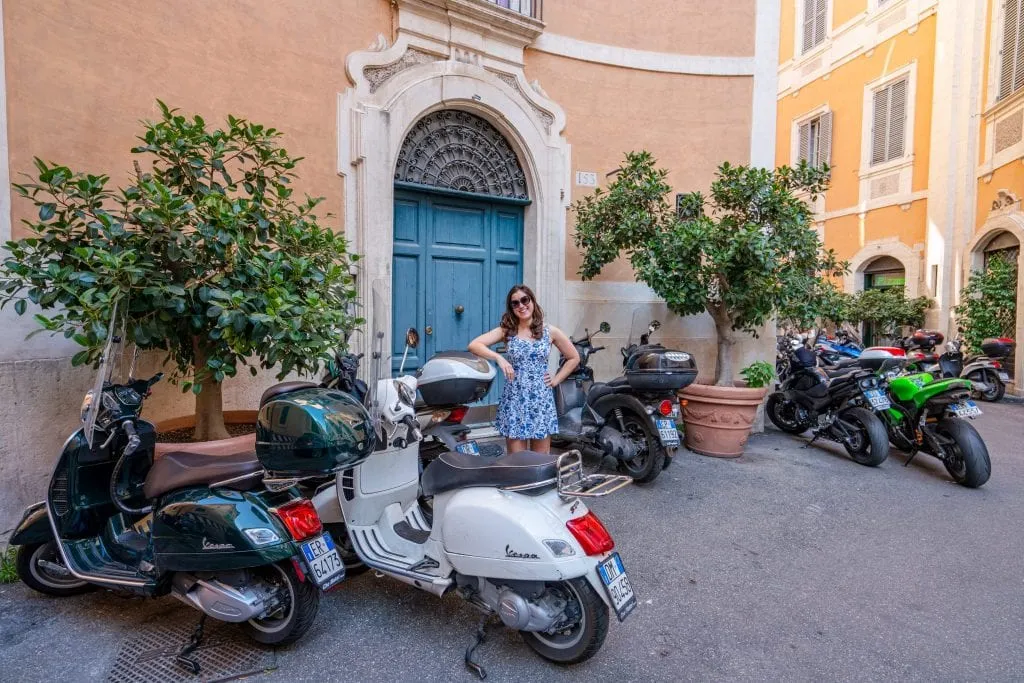
For shorter flights within Europe, those flying on budget airlines should also check Bologna and Pisa, as well as Bari , Palermo , and Catania if you’re headed south.
Also, be open to the idea of flying into one city and out of another!
While this can sometimes be much pricier, other times it’s surprisingly affordable and allows you to spend less of your trip to Italy doubling back to a city you’ve already visited.
We recommend running the numbers both ways.
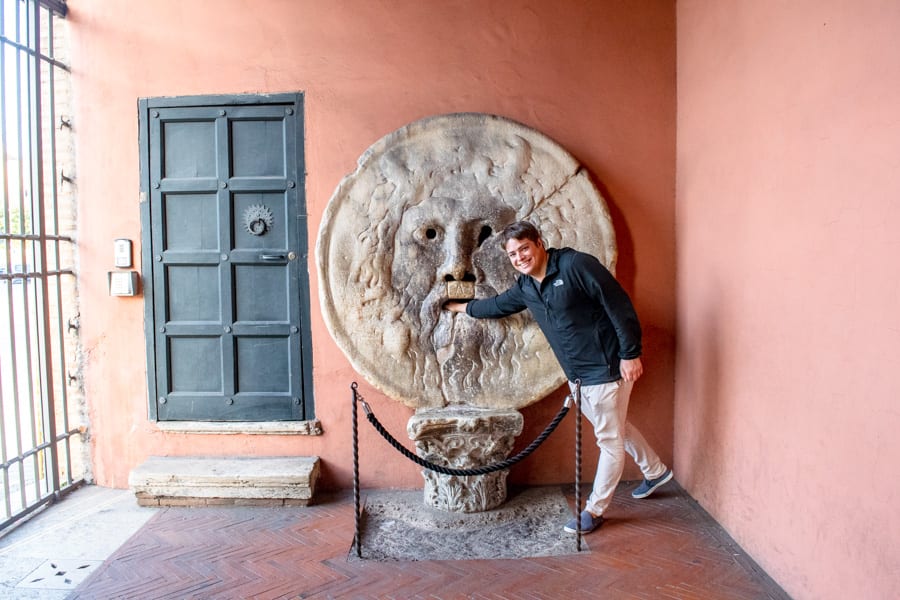
Step 3: Choose your Italy itinerary.
This might be both the most fun and most stressful part of planning a trip to Italy: finalizing where exactly you’re going to go!
We have a recommended 2 week Italy itinerary that we suggest for first-timers to the country, as well as our best suggestions for spending a week in Italy , but ultimately, the sky’s the limit!
If you’re looking for the classic Italy experience, a combination of Rome, Florence, Venice, and Cinque Terre makes an amazing first trip.
If you’re more interested in mountain lakes than idyllic coast line, you could swap Cinque Terre for Lake Como .
If you hope to head south from Rome, Naples , the Amalfi Coast , Pompeii , and Capri are all within close distance of each other and make a great addition to a trip or even a standalone vacation.
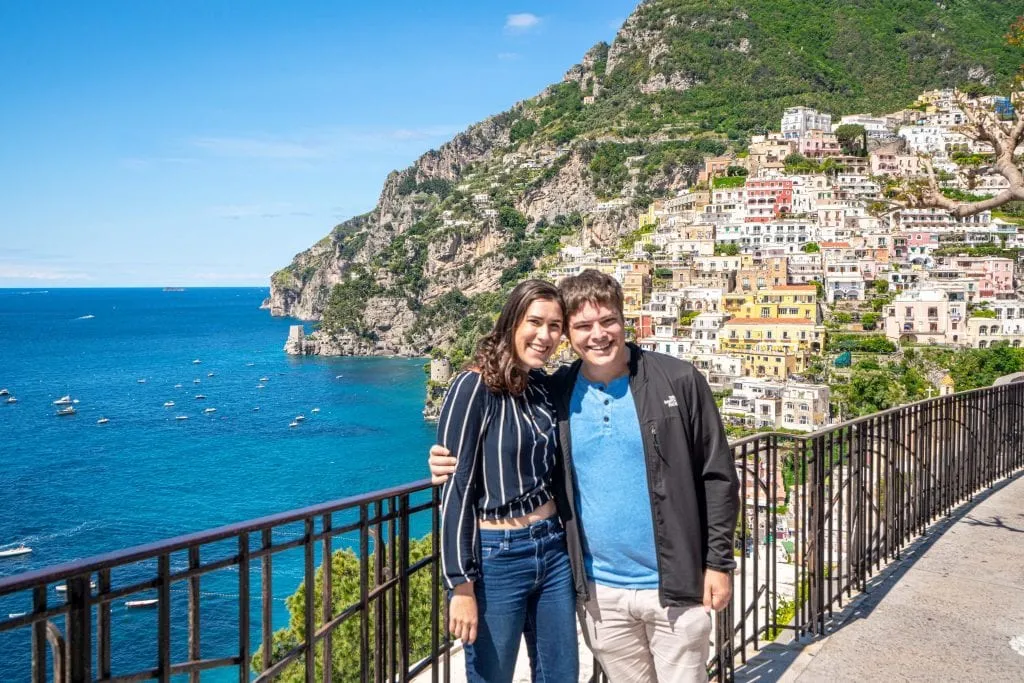
If you’re hoping for mountains, look at Trentino-Alto Adige– Bolzano and Cortina d’Ampezzo are often the launching pads for exploring the Dolomites .
Beach lovers, consider heading to Sicily , Sardinia, or Puglia.
And, of course, foodies can’t go wrong anywhere in Italy–but the regions of Tuscany and Emilia-Romagna in central Italy are sure to captivate your tastebuds.
Interested in roadtripping? Italy is home to some fantastic road trips, though not every area is suited for it.
Here is our guide to the best road trips in Italy , and our suggested Tuscany road trip itinerary !
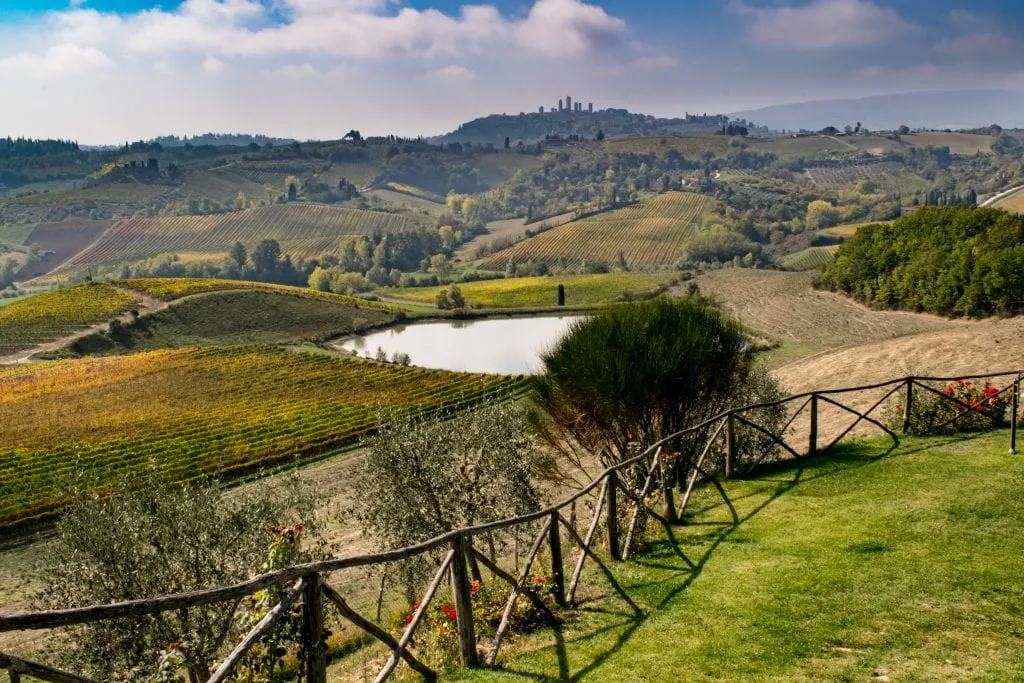
Step 4: Finalize your Italy travel budget.
Now that you know exactly when your trip to Italy is happening and where you are going, it’s time to finalize your Italy travel budget!
We recommend taking the total amount you hope to spend in Italy, subtracting any splurges or major expenses you know are coming (a pricey tour, some clothes shopping, etc), and then dividing the remaining amount by the number of days you’ll be traveling in Italy (we detail this strategy more thoroughly in our travel budgeting guide ).
Presto–you have your daily Italy budget, aka the number you should try to stay under each day when you add up the amount you spend on food, activities, and intra-city transportation.

Step 5: Book some activities in advance.
Here’s the fun part of planning a trip to Italy: booking those iconic experiences you’ve always dreamed of!
While there are plenty of magnificent things to do in Italy that require little to no advance planning, many of Italy’s most iconic attractions are definitely better experienced by planning ahead to take a tour and/or buy a skip-the-line ticket.
We go into far more detail about this on our guides and itineraries for each specific location, but here’s a quick rundown of some of the major sights you’ll want to book ahead of time.
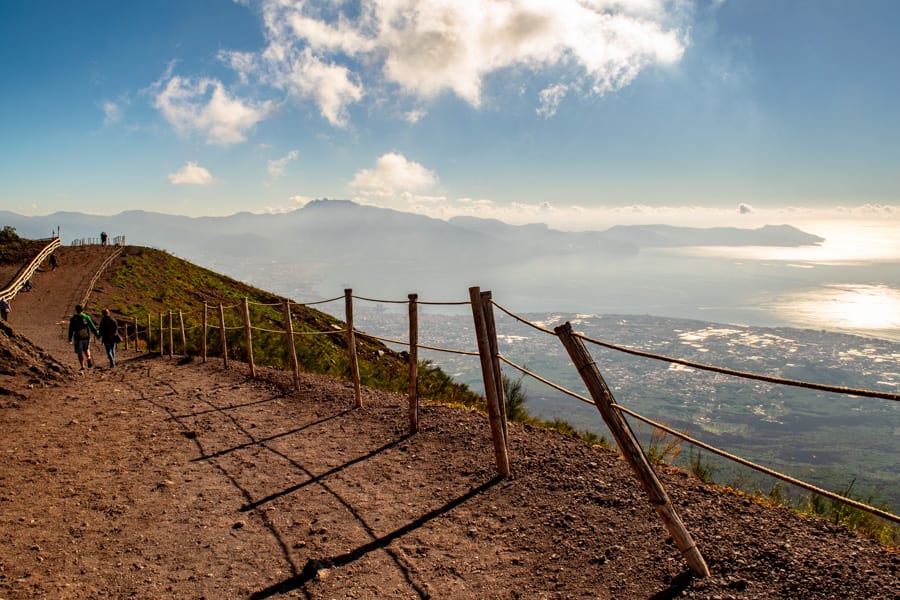
The Colosseum
The vatican museums, florence + tuscany, uffizi gallery, galleria dell’accademia, duomo climb.
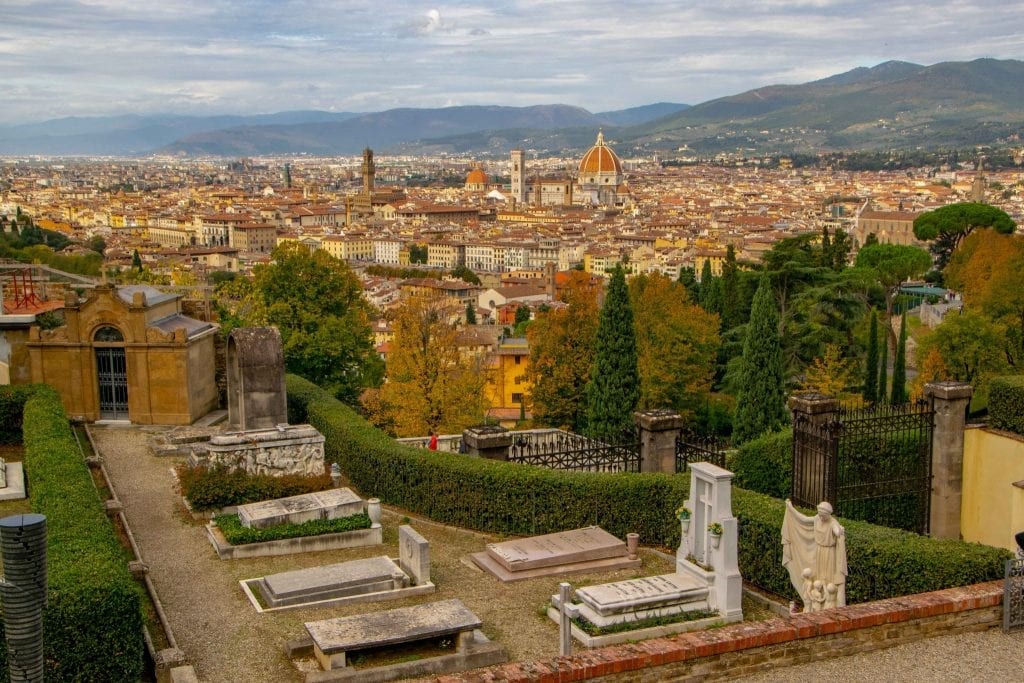
Doge’s Palace + Basilica
Shared gondola ride, pompeii guided tour.
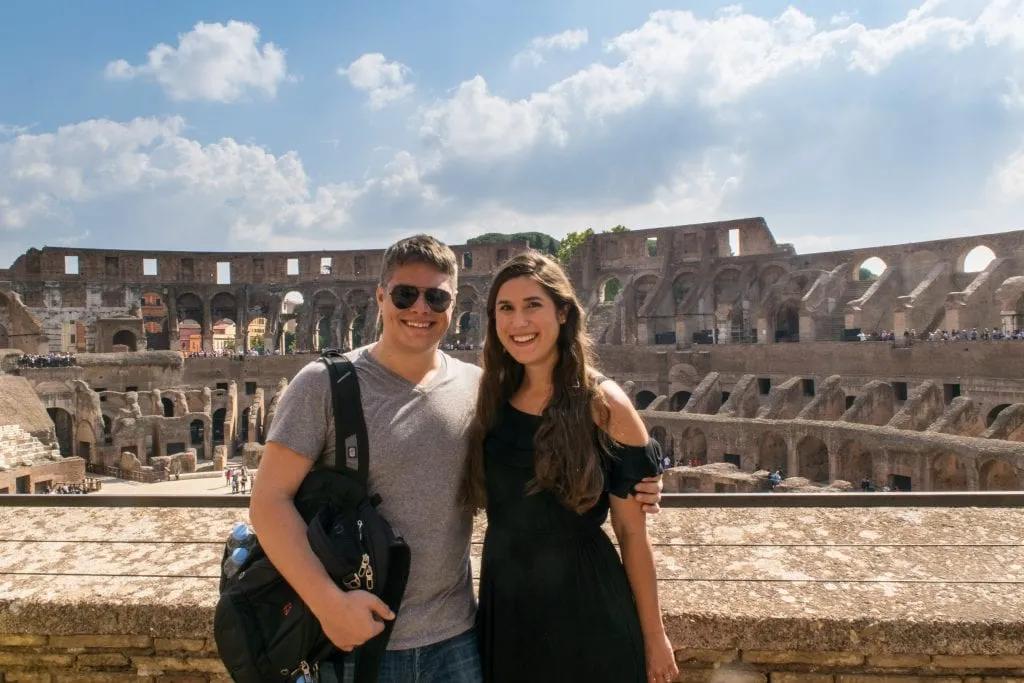
Step 6: Book accommodation.
Next step in planning a trip to Italy: deciding where to sleep!
We offer specific hotel suggestions in our itineraries for each location that we have written about, but here’s the bottom line: in Italy’s major cities like Rome and Venice, it’s fairly easy to find somewhere to stay, so don’t stress about booking months ahead of time unless you have a particular property in mind.
In smaller towns, though–think those along the Amalfi Coast or in Cinque Terre, for example–properties tend to book up a lot faster, and you’ll want to book as far in advance as possible.
We use Booking.com to book hotels and sometimes apartment stays in Italy, and if that doesn’t work out, check out Airbnb for longer apartment stays.
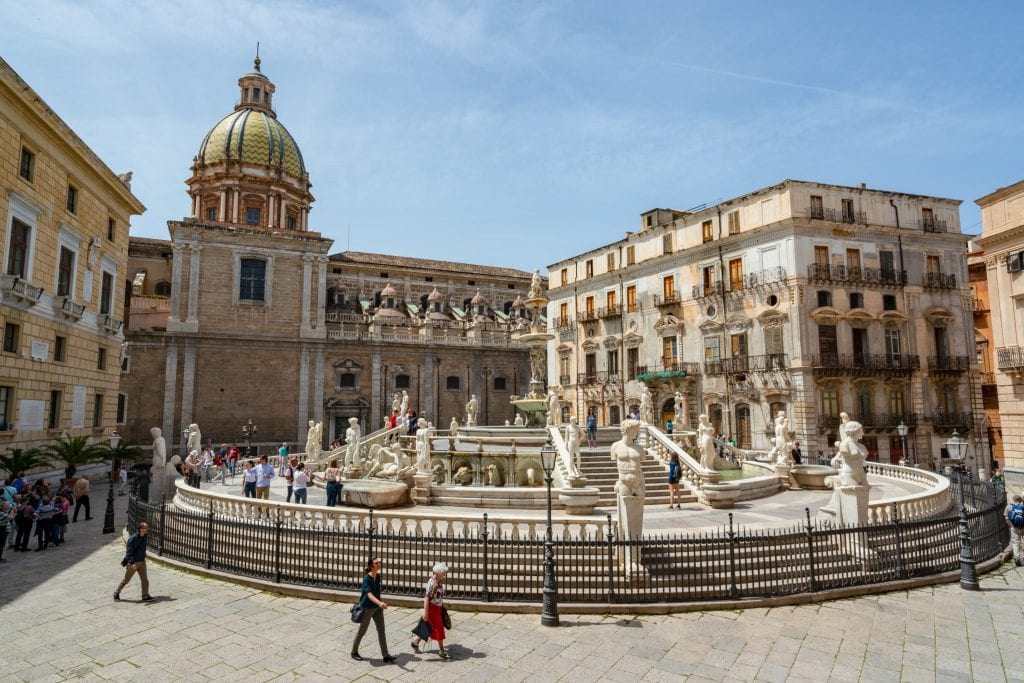
Step 7: Figure out your inter-city transportation.
Now that you know exactly where you want to go, figuring out how to get from destination to destination in Italy–and most importantly, how long it will take and how much it will cost–is the next step in planning an Italy trip.
Note that if you hope to rent a car in the country, you’ll need to obtain an international driving permit before arriving (and double-check that your insurance covers driving in Italy, or purchase a policy that does!).
If you’re planning to take any high-speed trains in Italy, keep in mind that the prices increase as your dates get closer, so book ahead as soon as you’re ready to commit! We use the Trenitalia app to book almost all of our train tickets in Italy.
For regional (aka slow) trains, prices are set and you can just purchase them on the day of travel.
For more on getting around Italy, check out the transportation section of our suggested Italy itinerary.
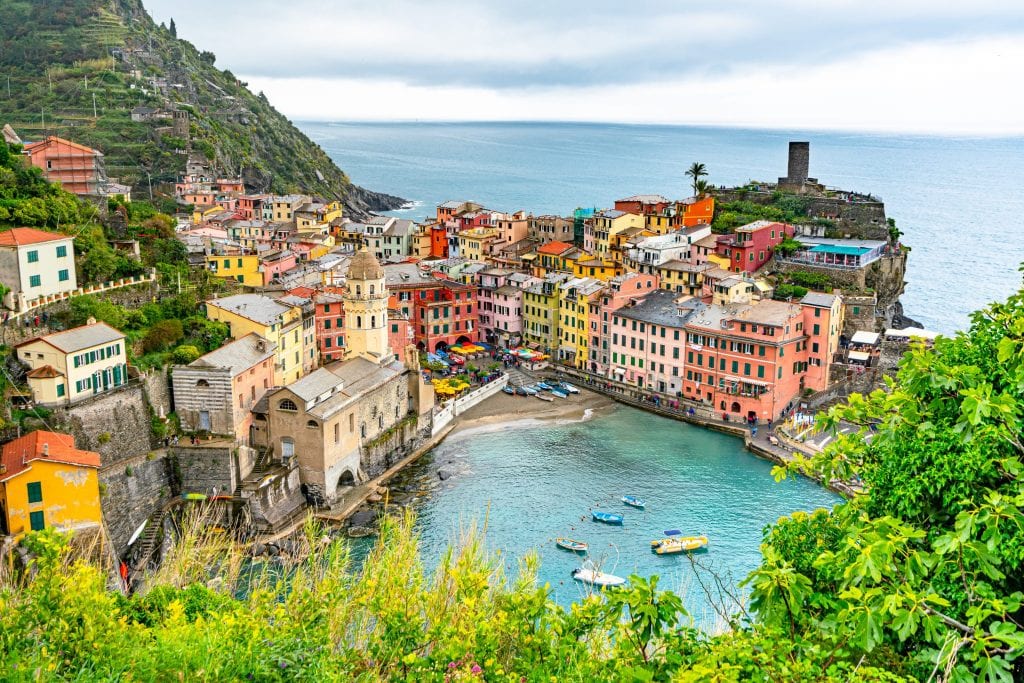
Step 8: Learn a little Italian.
If you’re staying firmly on the tourist trail on your trip to Italy, you won’t necessarily need to speak any Italian to travel there.
… But you will almost certainly encounter some monolingual Italians, and either way, it will definitely enhance your experience in the country to know a tiny bit of Italian.
We personally don’t choose to carry phrase books with us while traveling, but if you like to, Rick Steves’ Italian Phrase Book gets wonderful reviews.
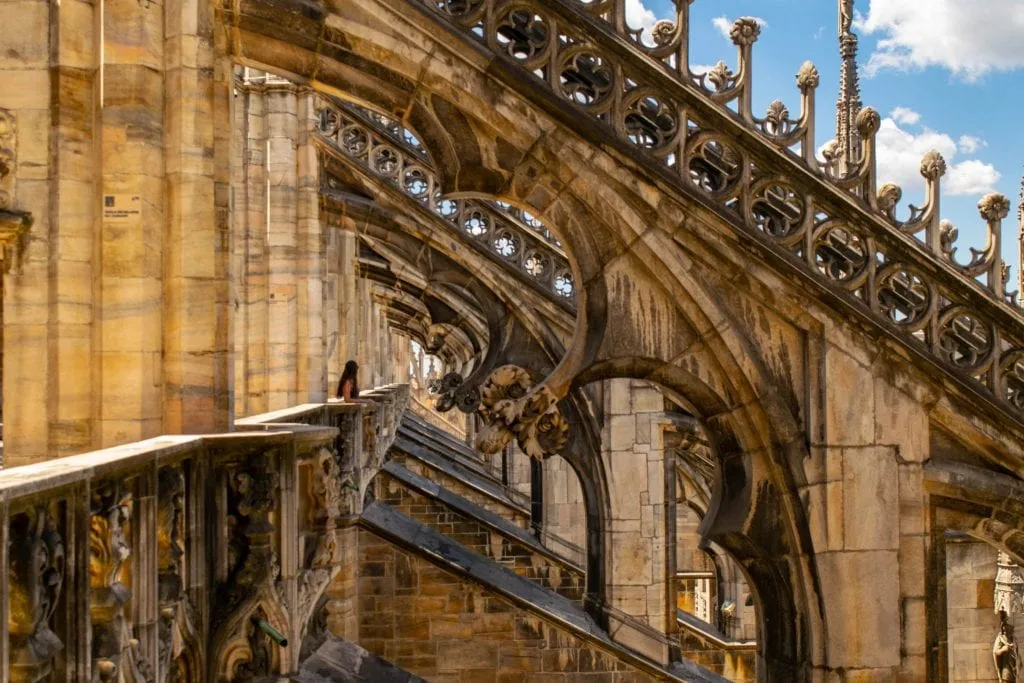
Here are a few phrases to add to your vocabulary when planning a trip to Italy:
Basic Italian Phrases to Learn When Planning a Trip to Italy
Buongiorno. — Good morning.
Buona sera. — Good evening.
Ciao. — Hello/goodbye. (More casual than above.)
Per favore. — Please. (When requesting or accepting something.)
Grazie. — Thank you.
Prego. — You’re welcome, or please. (When offering something–as in, “Please, have a seat.”)
Non capisco. — I don’t understand.
Parla inglese? — Do you speak English?
Il conto. — The check. (In a restaurant.)
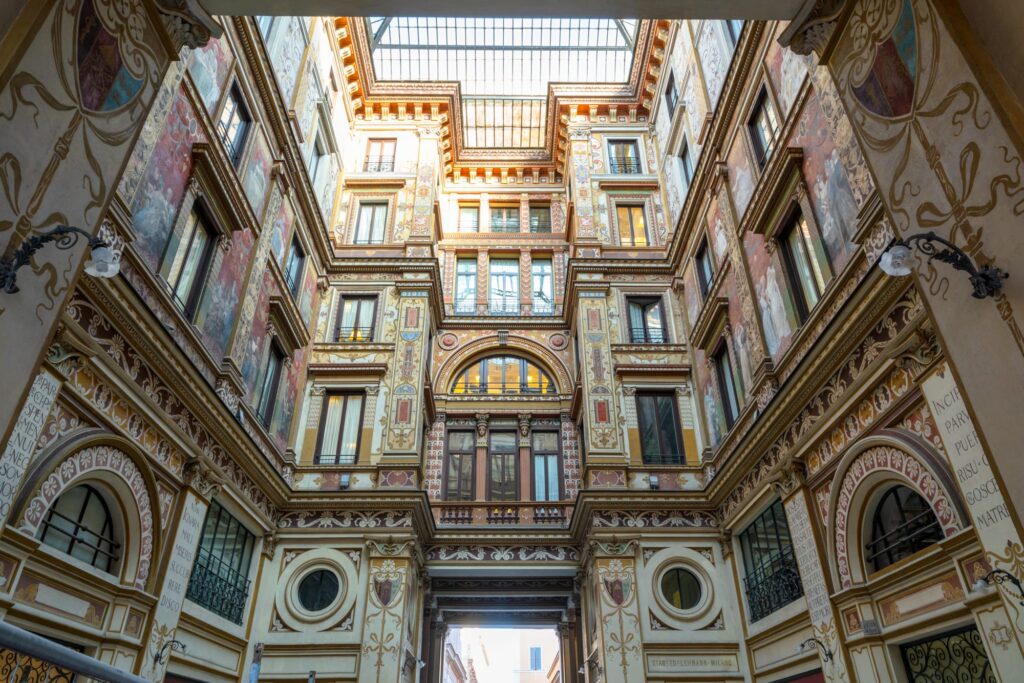
Step 9: Make a packing list (and shop!).
Packing can often be one of the most unexpectedly stressful parts of getting ready for a trip abroad, and Italy is no exception!
You can check out our full suggested Italy packing list here , and our detailed suggestions on what to wear in Rome here (which work for quite a bit of Italy!).
Be sure not to stress too much about packing for Italy, though–just about anything you could possibly forget will be available there too!
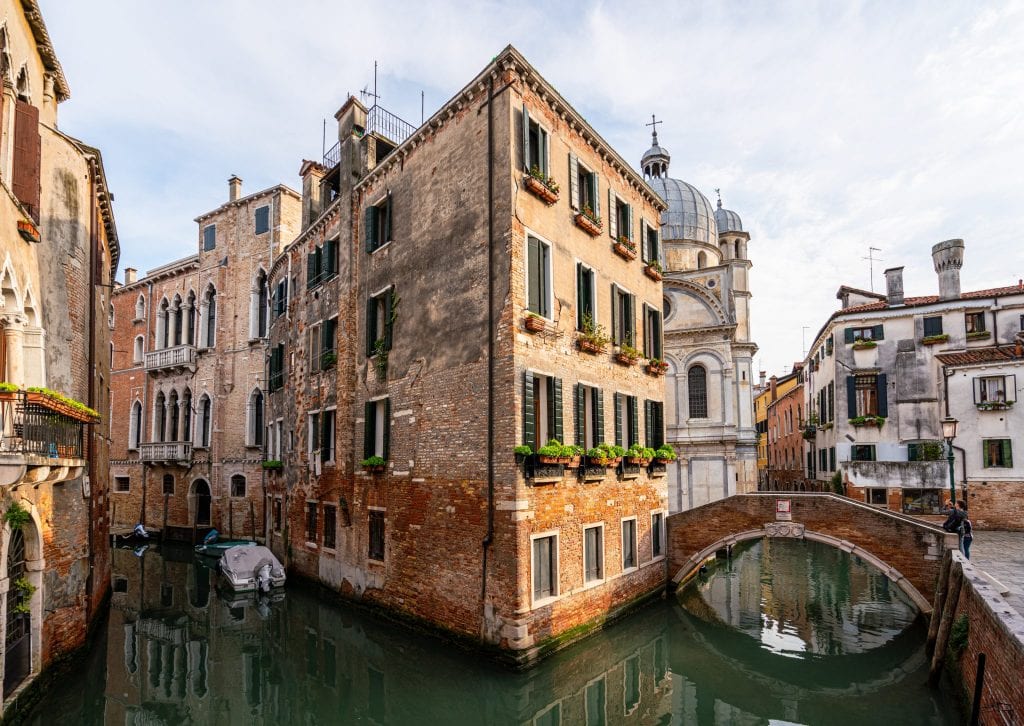
Here are a few essentials to be sure to add to your Italy packing list:
Comfortable Day Bag — We currently use Pacsafe’s sleek anti-theft backpack and love it, but if you don’t want to shell out the cash for this trip, that’s totally understandable.
Just aim for something comfortable to wear, not flashy, and medium-sized–we used a Northface Jester backpack for years and loved it as well.
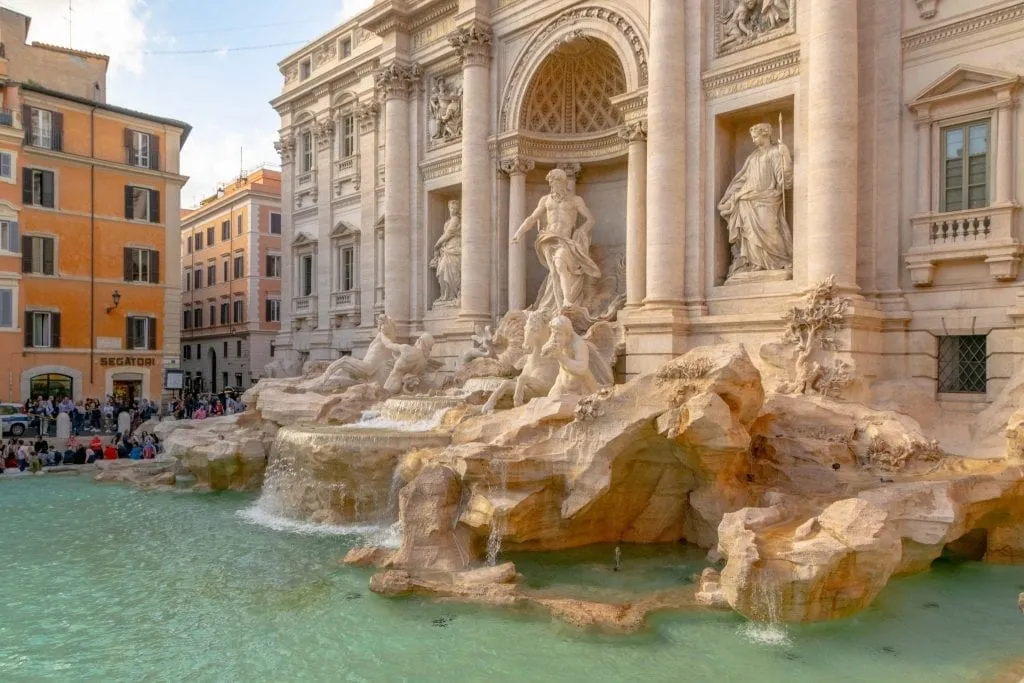
Money Belt — This is up to you: we no longer use one, but if you’re more comfortable having your passports on your person in Italy, you can consider bringing one.
Step 10: Purchase travel insurance.
Don’t forget to purchase travel insurance before jetting off to Italy! While Italy is a perfectly safe country to travel in, traveling in general opens you up to vulnerabilities that you simply don’t have at home: if you miss a plane or train, have your luggage get lost, get pickpocketed, or worse, get injured, you’ll be glad that you have insurance.
Given how inexpensive travel insurance is when purchased in advance (especially as compared to the price of plane tickets to Italy!), it’s well worth the investment.
Check travel insurance policy inclusions and prices for your trip here .
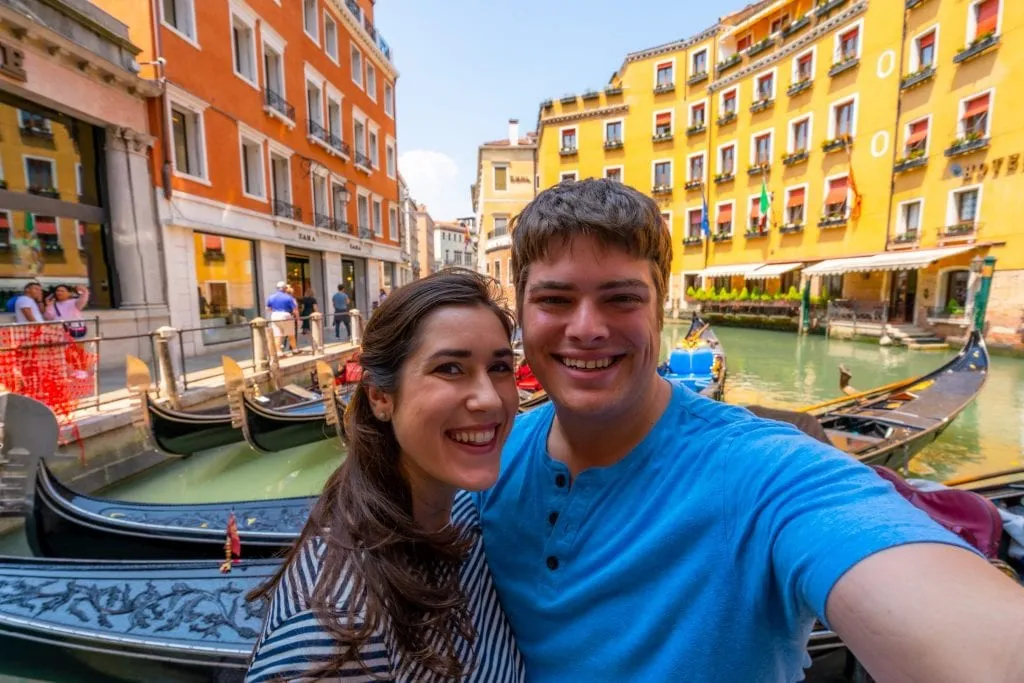
Step 11: Make your arrival plan.
The final step of planning a trip to Italy is as simple as it is important: make an arrival plan.
When you arrive in Italy, you’re undoubtedly going to be exhausted, overwhelmed, and probably a bit jetlagged, too!
No matter how many times we arrive in a new country, it never stops being a tiny bit stressful, simply because there are a lot of variables at play in the first few hours of arriving somewhere new.
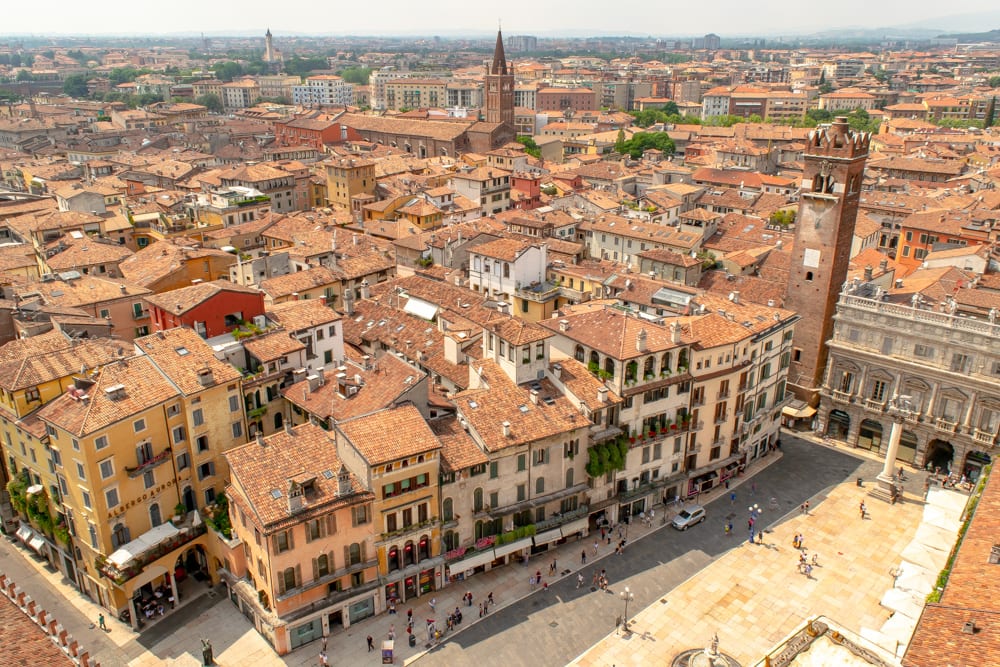
Make life easier on yourself by thinking ahead: when working on your trip to Italy plan, figure out your exact steps of what will happen after the plane lands.
That means exactly how far away your hotel is, how you’ll get there from the airport (train, bus, rental car, taxi?), and if you’ll be traveling by taxi, what a reasonable price is and/or if there’s a set fare from the airport to the city center (in Italy, there often is).
Though it’s not strictly necessary, if you’d like to make arriving in Italy extra-easy for yourself, consider treating yourself to an airport transfer when you arrive!
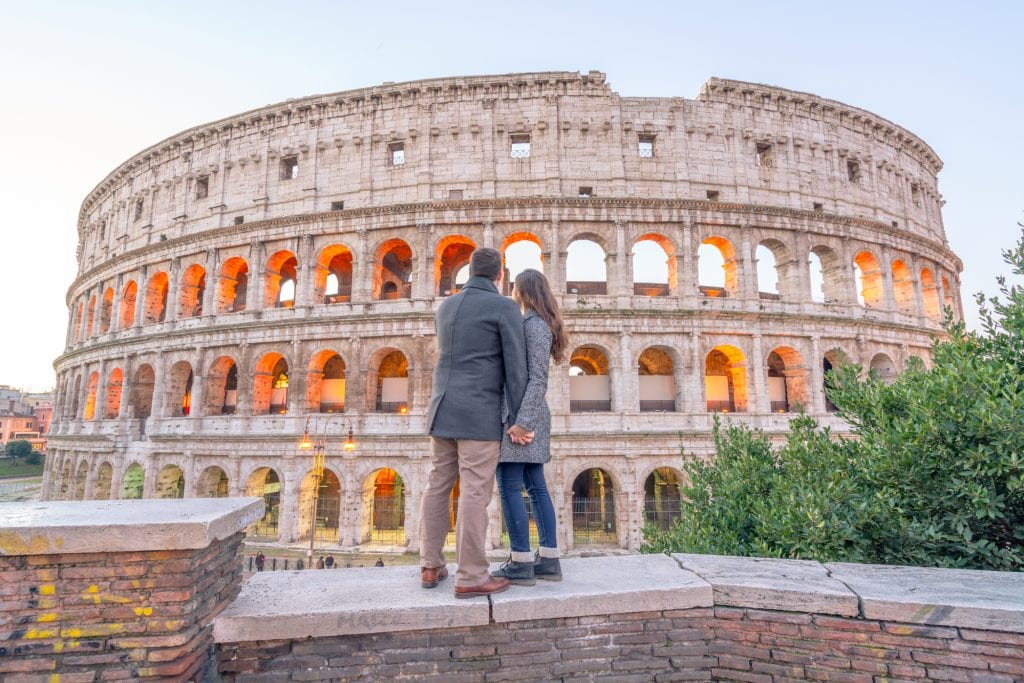
Shuttle Bus from Fiumicino Airport to Roma Termini
(Bear in mind that while this is actually cheaper than taking the Leonardo Express train independently, it does also take longer to get to Rome!)
Private Transfer from Fiumicino Airport to Rome
Private transfer from florence airport to florence, shuttle bus from marco polo airport to venice, shared water taxi from marco polo airport to venice.
[convertkit form=828904]
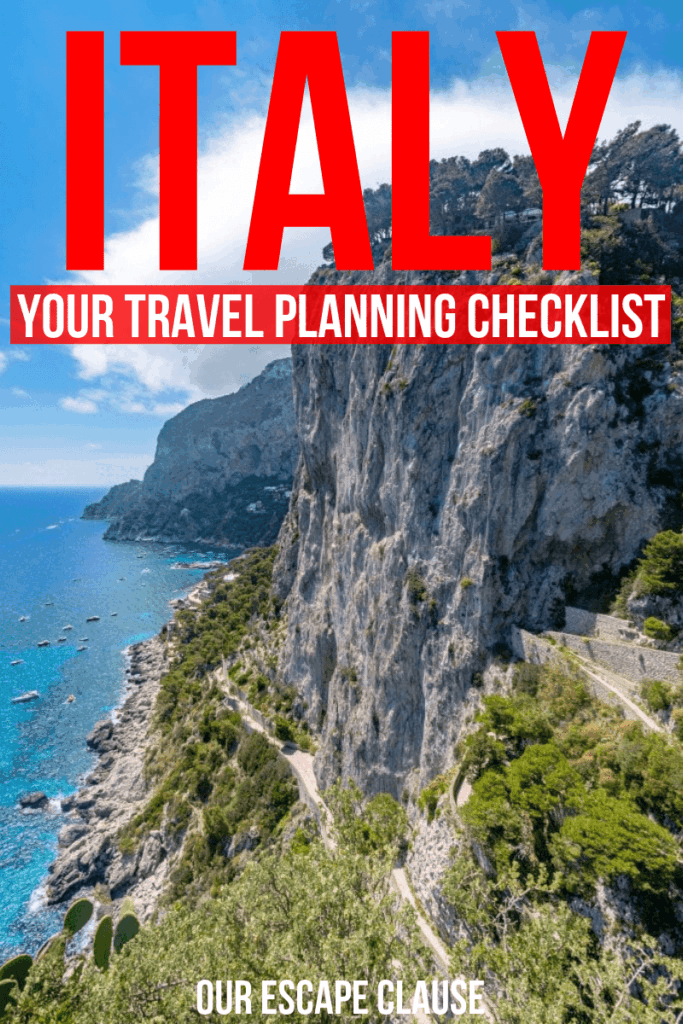
About Kate Storm

In May 2016, I left my suburban life in the USA and became a full-time traveler. Since then, I have visited 50+ countries on 5 continents and lived in Portugal, developing a special love of traveling in Europe (especially Italy) along the way. Today, along with my husband Jeremy and dog Ranger, I’m working toward my eventual goal of splitting my life between Europe and the USA.
11 thoughts on “Planning a Trip to Italy: Your Easy 11-Step Checklist”
This super helpful. Thank you so much!
Thrilled to hear it, thanks Tomeekha!
I am so thankful I found you, Kate! I plan to use your valuable wisdom in planning an extension to a food & wine tour that I booked in 2021. This existing tour ends in Rome. I want to plan a 3-4 night extension along the Amalfi Coast. Congratulations to you, Jeremy & Ranger for living your passion!! I admire your confidence! Best wishes!
Thank you so much, Tammy! I hope you have a wonderful trip and love the Amalfi Coast! 🙂
Wow- amazingly helpful -thank you so very much!!
Happy to help! Hope you guys have a great trip to Italy 🙂
I appreciate your details and encouragement. My husband and I are visiting Sicily for 10 days then off to Cinque Terre for 7 days. I especially appreciate your tips about practicing your landing plan upon arrival Good idea. Also I will be trying the google translate to interpret menus and such things. Thank you
Thanks so much, Cheryl! Sounds like you guys have an incredible trip planned. Enjoy Italy!
Hi Kate, Thank you for the information. It is extremely insightful. Am planning to visit itlay this june with my daughter. We are traveling to attend a family friend’s birthday celebration in Tuscany. My plan thus was to head to Rome first and have planned a 6 days stay, post which we head to Tuscany via train for 5 days. As we have both visited Florence wanted your recommendation on where to next before we head back. Based on your blogs Venice is a must though there are not enough flights out of there so will have to head back to rome to take a flight. Suggestions appreciated.
Sounds like a beautiful trip!
I could easily name a fifty places within a train ride of Florence to add to your trip, but so much will depend on your tastes!
Any of the major cities–including Venice–will allow you to get back to Rome for your return flight fairly easily, so you should be able to structure your itinerary fairly easily there.
Just a few options in addition to Venice, with links to our guides…
Bologna: one of Italy’s best foodie cities and the capital of Emilia-Romagna. It’s a stunner! ( https://www.ourescapeclause.com/things-to-do-in-bologna/ )
Parma: Less visited than Bologna but beautiful and relaxing, Parma is the origin of parmigiano-reggiano and has an incredible cathedral. ( https://www.ourescapeclause.com/best-things-to-do-in-parma-italy/ )
Lucca: A quieter Tuscan city than Florence, Lucca is walled, and also makes a great base for day trips in Tuscany and even Liguria. ( https://www.ourescapeclause.com/things-to-do-in-lucca-italy/ )
Verona: The city of Romeo and Juliet, Verona is set on a river and is crisp, beautiful, and interesting! ( https://www.ourescapeclause.com/things-to-do-in-verona/ )
Bolzano: Located in far northern Italy, Bolzano has one of the most unique museums in Europe and is perfect for accessing the Dolomites. ( https://www.ourescapeclause.com/things-to-do-in-bolzano-italy/ )
That’s truly just a handful of an endless array of options, but you can’t go wrong with any of them!
Leave a Comment Cancel reply

Navigate forward to interact with the calendar and select a date. Press the question mark key to get the keyboard shortcuts for changing dates.
Navigate backward to interact with the calendar and select a date. Press the question mark key to get the keyboard shortcuts for changing dates.
Italy Trip Planner
Top destinations in italy.

Top attractions in Italy

Other notable attractions

Explore nearby places
- La Massimina-Casal Lumbroso
- Rocca Santo Stefano
- Cerreto Laziale
- Isola Farnese
- Torrimpietra
- Casal Palocco
- Ostia Antica
- Tragliatella
- Castel Romano
- Fonte Nuova
- Lido di Ostia
- Anguillara Sabazia
All related maps of Italy
- Map of Italy
- Map of La Massimina-Casal Lumbroso
- Map of Rocca Santo Stefano
- Map of Ladispoli
- Map of Rome
- Map of Cerreto Laziale
- Map of Gorga
- Map of Isola Farnese
- Map of Acilia
- Map of Torrimpietra
- Map of Maccarese
- Map of Casal Palocco
- Map of Fregene
- Map of Ostia Antica
- Map of Roiate
- Map of Tragliatella
- Map of Palidoro
- Map of Focene
- Map of Infernetto
- Map of Aranova
- Map of Cesano
- Map of Ciampino
- Map of Formello
- Map of Torre Gaia
- Map of Castel Romano
- Map of Fiumicino
- Map of Fonte Nuova
- Map of Lido di Ostia
- Map of Sacrofano
- Map of Anguillara Sabazia
- Map of Riano
Italy throughout the year
- Italy in January
- Italy in February
- Italy in March
- Italy in April
- Italy in May
- Italy in June
- Italy in July
- Italy in August
- Italy in September
- Italy in October
- Italy in November
- Italy in December
Q&A about Italy
Add places from guides with 1 click, collaborate with friends in real time, import flight and hotel reservations, expense tracking and splitting, checklists for anything, get personalized suggestions.
4.9 on App Store, 4.7 on Google Play
- Work with us
- Favorite travel blogs
- netherlands
- switzerland
- family travel
- food and wine
- trip planning resources
- accommodation guides
- travel gear guides
- itineraries
- packing guides
- travel gifts
- health and safety
How to plan a trip to Italy – a step by step guide
This article may contain compensated links. See our full disclosure here
Welcome! My name is Katy and ever since I first visited 20 years ago I have been plotting my next trip to Italy. From its historic cities to the mountains, lakes and coast, I fell in love with this beautiful country and want to help you do the same.
Planning a trip to Italy is one of my favorite things to do (I’ve been there more than 25 times!) so we created this guide to help you plan and book your trip with ease. We hope you find our step by step guide on how to plan a trip to Italy useful.
What's in this article
When to go to Italy
Passports and visas, itineraries and planning, travel booking timelines, accommodation in italy, tickets, tours and attractions, airport and ground transfers, money and budget, internet access, travel insurance, packing for your trip, travel with kids in italy, italy trip planning done.
The best time to visit Italy is when it suits you and your schedule. However, you should be aware of a few seasonal variations:
- Italy is one of the world’s most popular destinations and is very busy (and more expensive) at peak periods – from May to September
- Summers can be very hot (especially in the south) and winters cold with ski resorts open in the northern alpine regions
- August is the busiest month with Italians and people from all over Europe on vacation. Coastal and lake areas are very busy with visitors
- Easter is a major holiday in Italy – expect demand for rail travel and accommodation to increase
For this reason we like to visit Italy in the shoulder months – April/May and September/October when the weather is sunny and mild, crowds are manageable and you can find great value flight and accommodation deals.
How to get there
Flying direct (or with a single stop) to Italy from most places in the world is easy. Most visitors fly into Rome Fiumicino [Leonardo da Vinci](FCO) international airport but you can also easily fly into Milan Malpensa (MXP) or Venice Marco Polo (VCE) airports from major hubs around the world.
There are many other airports throughout the country that can be accessed within Italy and Europe.
FREE ITALY TRIP PLANNING CHECKLIST: CLICK HERE TO GET YOURS. NOW
Best flight deals to Italy
We use a combination of Skyscanner , CheapoAir and Google flights to source the best flight deals for Italy.
- Skyscanner – portal where you can view cheapest days and routes to fly and set alerts for price drops
- CheapoAir – uncovers the best deals on first class flights around the world
- Google flights – great for checking schedules and airline routes
To find the best deals, set up alerts on Skyscanner for the month you wish to travel and wait for price drops. Be prepared to be a little flexible on dates and stopovers. It is often cheaper to fly into Milan rather than Rome but that is most useful for northern Italy itineraries.
Tip – always use an incognito browser window to search for flight deals. Prices are amended up for users known to be searching for specific dates and times
Arriving by train from other cities in Europe
If you are traveling within Europe, train travel is easy with links to major Italian cities – Milan, Rome, Florence and Venice – from other capitals in Europe. Read our guide to train travel in Italy or Seat 61 is another great resource for planning train travel within Europe.
Bus travel to Italy
If you’re on a tight budget and traveling within Europe, then you might want to consider coming to Italy by bus. Low cost operator Flixbus covers 1,200 destinations in 26 countries.
Train and bus bookings
Omio is a useful site for booking a combination of train, bus and air travel within Europe
READ: Best booking sites for travel to Italy
Citizens of the United States, Australia, Canada and New Zealand can enter Italy and stay up to 90 days without a visa within an 180 day period. You must have 6 months validity on your passport.
All other nationalities should check this Italian government site that will walk you through whether a visa is required for your visit.
European Union and UK citizens can travel with photo identification.
Please note – this information is subject to change and it is always best to check with your local foreign office for the latest advice on travel to Italy.
- United States – click here
- Australia – click here
- United Kingdom – click here
- Canada – click here
Where to go
Probably the hardest decision you need to make is which places you would like to visit. This is a very difficult task for many of us and it is a challenge for me to this day.
The most popular places to visit in Italy are listed below.
- Major cities – Rome, Florence, Venice, Milan and Naples
- Tuscany – large region known for hilltop towns, wineries and beautiful countryside
- Cinque Terre – 5 spectacular villages that hug the sides of cliffs on the Italian Riviera
- Amalfi Coast – picturesque coastal region near Naples – Sorrento, Positano, Capri
- Northern Italian lakes – scenic lakes close to alpine mountain ranges
As a general rule, for a 3-5 day trip choose one destination – a city or area. If you have a week to 10 days then 1-3 places in either the north OR south of Italy. For a 2 week trip you could cover 3-4 places and see both north and south.
Try not to pack too much in. It’s easy to underestimate transit times and getting in and out of airports and train stations.
Suggested itineraries
Planning your Italy itinerary is one of the most important job in the trip planning process. For their first trip to Italy, many people will choose to start their journey in Rome and visit Florence and Venice. This 10 day Italy itinerary covers that route and includes detailed instructions on how to make the most of your time in Italy.
Alternative 10 day itineraries
- Rome + Amalfi Coast – Rome [4 nights], Amalfi Coast/Naples/Pompeii/Capri [5 nights]
- Rome + Florence and Tuscany – Rome [4 nights], Florence [3 nights], Siena [2 nights]
- Venice, Milan, Lake Como + Florence – Venice [3 nights], Milan [1 night], Lake Como [2 nights], Florence [2 nights]
- READ: Sample Northern and Southern Italy itineraries
- Sicily – deserves 2 weeks! – click for highlights and hidden gems
City itineraries
Rome – a 5 day itinerary that can be adapted for more or less days – click here to read Florence – suggestions for 1,2 and 3 days in the Renaissance city – click to read Venice – things to do and itineraries for 1,2 or 3 days in the lagoon city – read here Milan – explore Milan, fashion forward, fun and the most modern of all the Italian cities – click to read
Recommended group package tours in Italy
Package tours of Italy can be a fantastic way to avoid the stress of planning your own trip. They are also great if you would like some company along the way. Here is a quick summary of popular tours in Italy by well known brands.
One of the most popular tour companies on the planet, Trafalgar has a broad range of itineraries to choose from in Italy. Appealing to the 50+ age group, travel is mainly by coach and you can expect an emphasis on culture and history. Trafalgar has worked hard to include local experiences such as wine tastings and unique stays into its itineraries as well as time to discover destinations at leisure.
Tour group sizes are between 40-45 passengers and the general standard of hotels is 4 star.
Top Italy tours by Trafalgar
- Best of Italy – 13 day itinerary visiting Rome, Sorrento, Florence, Venice and more – more information
- Great Italian cities – classic itinerary covering Rome, Florence and Venice in 10 days – click for details
- Best of the Italian lakes – Como, Maggiore, Garda – which will be your favorite? – click here for details
Intrepid Travel
We like the tours offered by Intrepid Travel because they strike the balance between showing you highlights of a destination and allowing time for exploration on your own. Their premium brand Peregrine has some interesting hiking tours of the Cinque Terre and Amalfi Coast.
Group sizes average around 10 so you get personal attention when you need it. We also love that Intrepid has a commitment to responsible travel and leads the way in promoting animal welfare.
Top tours of Italy by Intrepid and Peregrine
- Best of Italy – 15 days covering Rome, Florence, Venice, Cinque Terre and more – click here for details
- Cinque Terre walking tour – 8 days walking the spectacular coastal villages – more information
- Italy real food adventure – 8 days of feasting in Venice, Tuscany and Rome – more details
Even as independent travelers we like to browse Tourradar – a market place for tours where you can browse hundreds of package tours by different operators, and by date. Then filter by your interests and age group and read detailed reviews.
There are various levels of support offered from fully organized tours to independent self drive or train itineraries.
BROWSE: All Italy tours on Tourradar
Top tours in Italy found on Tourradar
- Highlights of Italy – 8 day train tour through Milan, Venice, Florence, Pisa, Rome – click for more info
- 3 Nights Venice, 2 Nights Florence & 5 Nights Rome – a self guided tour – click here for details
- Self guided walking tour of Tuscany – 8 days of fresh air, wine and views – click here for details
Recommended guidebooks
We plan trips using a wide variety of sources. If you can, choose an Italy travel guide that is relevant for the region you are visiting as they are usually more detailed and useful.
Our favourite general guidebooks for Italy are:
Lonely Planet – Our favorite practical guide, Lonely Planet, regularly updates guides for Italy | Florence and Tuscany | Venice and the Veneto | Naples, Pompeii and the Amalfi Coast | Italian Lakes | Sicily | Southern Italy
Rick Steves – America’s foremost authority on travel in Europe produces excellent practical guides and itineraries for Italy | Rome | Florence | Venice | Cinque Terre
DK Eyewitness Guides – we love the illustrations and cultural and historical insight in these guides. They are perfect for those of us who respond best to visual cues.
When should you book your travel, accommodation and tours in Italy?
As soon as possible is the straightforward answer when it comes to popular hotels, accommodation and tours especially for peak times in July and August. If you can, try to book 6-12 months in advance for popular areas such as the Amalfi Coast in summer.
Flight bookings will depend on where you are flying from. For long haul flights the best deals are generally found 6-12 months in advance while deals pop up regularly for travel within Europe.
Rail bookings can be made up to 4 months in advance on high speed intercity and standard intercity trains.
FREE ITALY TRIP PLANNING CHECKLIST: CLICK HERE TO GET YOURS NOW
Choosing where to stay is an important part of planning your itinerary. Italy is well set up for tourists and you can expect the usual range of hotels and bed and breakfast accommodation as well as apartments and villas.
If you plan to spend any time in the country, consider staying at an agriturismo or farm stay – offered by Italian farmers who earn additional income by providing rooms and meals. This accommodation is very popular in Italy and ranges from budget to luxurious.
We’ve stayed in agriturismi (plural) with swimming pools, hammams and wine cellars and always try to build them into our itinerary. An added bonus is that the food served is farm fresh and generally excellent.
Accommodation costs
Here is a rough guide to help you plan your accommodation budget. Prices are average for a double room though this will vary with prices higher in popular areas at peak times
Upscale / Luxury – €200+ [USD $230+] per night Midrange / Boutique – €110-250 [USD $125-285] per night Budget / B&B – €60-120 [USD $70-140] per night Ultra budget / Hostel or shared room in AirBnB – €20-35 [USD $25-40] per night
Best accommodation sites
Our favorite site for booking lodging is Booking.com because it has a huge range of options from hotels and resorts to bed and breakfast, apartments and farm stay accommodation.
You can easily compare prices and amenities and take advantage of their generous cancelation policies to find the right accommodation for you. We’ve also found their concierge service helpful and get better deals because we use them regularly.
Other sites we use and recommend
- Plum Guide – visits and reviews the best Airbnb properties and provides detailed information on each one. Get 5% off with code – UNTOLD5
- VRBO – the best site for long stay villas and apartments – click here to browse VRBO
- AirBnB – for longer stays in apartments and villas – first time users can claim free credit here
- Tripadvisor – mainly to read reviews but you can sometimes find good deals on there too
Our guides on where to stay in Italy
We created these guides with specific recommendations of where to stay in the major tourist areas in Italy in response to questions from our readers and in our Italy Travel Planning Facebook Group .
- Florence – district and accommodation guide > click here
- Milan – district and accommodation guide > click here
- Amalfi Coast – towns and accommodation guide > click here
- Rome – accommodation near the Pantheon > click here ; near the Colosseum > click here and in Trastevere > click here ; accommodation near the Vatican City > click here
- Venice – coming soon
We also created a guide on how to find the right accommodation for your trip that includes a printable checklist > click here to access the article.
How to get around Italy
As a general rule, if you are traveling between cities and major towns then the best way to travel around Italy is by train. If you want to explore the countryside and small villages you will need to rent a car.
When you are mapping out distances to travel between destinations use Google maps or Rome2Rio is another useful site.
Train travel in Italy
The train system in Italy is modern and efficient with fast speed services linking the major cities and regional trains connecting smaller towns and villages. Two major train networks operate throughout Italy – Italo and TrenItalia .
Advance bookings are advised for high speed intercity services where seats are allocated. You can save money booking in advance if you purchase non-flexible tickets. You can book directly with these operators or an easier way is with:
Omio and Trainline compare train times and prices across both Trenitalia and Italo schedules and keep your ticket details on their handy app
SEARCH: rail tickets on Omio
High speed train intercity travel times on popular routes
- Rome to Florence – 1 hour 30 minutes
- Rome to Naples – 1 hour 15 minutes
- Rome to Milan – 3 hours
- Rome to Venice – 4 hours
- Florence to Venice – 2 hours
- Florence to Milan – 2 hours
READ: Guide to buying train tickets in Italy
Driving in Italy
With a bit of forward planning and common sense, renting a car and exploring the back roads of Italy is easy. We wrote a full guide to driving in Italy but here are our top tips:
- You are required to carry an International Drivers Permit – these can be arranged in your home country at minimal cost
- Standard transmission on cars is manual or stick shift. If you want to rent an automatic car expect to pay extra, if you can find one available
- Rent the smallest car you can to fit you and your luggage – roads are often narrow and you don’t want to get stuck!
- Heavy fines apply if you enter ZTL zones – historic districts where driving is not allowed
We use Car Rental by Booking.com to find the best car rental deals in Italy including one way options. They search both international and local providers so you get a wide variety of choice and there is 24/7 support if you need it.
SEARCH: car rental in Italy with Car Rental by Booking.com .
Internal flights
If you want to travel very long distances or to visit the islands of Sicily or Sardinia, flying makes the most sense.
Check on Skyscanner or Google Flights for routes and prices. Remember to set alerts for those routes you want to fly and book early for flights in the summer months.
We source and book tickets and tours via GetYourGuide and Viator . They are tour and ticket aggregators so there is lots to choose from. I like the fact you can read reviews, book everything in the one place and keep your tickets and vouchers on their apps too. You can also pay in your own currency and with international credit cards which can be a challenge when using Italian websites.
We prefer GetYourGuide – you can read our review of GetYourGuide to find out why here
Tickets for major attractions
Rome, Florence and Venice are some of the busiest cities for tourists in the world thanks to their famous attractions – the Colosseum, Vatican Museums, Uffizi Gallery and Doge’s Palace.
We have given you the official booking sites and an alternative for approved ticket partners should you have trouble using the official site – unfortunately that happens a lot! The direct sites are usually cheaper but the partner sites are generally more user friendly.
- Colosseum – official ticket site OR buy Colosseum tickets on Get Your Guide
- Vatican Museums – official ticket site OR buy Vatican Museum tickets on Get Your Guide
- Omnia pass – Colosseum + Vatican + one other museum + hop on, hop off bus – click here for details
- Uffizi Gallery – official ticket site OR buy Uffizi tickets on Get Your Guide
- ‘David’ statue [Accademia Gallery] – official ticket site OR buy Accademia tickets on Get Your Guide
- Doge’s Palace – official ticket site OR buy Doge’s palace tickets on Get Your Guide
- San Marco basilica – official skip the line tickets OR buy a tour of San Marco including tickets on Get Your Guide
- ‘Last Supper’ painting – official ticket site OR buy Last Supper tickets on Get Your Guide
- Duomo rooftop – official ticket site OR buy Duomo tickets on Get Your Guide
Day tours in Italy
We love doing guided tours . Not those huge group ones where you follow the flag waving guide around in a herd trying to keep up. No, we especially like small group and food tours where you learn and discover all about the culture and history of the places we visit. Plus it’s so much more fun than reading plaques and you get to ask questions.
So make sure to build in a couple of tours when you are planning a trip to Italy.
Our favorite small group tour companies are Take Walks (formerly Walks of Italy) and Liv Tours . Both offer very well designed and engaging tours of the major sights in Italy as well as interesting food and cultural tours.
- Take Walks have a longstanding reputation for excellent service, groups under 20 people and guaranteed departures. So if you are the only person booked on a tour it will still go ahead. We recently enjoyed our Colosseum at night tour and day trip to Tuscany with them
- We highly recommend the fun team at Liv Tours . They offer interesting very small group (6 people or less) and private tours throughout Italy including late and early entry to the Colosseum and Vatican. Get 5% off their tours with code – UNTOLDITALY
Other Recommended Day Tours by destination
- Rome in day – tour includes Vatican and Colosseum – great if you have limited time > click for details
- Colosseum virtual reality tour – brings the arena to life with 3D effects and sound > more information
- Rome by night – discover the beauty of the Eternal City after dark on this 2 hour tour > click for details
- Vespa tour – pretend you’re Audrey Hepburn in Roman Holiday on this vintage vespa tour > more details
READ: Our guide to the best day tours in Rome
- Uffizi Gallery + Palazzo Vecchio – 3 hour combined tour of the city’s must see sights > more information
- Florence Dome Climb – climb the famous dome for spectacular views of Florence > more details
- A day in Tuscany – full day tour to San Gimignano and Siena from Florence > click for more info
READ: Our guide to the best day trips from Florence
- Doge’s Palace and Basilica tour – 2 hour tour of the major attractions in Venice > more information
- Burano, Murano and Torcello – half day outer islands of the lagoon escorted tour > click for details
- Street food tour – discover Venetian cicchetti and visit the famous Rialto market > click for details
Naples, Sorrento and Amalfi Coast
- Boat trip from Sorrento to Capri – one of the highlights of my life! Full day tour > click for details
- Pompeii and Amalfi Coast tour from Naples – full day tour if you are short on time > more info
- Amalfi Coast – small group tour to Positano, Amalfi and Ravello from Sorrento > more information
READ: How to take a boat tour to magical Capri
Recommended experiences in Italy
Sightseeing, soaking up the atmosphere and visiting major monuments (plus eating!) will take up most of your time on your trip to Italy. However, if you have a little more time, we recommend seeking out unique Italian experiences that are sure to be the highlight of your trip.
Food festivals are so much fun. We stumbled on a sagra (food festival) near Lake Como and had a great time tasting all the local dishes. On another trip we managed to be in Florence during the finale of the Gelato Festival (how did that happen I wonder?) and were able to taste some incredible flavours.
You can check this site for information on food festival dates in Italy.
Wine tastings and tours are popular activities in Tuscany and there is a great selection to choose from on Viator – click here to view
If you want to recreate the delicious dishes you tasted on your trip, why not take a cooking class . We learned so much from our class and market tour in Florence and enjoy making fresh pasta at home.
>> Click the links to browse cooking classes in Rome , Florence and Amalfi Coast
For those who love football or soccer there could be no greater thrill than watching a football match in an Italian stadium. You’ll need to book tickets well in advance and we found the best site to do just that – click here to book Italian Serie A tickets.
No matter where you fly into Italy you will need to transfer from the airport to your accommodation and vice versa. Most of the airports are a fair way out from the city center – and in the case of Venice, in the middle of a lagoon! So preplanning your arrival is advised.
You can compare different transfer services on Suntransfers – a company that specializes in transfer options from major airports. They have options to suit all budgets and prices for coach, mini bus, private car and limo services. Welcome Pickups is a similar option with great service we use regularly.
Rome – transfers from Fiumicino airport
Taxis are fine, there is a set rate into Rome of €50 and the ride takes around 45 minutes. Or, if you’re like me, and need some comfort when you arrive you can pre-book a transfer on Suntransfers or Welcome Pickups
This would also be the best option if you are traveling with more than 2 people and have several items of luggage.
A popular way to get into Rome is the Leonardo Express train – a non-stop service between Fiumicino and Rome Termini (the main station). Trains depart every half hour from 6:23 to 23:23, and the trip takes 32 minutes. The cost is €14. Unless you are saying close by you will then need to get a taxi to your accommodation.
The cheapest transfer option – this bus goes direct from the airport to Termini – €7 one way
READ: Rome airport transfers : How to get from the airport to the city center in Rome
Venice transfers
The water bus company Alilaguna runs regular shuttles (every 15 -30 minutes in peak season) to and from the islands on the lagoon and the airport stopping at San Marco and Rialto (main stops). The fare is €15 one way or €27 return and the journey takes 1½ hours – you can book online here
For a glamorous arrival hire a private boat transfer or shared transfer in a water taxi – journey times and prices increase depending on number of people and exclusivity. A direct private transfer to the airport takes around 45 minutes.
- Private transfer – around €200 for 6 people – book here
- Shared water taxi transfer – around €32 per person – book here
You can also take a taxi or express airport bus to Piazzale Roma and then take a vaporetto (ferry) or walk your hotel/accommodation. A one way trip on the ferry costs €10 per person and is valid for 60 minutes.
The taxi will cost around €30 and the bus will cost around €10 and take around half an hour – for advance bus bookings (recommended in summer) go here
READ: Venice airport transfers: How to get to and from Venice from the airport
Florence transfers from Florence airport
Florence airport is very close to the city center and a 15 minute taxi ride or 20 minute tram ride away. There is also an airport bus that takes around 20 minutes – more information
Florence transfers from Pisa airport
Many people fly to Pisa to reach Florence as it is a larger airport. If you arrive during the day take the PisaMover train to Pisa Centrale train station – journey time 5 minutes. Then take a train to Florence. The last train departs at 21.30
On our last visit we arranged a transfer with Suntransfers as we arrived too late for the last train. There is also a coach transfer option.
Amalfi Coast transfers from Naples airport or train station
We recommend hiring a driver. The train, ferry and bus via Sorrento can take 4 hours while a car service is around 1.5 hours. You can compare different services on Suntransfers – a site specializing in ground transportation.
You may find sites or groups where specific drivers are recommended. I do NOT recommend booking a driver this way for safety reasons – how do you know that the person recommending the driver is reputable, let alone the driver? And also for practical reasons – small operators may not have capacity or availability.
READ: How to get from Naples to Sorrento
The local currency in Italy is the € Euro.
There is no need to carry too much cash when you are in Italy. Credit and debit cards VISA and Mastercard are widely accepted while American Express is not as popular.
Be aware of foreign currency charges and ATM withdrawal fees applied to your account when you are abroad. You may want to review the cards you are taking with you prior to your trip. We always take two – one as a back up for emergencies.
Expected costs
Apart from major transport, accommodation and activity costs (eg custom tours and experiences) expect to spend around €30 – 50 per person per day on food and snacks. We allocate another €50 per adult for tours, tickets, day travel and other items. This is a generous budget and it is possible to travel much more cheaply in Italy.
Note – a tourist tax is collected at hotels and accommodation throughout Italy. The rate depends on the city, class of hotel and number of nights you are staying.
Have a good think about how much internet access you will need on your trip. Some people are happy to disconnect and use paper or offline maps while others need that online connection.
Italy has high speed internet and there are many options to stay connected depending on your needs. If you use minimal data and are happy using offline maps and guides then you should be able to get by using wifi at your accommodation. It would be unusual to find accommodation that did not offer wifi. You still need to check though.
Do not expect wifi connections to be available in restaurants and cafes – in Italy restaurants are for eating.
Make sure to turn off international data roaming before your trip to avoid unpleasant surprises when you return.
If you have an unlocked phone you can purchase a tourist SIM before your depart or when you arrive that has enough data for map navigation and research – will not extend to streaming movies or any other heavy upload or download activity. I haven’t used it myself but this local SIM from Italian provider TIM comes highly recommended.
READ: Our full guide to getting online in Italy (SIMs, wifi and more)
Portable wifi device
If, like me, you need to be online and connected throughout the day, you should consider renting or buying a portable wifi device like the Skyroam Solis . It connects to the local network in Italy and many countries around the world. You then buy day passes for $US 9 per day that give you unlimited data.
I’ve been testing out Skyroam and it offers fast speeds – at least 4G. You can connect up to 5 devices and it also acts as a battery charger. The battery itself lasts a day.
You just need to set it up before you depart on your trip and learn how to use it as it is not as straightforward as I would like. Even so, I like having my usual SIM in my phone and the data running separately.
Learn more about Skyroam Solis plus get 10% off with my code – UNTOLDM
It is a very good idea to purch travel insurance for Italy. Even if your home country has a health care agreement in place with the Italian government. These agreements do not cover emergency repatriation or trip cancelation so make sure you are covered well before you depart.
READ: more information about travel insurance for your trip to Italy
What to pack will depend on the season and places you visit in Italy. We created a full packing guide with printable checklist that you can access on this page . It covers everything from seasonal capsule outfits to tech items and beauty need.
Absolute must have items for your trip
- Collapsible water bottle – stay hydrated and fill up at free water fountains all over Italy
- Camera – for your vacation snaps – I use an Olympus Pen – it’s lightweight and takes great photos
- Packing cubes – these make packing and unpacking so easy.I love them!
- Power cube – don’t bring lots of bulky converters. This one has 3 USB ports
- Battery pack – keep your phone and/or camera charged
- Converter – you will need one!
We think Italy is one of the best places in the world to travel with kids. Children are welcomed and enjoyed wherever you go. There are not too many challenges that you would not experience at home.
Probably the hardest thing we find is that we fend off many kind offers of sweets and treats on a daily basis from well meaning grandmas/nonnas on our trips. There is a limit to how much chocolate a 4 year old can eat!
Restaurants will feed your kids first so you can enjoy your meal later. It’s such a brilliant move, I have no idea why this doesn’t happen in most countries. At any venue you can always order a plain pasta with red sauce beloved by children world wide.
Kids travel at greatly reduced prices on Italian trains. Children under 4 ride free, no ticket required. Those under 15 can travel on the child rate on national trains and the child fare applies to children under 12 on regional trains.
If you are visiting museums and attractions such as the Vatican Museums and Uffizi Gallery we recommend hiring a guide that specializes in bringing these places alive for kids.
Our twins have been all over Italy with us. Their favorite city to visit is Venice – you can read our popular guide to Venice with kids here .
We hope you now feel confident to plan your Italy trip and are counting down the days until you leave. If you haven’t already done so we’d love you to join our Italy Travel Planning Facebook group where you can ask lots of questions and get advice on your planned itinerary.
We also have a regular newsletter with inspiration, tips and deals for your trip to Italy. You can sign up here and we’ll send you our FREE Italy trip planning checklist .
Disclaimer – Untold Morsels assists our readers with carefully chosen product and services recommendations that help make travel easier and more fun. If you click through and make a purchase on many of these items we may earn a commission. All opinions are our own – please read our disclosure page for more information.
The creator, writer and photographer behind Untold Morsels , Katy has been travelling and tasting the world since she was a teenager.
Now the proud mum of twins, she hopes they grow up to share her passions of great food, wine and travel. Favourite destination: Italy

- Media kit | Following The Rivera
- Following the Rivera Privacy Policy
- Following the Rivera Disclaimer
How to plan a trip to Italy | a step-by-step guide
Share this!
Last updated on April 28th, 2024.

It’s hard to know where to begin when planning a trip to Italy.
But with this helpful guide, I’ll be walking you through the step-by-step process of how to plan an Italy trip.
Full of practical information, use this Italy trip planner as your ultimate resource for crafting your vacation in Italy.
Italy travel tips (from a local)
Being a local living in the north of the country, puts me in a good position to write about how to plan a trip to Italy.
From travel tips to help with your Italy vacation planning to the best way to see Italy, this post will cover it all.
Keep track of your trip planning for Italy by downloading my FREE printable Italy trip planner .
How do I plan my first trip to Italy?
Planning a vacation to Italy can be overwhelming especially if you’re a first-time visitor. I find that one of the best vacationing in Italy tips is to make a list of the 3 ‘Ws’: When, Where, What.
When to go to Italy, where to go in Italy, and what kind of trip do you want to have.
This guide will help you plan, or begin brainstorming, your own Italy trip itinerary.
I said the same point about the 3 ‘Ws’ on my podcast episode with Wander to the Edge . It’s sound advice and is something I stand by.
Step 1: when to go to Italy and deciding your budget
Knowing when to go to Italy will help to get the ball rolling in the planning process.
Would you prefer to travel in Italy during summer when good weather is the norm, though much busier? Or would you prefer to escape the crowds and settle for cooler temperatures in winter or spring?
Personal circumstances and preferences will play a role in helping to answer this question. Ultimately, knowing which month/s that you’d like to travel to Italy will help to streamline the planning process.

Affordable times to visit Italy
A quieter, and more affordable, time to book a trip to Italy is between October and February. Certain places in Italy can be cheaper and you’ll notice a significant change in terms of cost and crowds.
The islands of Sicily and Sardinia , for example, still tend to be popular in October. With warm sunshine and still decent beach weather, both make an ideal fall Italy vacation.
Speaking from personal experience, early December is also a good time of the year to visit Sicily . Rather than booking a beach holiday, take advantage of the mild December temperatures and enjoy a Sicily city break.

The weather in Italy
Here’s a brief breakdown of what you can expect during the different seasons in Italy:
Winter : colder temperatures and grey skies in northern Italy and a higher chance of snow and heavy rain. Moderate temperatures in southern Italy, humid in places around Sicily. Higher chance of rainfall. Fewer crowds overall.
Spring : cool in many places across Italy, heavy rainfall in places. Moderate temperatures make it comfortable to visit cities, towns and villages. Mid-size crowds in popular destinations.
Summer : hot to extremely hot in many places across Italy (except in the far north of the country). Large crowds and services like hotels and flights are more expensive.
Fall : hot to warm temperatures in many parts of the country. Low rainfall and mid-size crowds. From November, some services in popular destinations may begin to close for the season.
I cover this topic in more detail in my guide on when is the best time to visit Italy . It provides a table of average temperatures in each season, some pros and cons and more local travel insight.
Times are a changing
One of the biggest misconceptions that people have about Italy is that the weather is always good here.
And as a local, I can tell you that it isn’t true.
Sure, the weather on average is better, and warmer, in Italy compared to many northern European countries. However, like the rest of the world, the weather here too has become unpredictable.
One example I can provide was our 3-day visit to Lake Como . Despite it being late July, the rain and thunderstorms were some of the worst we’d ever experienced.
Though we came prepared with rain jackets and an umbrella, it was far from the weather we’d expected for July in Italy.

However, there are times throughout the year where the weather will be less predictable. Take, for instance, a trip to Italy at Christmas (for example to Milan) or visiting Venice in winter .
From late November through to February or even early March, you’ll know to expect colder wintry weather. And because of this, you’ll be better prepared of what to expect when you plan a trip to Italy.
Italy weather travel tips
Check the weather forecast in Italy at least 1 week (everyday) before you travel.
Pack travel essentials for Italy and clothing for any weather eventuality. If visiting Italy in summer, be prepared for the chance of rain and the occasional cool evening.
Having a back-up plan is also a good idea when traveling in Italy.
Using the same example of Lake Como, something like a spa treatment would’ve made an ideal plan B. It would have been a relaxing, and dry, solution while waiting for the storm to pass.
How much will it cost to visit Italy?
The Italy trip cost will depend on your personal situation.
Younger solo travelers may have a more limited budget for Italy compared to a retired couple that has more disposable income.

Families with younger — and older — children, on the other hand, will require more planning for their Italian vacation.
For a family of 4, the average cost of a trip to Italy for 1 week can start from around €60 ($64/£53) per person each day. This is a rough estimate and won’t apply to all families of 4.
Which part of Italy you visit, the time of year, hotels and attractions you book will also play a role.
How to travel Italy on a budget
There are several ways to plan a trip to Italy on a budget. They include:
- visiting during the off-peak season (November to March)
- booking flights and accommodation in advance
- choosing B&Bs over hotels (depending on the destination)
- packing lunches for days out by visiting the bakeries and supermarkets
- sticking to one or two destinations
Cheaper in the south
As a (very) general rule of thumb, things tend to cost less in southern Italy.
To give an example, the cost of a family of 4 eating at a local pizzeria in the Campania region will be noticeably cheaper than in Veneto.
In comparison, regions like South Tyrol in northern Italy will cost considerably more (for everything). However, the services here tend to be of a higher quality and run more efficiently.
Step 2: decide where to go in Italy and the type of trip
Deciding where to go in Italy is probably my favorite part of planning a trip to Italy.
But, with so many beautiful cities, towns, villages and regions to see, the choice/s can be overwhelming.
This is why setting out a realistic itinerary is the best way to plan a trip to Italy.

Start researching different places in Italy
Start by making a list of the places in Italy that you want to see.
Have a map of Italy to hand so that you can see exactly where each place is located. This will also be useful for seeing the (rough) distances between each destination.
My travel guides on the best places to visit in Italy and the best things to do in Italy can help kick start your research. Both are presented in a simple format and are full of ideas that will suit all types of travelers.
Decide what kind of trip you want
The last of the 3 ‘W’s’ is what kind of trip do you want to have?
Are you keen to explore one or two Italian cities, or would you prefer having a relaxing beach vacation?
Understanding the M.O. of your Italian vacation will help you better plan an Italy trip.
All-inclusive Italy packages
While some travelers like to plan a trip to Italy on their own, others may prefer a ready-made version. Booking an Italy trip package alleviates the stress of having to plan an Italy trip solo.
Some Italy vacation packages can include airfare, hotels and maybe even some top attractions.

Most popular cities in Italy
For first-time visitors, I usually suggest visiting bigger cities in Italy. There are plenty of things to do in each one not to mention the many day trip options. Add one or two of these popular cities to your travel plans to Italy.
Day trips outside the city
Explore the best of each region by embarking on an Italy day trip. The beauty of visiting these popular cities in Italy is that the travel potential isn’t just confined to the city.
These travel guides outline plenty of day tripping ideas.
- 16 Milan day trips
- 11 Venice day trips
- 10 Palermo day trips
- 11 Sicily day trips
- Naples to the Amalfi Coast

Most popular regions in Italy
- Lazio (Rome)
- Tuscany (Florence, Siena, Chianti)
- Veneto (Venice, Verona, Lake Garda)
- Lombardy (Milan, Lake Como, Lake Garda)
- Liguria (Cinque Terre)
- Sicily (Palermo, Taormina, Aeolian Islands)
Most popular islands in Italy
Get a generous dose of vitamin D and sea by vacationing on one of these popular islands in Italy.
- Sicily (see ‘ most beautiful places in Sicily ‘)
- Beautiful islands where Italians like to vacation
Italy itineraries
Crafting an itinerary is an important step in how to plan a trip to Italy. The below are some Italy itinerary suggestions on which you can base your own.
1 week (7-8 days) in Italy starting from Rome
- Spend 3 days exploring the best attractions in Rome. Mix up the attractions between well-known sights like the Colosseum with something unique like a Rome street food tour .
- Visit the Amalfi Coast from Rome . Opt for a day trip or spend 1 to 2 nights in Positano or Amalfi.
- Take the high-speed Frecciarossa fast train to Naples. Spend one day in Naples visiting the city’s best sights.
- Travel to Florence from Rome by train. Make it a day trip or opt to stay for 2 days in Florence .
1 week in Italy starting from Milan
- Allocate 2-3 days (your preference) to visit the best attractions in Milan.
- Visit Lake Como from Milan . Make it a day trip or choose to spend 1 to 2 nights.
- Travel to Venice. The Frecciarossa train will take around 2hrs 28mins from Milan to Venice. Allow 2 (or 3) days to get the most out of your trip.

Be realistic with your itinerary
Once you’ve decided on where to go in Italy, I’d advise not straying too far from your itinerary.
Let’s take the example of Rome as your base destination. You’re a first-time visitor and you’ve one week in Italy. The above mentioned Rome itinerary provides plenty of time to see the city as well as other places.
To add a destination to your itinerary that’s much further away, like Cinque Terre, requires more planning. Rome to Cinque Terre by car will take around 5hrs 13mins (not including traffic). By train, the journey will take approximately 4hrs and 20mins.
You’ll also need to factor in other costs, such as booking train tickets, renting a car and booking accommodation in Cinque Terre. Instead, the day trip options listed above are within closer reach and take up less travel time.
By not cramming in too many places to your vacation to Italy means that you can fully enjoy the destination.
Watch: things not to do in Italy
Step 3: confirm the number of days/weeks
Knowing how much time in Italy to spend will depend on individual circumstances.
Many visitors traveling from within Europe tend to spend a long weekend break or a week in Italy. The shorter flight times makes this more accessible.

Travelers arriving from the US, Canada, Asia or Australia understandably prefer to book for a longer period. Two weeks (11 to 14 days) in Italy is standard for an Italian vacation.
Being clear about how many days you want to visit Italy will ultimately help you plan better.
Is one week enough in Italy?
One week in Italy is enough as long as you have planned properly and have a realistic itinerary.
This 8-day Italy itinerary can be shortened to 7 days or extended to 10 days depending on your timeframe.
Map of Italy
Step 4: book your flights
There’s no concrete rule as to when you should book your flights to Italy.
If visiting from outside Europe, I’d say that 5 to 6 weeks in advance is sufficient.
The exception would be if you plan to book a trip to Italy during peak periods like summer or Christmas. In this case, I’d suggest 2 to 3 months in advance.
I personally use Skyscanner or Google Flights to search for the best flight prices. But, use whichever search engine that you’re familiar with and one that’s trustworthy and easy to navigate.
My Italy travel guide on the major international airports lists which airports are closest to your destination. It also details which direct flights fly to/from the US.

Booking any flight well in advance comes with a certain risk. While it’s highly likely you’ll get a cheaper deal, you also run the risk of losing your money if plans change.
It’s why I advise paying extra for a flexible ticket or getting travel insurance that covers any kind of cancellation. This ensures that you’re covered for any eventuality when you plan a trip to Italy.
Step 5: book your accommodation
There’s more flexibility when it comes to booking accommodation for Italy.
Like booking flights, the earlier you book your accommodation, the better the deal you’re likely to get.
But unlike booking flights, many websites like booking.com offer a free cancellation period. It’s a big help to booking hotels and it gives you peace of mind should you need to cancel.
If you’re certain of your Italy travel dates, aim to book 1 to 1.5 months in advance.


How much will accommodation cost?
The cost of accommodation in Italy will depend on factors like the type of hotel you book, the destination and time of your visit.
A stay at the 5-star Le Sirenuse hotel in Positano on the Amalfi Coast will cost considerably more than a family-run B&B. We stayed at several affordable hotels during our 4-day trip to the Amalfi Coast and keeping to a budget is possible.
Local Italy tip : call the hotel directly to make a booking. We do this often and almost always secure a lower price for the room we want.
Consider accommodation alternatives
Solo travelers can cut accommodation costs by booking hostels or by trying out services like Couchsurfing. I tried couchsurfing as a female during a trip to Athens and it was a positive and money-saving experience.
Couples or families with young children should consider looking at Italy rental properties over staying at a hotel. They can sometimes work out slightly cheaper and also offer a home away from home experience.
Step 6: check your passport and whether you need a visa
Passport entry requirements for Italy follow the same as other countries. Passports must be valid for 3 months beyond the 3-month entry visa or for a total of 6 months.
Until the end of 2024, most non-EU visitors must apply for a Schengen Visa to enter Italy. This doesn’t apply to citizens from countries like the US, UK, Canada, Australia and Japan.
The following are some countries that require a Schengen Visa.
- Afghanistan
As part of the Schengen Agreement, visitors can stay for a full 3 months in any of the 27 participating countries visa free.

New entry requirements
But things are set to change from 2025. The EU announced in 2023 that all non-EU citizens will now require an entry requirement document to travel.
Called an ETIAS, the document will cost €7 ($7.50/£6.10) and will last for 3 years. It’s similar to the entry document visitors need to travel to the USA called an ESTA.
Visitors will be able to apply for an ETIAS on the official website from 2025.*
What it entails — plan a trip to Italy
With an ETIAS, non-EU visitors can stay for a maximum of 90 days in Europe. Minors under 18 and people over 70 will receive an ETIAS free of charge.
Dual citizens of any EU country will be exempt from requiring an ETIAS if they use their EU passport.
Step 7: research and book transport
There are a number of ways to get around Italy.
Many of the major cities, like Rome and Milan, have good public transport options. Take the metro, bus, tram or go on foot to reach your destination.
Taxis in Italy
Metered taxis in Italy are typically white and can be convenient for getting around the city. However, they can be more expensive compared to using public transport.
It’s also worth mentioning that ride-sharing apps like Uber only work in larger cities and not across Italy. The service also works differently in that Uber offers a more premium service in these places.
Needless to say, this usually comes with a higher price tag. It’s something to bear in mind when you plan a trip to Italy.

Instead, I advise downloading one of the most popular apps in Italy for taking taxis. There’s no need to speak Italian and payment is made in advance of your trip.
I cover this topic in greater detail in my guide on taking taxis in Italy .
Taking trains in Italy
For national journeys, taking trains in Italy is one of the best ways to visit Italy.
Two of the main operators are Trenitalia (state owned) and Italo (private). Speaking from personal experience, I’ve always had a good experience with the Italian train system.
From taking a train across Veneto to traveling through Sicily by train, it’s always been a pleasant experience.

Renting a car in Italy
Renting a car is one of the best ways to travel in Italy especially if you plan on touring Italy on your own.
The other best way to see Italy is by booking a tour. It removes the hassle (and cost) of having to arrange your own transport.
How to plan an Italy road trip
Planning a road trip around Italy is one of the best, and funnest, ways to see the country.
We’ve done a few Italy road trips, including from Sicily to Perugia and from Siena to Veneto . And while they’re a helluva lot of fun, an Italy road trip takes a lot of planning.

Some of the main points to consider for your road trip Italy include:
- hiring a car in Italy
- how many days you plan to travel for
- the route/s you want to take
- booking accommodation for the trip
- getting adequate car insurance
Ferry services in Italy
If planning on visiting the Italian islands, you’ll need to factor in a combination of hiring a car and booking ferry/boat tickets.
From mainland Italy, the ferry from Calabria to Sicily is one way of reaching the island. Once in Sicily, there are various ferry services that will take you to smaller islands like the Aeolian Islands.
My guide on how to get around Sicily covers the several transport modes in more detail.
Step 8: book tours and attractions
Your Italy itinerary has been confirmed and your flights and accommodation are booked.
Next comes the fun part of the process of how to plan a trip to Italy.
Booking tours and attractions are one of the best ways to see Italy. Though not obligatory, booking skip-the-line tickets are a great time saver and gets you in the attraction without having to wait in line.
Take The Vatican. It’s probably the most popular attraction (along with the Colosseum) to book in Rome.
However, lines to enter The Vatican are notoriously long and tedious. Saying that, booking tickets in advance for The Vatican is a smart move and one that takes little effort.

Major attractions
The following are some of my top picks for skip-the-line tickets in Italy. Divided by cities, consider adding one of these to your itinerary when you plan a trip to Italy.
Rome (and the Vatican)
- The Colosseum and the Roman Forum
- Vatican Museums and the Sistine Chapel
- St. Peter’s Basilica ( Basilica di San Pietro )
- The Pantheon
- The Catacombs of St. Callixtus
- Borghese Gallery ( Galleria Borghese )
- National Museum of Castel Sant’Angelo ( Museo Nazionale di Castel Sant’Angelo )
- The Capuchin Crypt
- Florence’s Cathedral and climbing to the top of Brunelleschi’s Dome
- The Uffizi Gallery
- The Accademia Gallery to see Michelangelo’s David
- Pitti Palace ( Palazzo Pitti )
- Palazzo Vecchio

- Milan Cathedral ( Duomo di Milano )
- Sforzesco Castle ( Castello Sforzesco )
- Da Vinci’s Last Supper painting
- Pinacoteca di Brera art gallery
- Teatro alla Scala (Scala Theater)
- Doge’s Palace ( Palazzo Ducale )
- St. Mark’s Basilica ( Basilica di San Marco )
- Gondola ride through the canals of Venice
- The islands of Murano, Burano and Torcello
- Peggy Guggenheim Collection
- The Academy Gallery ( Gallerie dell’Accademia )
There are plenty of other fun tours to consider booking on your Italy vacation. They include:
- Italy best food tours
- Boat tours in Italy
- Tuscany wine tours from Florence (no car needed)
Step 9: final preparations for your Italy trip
Prepare money, credit cards and get a sim card.
At this stage of travel planning for Italy, it’s a good idea to think about preparing your money and credit cards.
I advise having a minimum of €200 ($219/£171) in cash for your Italian vacation.
While debit and credit cards are widely accepted across Italy, having cash to hand is helpful when paying for smaller items like a coffee. It’s a topic I cover in ‘ what not to do in Italy ‘ and a tip that’s useful for visitors to know when traveling to Italy.
How to get a sim card in Italy
There are several options for getting a sim card in Italy. Not everyone may want one and connecting to the hotel WiFi or public (secure) connections may be sufficient.
But, there are several options to consider should you want to stay connected when traveling in Italy.
Speak to your cellphone provider
Many providers, like T-Mobile, provide international add-on services. These can be added to your current plan before you depart for Italy.

Buy an eSim
One of the most popular eSims for traveling is Airalo . There are no roaming fees and it’s easy to set up and connect. Activate your eSIM in the Airalo app before you fly so that it’s ready for when you land in Italy.
Buy a sim card from a provide in Italy
Some of the larger cellphone companies include Vodafone, WINDTRE (W3) and TIM. They can arrange a sim card for visitors that will cover the duration of your Italy vacation. My guide on traveling to Italy from the USA covers this topic in greater detail.
Research airport transfers
A mistake that visitors don’t often consider in travel planning for Italy is to research airport transfers. Knowing how to get from the airport to your accommodation in advance will help you better plan a trip to Italy.
The following are some airport transfer options from the most popular international airports in Italy.
Rome Fiumicino Airport (FCO)
- Shuttle bus transfer to/from Rome FCO Airport
- Bus transfer between Rome FCO and Roma Termini train station
- Private small group transfer (1 way) from Rome Fiumicino
- Private transfer from Rome Fiumicino Airport
- White-metered taxi
Florence Airport Peretola (FLR)
- Private transfer from Florence Airport to hotel
- Private transfer to Florence Airport
- Tram T2 service from Peretola Airport stop ( Peretola Aeroporto ) to the center

Milan Malpensa Airport (MXP)
- Direct transfer between Malpensa Airport and the center of Milan
- Bus transfer from Malpensa Airport and Milan Central station
- Private transfer to/from Malpensa Airport
- Train from Malpensa Aeroporto T1 to Milano Cadorna
Venice Marco Polo Airport
- Bus transfer between Venice Marco Polo Airport and Venice
- Marco Polo Airport water taxi transfer
- Boat transfer to/from Venice Marco Polo with 3 routes
- Shared water taxi transfer to Venice Airport
- Private water taxi transfer to/from Venice Airport
- Express bus to/from Mestre train station
Naples International Airport (NAP)
- Bus transfer to/from Naples Airport
- Private minivan transfer (1 way) from Naples Airport to the city center
- Naples International Airport to the Amalfi Coast
- Private transfer from Naples to Sorrento
What to pack for Italy
What to pack for Italy can be easier for some seasons over others.
For example, if planning an Italy vacation for summer, you should be safe packing items like t-shirts, shorts, sandals and sneakers. The Italy packing list of someone visiting Rome for 4 days will naturally differ from someone coming to hike around the Dolomites.
Springtime in Italy can be slightly trickier. Temperatures can range from cold to moderate depending on which part of Italy you visit.

I advise bringing some of the following travel essentials for your trip in Italy no matter the season.
- Disposable rain poncho (handy if it rains and also for covering up when visiting cathedrals)
- Travel scarf wrap (ideal for cool spring and summer evenings and for staying warm on the plane)
Other non-clothing essential items to bring when you plan a trip to Italy include:
- An international power plug adapter
- Insect repellent spray
- Bite treatment cream
- Water sport shoes
Learn some basic Italian words and phrases
This suggestion of how to plan a trip to Italy is by no means obligatory but it can be very useful.
It’s safe to say that in bigger cities like Rome or Milan, you’ll come across Italians that speak good English. The same can’t be said when you venture into rural parts of Lazio or Lombardy.

Get in the know
Knowing some easy common Italian words and phrases can come in handy if traveling in more remote areas.
My husband and I experienced communication issues during our south Sardinia road trip .
Despite us both speaking Italian, we were perplexed by the Sardinian dialect when visiting rural parts. Knowing some ‘ Sardo ‘ before we visited might have improved our communication experience.
Know about the new Venice tourist tax
An overnight tourist tax in Venice has been in place for many years. Essentially, it’s a tax that’s added to a person’s hotel bill and can range from €1 ($1.10/£0.86) to €5 ($5.48/£4.28).
The tax is calculated per person, the number of nights stay and the number of stars of the hotel.
A ‘day tripper’ Venice tourist tax
But a new Venice tourist tax was introduced by Venice council on 24 April 2024. Here are some things to know about Venice before visiting:
- The Venice day tax will cost €5 per person to visit Venice on a day trip from 8.30am to 4pm
- You have until 11.59 p.m. on the day before your booked visit to cancel
- Anyone over the age of 14 that wants to travel to Venice on a day trip is liable to pay the day tax
- Visitors staying overnight in Venice are exempt. To be clear, you only have to pay one of the tourist taxes

How to pay for the day-tripper Venice tourist tax
Visit the Venice council website to pay for your Venice day trip. Click on the ‘payment of the fee’ button and fill out the details accordingly.
There are several exemptions for who has to pay the Venice tourist tax. They include:
- children under 14 years old (ID is required)
- residents of Veneto, and
- extended family residing, or renting an apartment, in Venice
Knowing about this new Venice tax is important in how to plan a trip to Italy.
Be informed about Italian public holidays
Another thing to consider when you plan a trip to Italy are the public holidays .
While these dates won’t affect your vacation, they may affect your planning.

Take our trip back from the Sicilian island of Lipari . We made a big mistake one year of traveling on 15 August, a public holiday called Ferragosto . Shops are typically closed on this day and public transportation services are limited.
With no transport services from Messina, we ended up forking out a lot of money on a taxi.
Italian public holidays aren’t likely to affect travel plans like flights. But, being aware of some important dates will help you better plan a trip to Italy.
After all, you wouldn’t want to arrive at your destination only to find that many public services are closed.
How to stay safe in Italy
Traveling around Italy is relatively safe.
However, to ensure safe travels in Italy, it’s important to be aware of potential scams that can happen. These commonly happen more in bigger cities but don’t let your guard down even when visiting smaller Italian towns.
Eating out in Italy
There are different types of dining establishments when eating out in Italy.
Trattorias are typically family-run and focus on home-style cooking. They also tend to be more relaxed and reasonable in price.
They’re our go-to when we want to eat good quality food and decent-size portions.
Restaurants ( ristorante ) usually cater to fine dining. The locations are fancier and some may even have a dress code in place. Unsurprisingly, restaurants tend to have higher prices than trattorias.

Trattoria or osteria?
The osteria is another eating establishment that you’ll find around Italy.
Traditionally, it used to only serve wine along with some smaller plates but today, things have changed. Some places label themselves as an osteria , but in reality, they’re really a trattoria .
What are your thoughts on this step-by-step guide on how to plan a trip to Italy? Do you feel more confident to start planning your Italy trip? Let me know in the comments below.
Disclosure: This post may contain affiliate links, which means I may receive a commission if you click a link and purchase something that I’ve recommended. Thank you for your support.
*Prices correct at time of travel
Like this post? Pin it!

You Might Also Like
- 12 cheap places to visit in Italy
- 200+ best things to do in Italy
- Where to spend winter in Italy

LET'S CONNECT
Get your free Sicily eBook when you sign up today. Plus regular practical and helpful Italy travel guides and resources straight to your inbox.
Grazie mille! Welcome to the Italy travel tribe

Welcome to my site. I'm Lisa, an Italy-based travel and lifestyle blogger behind Following the Rivera. Find out more about me and my story.

Make a list of the 3 ‘Ws’: When, Where, What. When do you want to go, where do you want to go, and what kind of trip do you want. This is a good starting point in planning your Italy trip.
How far in advance should I plan a trip to Italy?
Two to three months in advance should give you enough time. You may need longer if factoring in visa issues and other traveler requirements.
What are the cheapest months to travel to Italy?
Traveling to Italy from October to February tends to be cheaper. It all depends on where you want to go and for how long.
Do I need a visa to visit Italy?
From 2025, all non-EU citizens will have to apply for an ETIAS. The entry requirement document will cost €7 ($7.50/£6.10) and lasts for 3 years. Details will be available on the ETIAS official website from 2025.
100 thoughts on “ How to plan a trip to Italy | a step-by-step guide ”
They are great and valuable tips on planning a trip to Italy. Very helpful for a fantastic vacation and to save a bit on a budget. It’s great that you are giving so much exciting information about cities and regions. This definitely facilitates the choice of direction.
Thank you Agnes, I’m glad you enjoyed it! I try to help others in the planning stage 🙂
That is such an informative post! Thank you for sharing!
Wow! This is a fantastic guide! I have been only to Rome, but there are so many beautiful places in Italy I want to visit – Amalfi, Naples, Como… Thanks for your tips!
Thank you Lucy! I really hope you use it to re=plan your visit for your next trip
This is an extremely helpful and informative post! Makes traveling abroad a little less intimidating! Thank you for sharing!
It’s my pleasure!
Wow! This in a very detailed plan. I have fond memories of my study abroad in Italy. It’s so hard to believe it was almost 20 years ago. A trip back is a must for me soon!
Thank you Teresa! I really hope that you visit us again soon
Leave a Reply Cancel reply
Your email address will not be published. Required fields are marked *
This site uses Akismet to reduce spam. Learn how your comment data is processed .
Best Time to Visit
Weather & Climate
Best Destinations
Top Cities to Visit
Must-Try Foods
Two-Week Itinerary
Things to Do
Best Beaches
Best Museums
Dolomites Guide
Where to Go Hiking
Where to Go Skiing
Italy Guide: Planning Your Trip
:max_bytes(150000):strip_icc():format(webp)/ElizabethHeath-Headshot-horiz-e7525e97616245958bf3d94e8db7f119.png)
Italy is one of the most fabulous destinations in the world and ranks high on most travelers' must-see lists. As the seat of the once-mighty Roman Empire, home of the Catholic Church, and the birthplace of the Renaissance, its historical, artistic, and cultural treasures are almost too numerous to count (in fact, it boasts 55 UNESCO World Heritage Sites ). Italy is also a spectacularly beautiful country, with dazzling monument-filled cities, charming small towns, plus gorgeous beaches and mountain ranges. And the food? Don't even get us started. Let's just say there's a reason Italian cuisine is celebrated the world over.
This Italy trip-planning guide is a starting point for organizing your trip of a lifetime, deciding where to go and what to see, how long to stay and most importantly—what to eat!
Planning Your Trip
- Best Time to Visit : The best months to visit Italy depend on your preferences as a traveler. Springtime and early summer—April, May, and June—sees gorgeous weather, mostly mild temperatures and crowds that range from moderate to dense. Summer is the most crowded season, and it can be stiflingly hot in most parts of the country. September and October are still packed, but the weather is more pleasant. Except for December, wintertime is less crowded. If you can put up with cold, rainy weather—maybe with a few sunny days thrown in—January, February, and March are the least crowded months to visit.
- Language: Italian is the first language in Italy , and in major cities, shop owners, hotel and restaurant workers generally speak at least a little bit of English, and often French and German as well. In more rural areas, away from tourist centers, you may find that very few people speak English—an Italian-English pocket dictionary or a translation app on your smartphone will come in handy. It's always helpful—and polite—to be able to say a few words and phrases in Italian .
- Currency: All of Italy uses the euro , and other currencies are not accepted. Credit cards such as Visa and Mastercard are accepted everywhere, except for most street food stalls and smaller, independent merchants. It's always a good idea to have cash on hand, especially when stopping off for a caffe (coffee), buying bus, tram or Metro tickets, and at smaller stores or market stands. Note that American Express and Diners Club are less widely accepted in Italy. Be sure to confirm in advance with your hotel or restaurant if you intend to pay with these cards.
- Getting Around: Italy's cities and towns are connected by a comprehensive rail network of high-speed trains servicing major cities and slower, regional trains serving smaller destinations. Trenitalia is the national carrier and covers the entire country, while private rail company Italo serves major cities. If your trip to Italy involves mostly cities and towns on rail lines, you can quickly get around without a rental car. If you wish to spend a lot of time in the countryside, say, visiting wineries in Tuscany or hiking through the Dolomites, then a car will likely be necessary. In nearly all of Italy's major cities, tourist attractions are clustered in the centro storico , or historic center, and are within walking distance of one another. Otherwise, cities have a system of buses, subways, and often trams, all of which are inexpensive and relatively easy ways to navigate. Most smaller towns are entirely walkable.
- Travel Tip: Buy or reserve tickets in advance for those hotspot attractions you want to see. The Colosseum, the Uffizi Gallery, and Leonardo's "The Last Supper" are just a few of the sights in Italy where reservations are either required or strongly recommended. And, don't over schedule. While it's tempting to try to pack in every museum and attraction, remember that a big part of the appeal of Italy is its more relaxed, dolce vita lifestyle. Don't be so rushed that you miss out.
Patience is a virtue, especially in Italy. You may find slower restaurant service, trains that run late, and a general lack of urgency when it comes to customer service. Take a deep breath and adjust to life, Italian-style.
Things to Do in Italy
What you see and do in Italy depends mostly on how much time you have and what your interests are. When planning a trip to Italy, looking at a map of Italy's best attractions and cities is a great way to gain perspective on your travel itinerary. That way, you can make informed decisions about where you want to visit, how long you will need to explore each location, what time of year you want to travel, how you can get around from place to place most effectively, and most importantly, what you want out of your trip.
Everyone knows the three most significant destinations in Italy—Rome, Venice, and Florence—but one of the biggest mistakes travelers make is to try to see this triumvirate in 10 days. While you can certainly travel to each of them within 10 days, you won't get to experience any of the depth of these diverse and interesting places. If you have just a short time in each city, a half-day walking tour is a great way to cover a lot of ground.
To help you start forming your itinerary, here's a brief list of some of the top destinations and activities in Italy:
- Rome : The capital of Italy is the home of the Colosseum, the Pantheon, the Trevi Fountain, Vatican City, including St. Peter's Basilica and the Vatican Museums, and so, so much more.
- Florence : Michelangelo's David, the treasures of the Uffizi Gallery, Ponte Vecchio bridge, shopping for leather goods at San Lorenzo Market.
- Venice : A gondola ride on the Grand Canal, the glory of St. Mark's Square and Basilica, getting lost, and seeing the smaller Venetian islands.
- Naples : Art, archaeology, history, and Baroque churches, plus fantastic street food and proximity to Pompeii, Capri, and the Amalfi Coast.
- Tuscany : Italy's most famous region, known for red wine, rolling hills, and picturesque cities and towns; home to Siena, Lucca, Pisa, and Florence.
- Umbria : The hill towns of Orvieto, Perugia, and Spoleto, plus regional wines and hand-painted ceramics.
- The Lakes Region : Italy's northern playground, with lakes Garda, Maggiore, Como and more.
- Pompeii and the Amalfi Coast : The ruins of a city buried by Mt. Vesuvius, plus the incredible scenery and ambiance of the Amalfi Coast towns.
- Milan and Torino : Italy's fashion capital is also packed with important museums and is home to "The Last Supper," while busy Torino is an underrated European city, with museums, performing arts, and cafe culture.
- Cinque Terre and the Italian Riviera: Hiking from one lovely seaside town to the next, discovering Genoa, enjoying the beaches near San Remo, Savona, and those south of Genoa.
- Puglia : Curious Trulli dwellings, 1,000-year-old olive trees, beautiful beaches, and the "heel" of Italy.
- Emilia-Romagna : Come for the cuisine, then enjoy the great art and culture cities of Bologna, Ravenna, Modena, and Parma.
- Sicily : For Europe's most active volcano, magnificent Greek ruins and regional cuisines like caponata and cannoli .
What to Eat and Drink
Italy is, of course, famous for pasta and pizza, both of which can be found in virtually every corner of the country. These dishes, especially the kinds of pasta, will vary widely depending on the region, with each dish utilizing readily available local products. In Milan and other northern cities, you may find more polenta and risotto on the menu than pasta. At seaside areas and on Italy's islands, fresh seafood will dominate. Desserts are also regional, but tiramisu and panna cotta, a dish similar to flan, are found just about everywhere. Be sure to try some of the local cuisines wherever you are, rather than limiting yourself to familiar dishes.
Outside of your hotel's buffet, breakfast in Italy is light, consisting of an espresso ( caffe ) or cappuccino with a cornetto (breakfast pastry like a croissant), usually eaten standing up at the bar . Lunch is often the biggest meal of the day and is eaten from 1 p.m. to about 2:30 p.m. Restaurants probably won't open before 12:30 p.m. Similarly, dinner is eaten late by U.S. standards. If you show up at a restaurant at 7:30 p.m., you'll likely be the only customers, but by 8:30 or 9 p.m., the place will have filled up.
Wine in Italy is also regional, with every part of the country producing its own. House wines are usually from the region, very cheap and perfectly drinkable. In all but the priciest restaurants, you can find bottles on the wine list priced from around 15 euros. Craft beer is increasingly popular in Italy, and pairs well with pizza. Aperitivo , the before-dinner drink, is an institution in Italy, and usually consists of a glass of sparkling prosecco or an Aperol Spritz, plus light snacks. Bottled water is served in restaurants, either as normale (still), frizzante (with gas), or leggermente frizzante (lightly gassed).
For a more thorough look at the art of eating in Italy, check our guide to dining out in Italy .
Where to Stay
Accommodations in Italy run the gamut from simple to luxury city hotels, rustic farm stays at agriturismi , cozy B&Bs, and private homes and apartments available through sites like Airbnb and Vrbo. If you're visiting a city like Rome, Florence or Orvieto, especially for the first time, we recommend a hotel or lodging as close to the city center as possible. Even if it costs a little more, the convenience is worth it. Renting a private apartment can be a cost-saving measure, especially for families, but you miss out on the services of a hotel. In most hotels large and small, breakfast is usually included in the price and is quite often an extensive buffet.
Agriturismo are country houses set a few miles away from major towns. They offer a bucolic countryside atmosphere and locally sourced food, often grown on-site, and many have outdoor pools. They are ideal for large groups of family and friends, though many rent individual apartments or rooms.
Getting There
Most U.S. travelers to Italy arrive at Rome's Fiumicino airport on the outskirts of the city. International flights also arrive at Milan Malpensa airport , Naples, and Venice , though with far less frequency than Rome. All airports have rental car centers, as well as train stations for connecting into their nearest city. For example in Rome, trains depart every 30 minutes for Termini Station, one of the country's major transport hubs. From there, travelers can take taxis, trams, buses or Metro to their Rome hotel, or catch one of the hundreds of daily trains connecting to all parts of Italy.
Culture and Customs
Generally speaking, travelers from the U.S. won't find Italians too different from themselves. But there is a friendliness mixed with formality here, which visitors should try to adapt to:
- Greet people with a cheerful " Buongiorno !" during the day and " Buona sera " from late afternoon onwards. Say " arrivederci " when leaving a store or restaurant.
- When dining out, remember that sharing plates is frowned upon, but you can ask for a half-portion of pasta.
- In all but the most touristy restaurants, you'll have to ask for your check, il conto —it's considered rude for the waitstaff to present the check before you ask.
- Be respectful when visiting churches, by speaking in hushed tones and observing posted dress codes.
- While shorts, t-shirts, flip-flops, and baseball caps are standard attire for visiting Americans, Italians tend to dress a bit more elegantly. Especially for evening meals, wear something a little less casual.
- Italy is a safe country with a low crime rate. But in busy areas like train stations and public squares, and even in crowded museums, keep a firm grip on your valuables.
- Don't buy contraband purses or souvenirs from unlicensed street vendors, who are selling illegally.
- Uber is illegal in most of Italy or is allowed only in a limited capacity. Taxis are inexpensive when compared to most U.S. cities.
Money Saving Tips
- Save on evening meals by heading to a pizzeria . Even in most cities, diners can enjoy a pizza and house wine or soft drinks for 15 euros per person or less.
- During the day, look for a tavola calda , a cafeteria-type eatery where you can choose from a range of already prepared items.
- If you have an apartment or at least a mini-fridge in your hotel, you can buy lunch supplies at a local grocery store.
- In most cities, museums are free on the first Sunday of the month.
- Instead of buying costly and wasteful bottled water, refill a reusable bottle at any city water fountain, where water is always safe to drink and often, refreshingly cold.
- Look for city passes, like the Roma Pass, which offers savings on museum and attraction admission, as well as transportation passes.
Want more tips? Check out our guide on how to save money on your Italian vacation .
Italian National Tourist Board . "UNESCO World Heritage Sites."
Italian National Tourist Board . "More Information."
The Top 23 Things to Do in Italy
Top 6 Tourist Attractions in Italy
Your Trip to Florence: The Complete Guide
48 Hours in Florence: The Ultimate Itinerary
The 15 Best Destinations in Italy
Siena Guide: Planning Your Trip
Your Trip to the Amalfi Coast: The Complete Guide
Your Trip to Milan: The Complete Guide
Tuscany Guide: Planning Your Trip
Lake Como Guide: Planning Your Trip
The 14 Best Day Trips from Rome
The Most Romantic Places in Italy
Capri Italy Guide: Planning Your Visit
The Best Time to Visit Naples, Italy
The 25 Top Attractions in Rome, Italy
How to Travel From Rome to the Amalfi Coast by Train, Bus, and Car

How to Create the Perfect Italy Itinerary for Any Trip
Goddess of Trip Planning || creative commons photo by Sunilbhar
I know how it goes. You start planning a trip to Italy and you get all excited, madly pinning pretty pictures to Pinterest boards and bookmarking a whole bunch of things you want to see or do. Inevitably, you’ll end up with a list as long as your arm, and not nearly enough time to accomplish it all.
That’s when I hear from you.
For as long as I’ve been writing about traveling in Italy, the most common question I get is some version of “would you help me with my Italy itinerary?” Sometimes you’ve got an itinerary basically laid out and you just want someone else’s stamp of approval. Sometimes you’re just starting and are overwhelmed by the options. In any event, while I help everyone who writes to me as much as I can, the truth is that you are the one who’s best equipped to determine what the ideal Italy trip is for you. In order to do that, you just need a few guidelines to get started.
So, in keeping with my overall belief that you’ll get more out of your travel experiences if you do some of the planning yourself , I bring you my tips for how you can create the perfect Italy itinerary – no matter where you think you want to go or for how long.
>> Find out more about why I don’t offer Italy travel planning services
This is what I do when I’m planning my own Italy trips, or trips anywhere, really. I’ve found them to be an excellent basis for creating an itinerary, and once you’ve got the basics down you’ll make more educated decisions when you want to tweak them slightly.
Are you ready to craft your own perfect Italy itinerary, tailored specifically to you? Let’s get started.
Want something to get you thinking? Here’s my perfect two-week Italy itinerary .
Step 1: Get Yourself a Good Map of Italy
Map of Italy
A geography lesson may not be your idea of the first step to an itinerary – especially if you’re going to be taking the trains in Italy and not driving anywhere – but trust me, it helps immensely.
You don’t need an intricately-detailed map with every tiny town or road on it, you just need to be able to see the locations of places you may want to go. In other words, it needs to show more city labels than just Rome, Florence, and Venice.
Online maps can serve this purpose really well, as long as you remember to zoom out far enough now and then to see places in relation to one another.
Step 2: Start a List of the Places You Want to Go in Italy
Make a list || creative commons photo by Brendan DeBrincat
This is probably what you’ve already been doing, and this is the sort of “brainstorming” portion of the exercise – so jot down anything that comes to mind, whether it’s a restaurant you’ve read about or a museum you want to check out or just a list of places based on photos you’ve seen.
We all have that “I absolutely, positively must go there ” feeling about whatever trip we’re planning – sometimes it’s that sort of random inspiration that makes us book plane tickets in the first place. This is the time to make sure all of those things are accounted for. I’d even suggest that you don’t worry about being too terribly realistic yet about how much time you have – you’ll have to get realistic later. Have some fun now.
Step 3: Plot Those Places on Your Map
Aspirational travel goals || creative commons photo by Caitlin Regan
This is when the rubber begins to meet the proverbial road. Take the list you created in step two and find those places on the map you procured in step one. Use push-pins, post-it flags, or Google’s teardrop icons – whatever suits you, so long as it’s removable.
Why bother with this level of detail so early in the planning process? There are two reasons that it makes sense.
- You may be able to see more or less the order your itinerary should take, knowing that you want to avoid back-tracking as much as possible (it’s just a waste of your precious vacation time, in my opinion).
- You may also get a sense of how do-able your dream list is, if you’ve got dots scattered at all corners of the country and only a week or two for your trip.
Step 4: Research Transportation Times
Watching Italy go by from the train || creative commons photo by Rhonda Oglesby
Now that you’ve got your dream list mapped out, you should start to see something of a route forming. This is when you open up the Trenitalia site on your computer and start to get an idea of how long it takes to get around in Italy .
I can almost hear you saying, “But wait, I haven’t even finalized my itinerary yet – how am I supposed to be booking train tickets already?” You’re not booking anything yet, so don’t worry. This isn’t about picking a departure time or reserving seats on the train, this is about being aware of how many hours it takes to get from Point A to Point B in Italy. Just knowing that you’ll start one day in Rome and end it in Venice isn’t enough information – and you’ll understand why when you look at those two cities on your map. The amount of time you spend in transit is withdrawing time from each of the places you’re visiting, and I always find that annoying. I don’t go to Italy just to sit on trains, after all.
So, yes – I believe this is an important step in the process, and I think you’ll thank me later.
Now, don’t worry about dates when you’re looking up train times on the Trenitalia site. You don’t have dates yet, you just need to see how long average train trips take between two points (including train changes, if necessary). Focus primarily on the destinations that seem farthest apart on the map, but keep in mind that some places that seem close are longer-than-you-would-think train trips because they’re not Italy’s high speed trains. Keep track of all these train times, as you’ll use it to help decide whether or not to include places in your itinerary.
Oh, and if you’ll be driving around Italy instead of taking the train, then I like the Via Michelin site for similar information – driving times, distances, and cost (gas and tolls, where applicable).
Step 5: Create a Trip Calendar
Calendar || creative commons photo by Dafne Cholet
Next, you’ll bring in the pesky component of time. How long is your vacation? Whatever the duration of the trip (including the time it takes to get there and back), this is the part where I like to go old-school with a calendar-style grid. I print out a sheet of paper with big boxes, one for each day, and I label the dates with a pen. Then I use pencil to start filling in the days.
And I do a lot of erasing.
(If the calendar-style grid doesn’t work for you, I also know people who put the dates they’re traveling list-style down one side of a page, filling in each day’s activities or destinations to the right. Find a style that works for you. I just think it’s helpful to be able to see the whole thing at once, on one page.)
Those notes you took in step four about transit times? You’ll put that information on the appropriate days on your calendar, so you’ll know how long you’ll be traveling on your travel days (and, consequently, how much time you’ll have that day in your start city and end city, too).
Hmm… It looks like you’ve run out of days on your calendar, but that dream list you made in step two still has stuff on it. Now what?
Step 6: Make Some Tough Decisions
Flipping a coin || creative commons photo by Nicu Buculel
Yeah, I know. Cutting some places out isn’t as fun as step two was. But, unless you’ve got unlimited vacation time, it’s a necessary step.
This is, incidentally, where I hear from many of you. How on earth are you supposed to choose what gets nixed? It’s not easy, and there are also some factors to consider that may help make it a little less painful.
- Make priority lists. Think about how you’ll feel on the plane ride home at the end of this trip you’re planning. Complete this sentence: “I will consider the trip a failure if I have not seen ____.” Choose 2-3 things or places that meet that criteria, and put those at the top of your list. Be honest with yourself about what can be considered second-tier or even third-tier priorities.
- Go back to step one and look at the map again. If you’ve only got a week or two and you’ve got 12 cities from Turin to Palermo on your list, you already know that’s not realistic. Seeing just how far apart those places are (step one), and knowing how long it takes to get from place to place (step four) can help make eliminating some of the places on your dream list much easier.
- Look at weather forecasts. You may have always had your heart set on sunbathing in Positano, but if your vacation time falls in November you’re going to want to make other plans. Italy is a year-round tourist destination, that is true, but some activities and destinations are not ideal year-round. Always take Italy’s weather into consideration during your trip planning.
- Check your calendar against Italy’s holiday calendar. Perhaps you’ve always dreamed of strolling the alleys of Venice, finding its quiet corners. If your trip happens to fall during Venice’s annual Carnevale celebrations , you won’t find any quiet anywhere. Not only that, you’ll find prices on accommodation (if any is to be found) have skyrocketed. So consult not only the Italian weather and your own calendar, but also Italy’s holiday calendar to see what might be going on when you’re there.
- Skip any semi-duplicate destinations. I would never suggest that there are exact copies of, well, anything in Italy… And yet? If you’re looking for ways to cut back on your list of possible destinations, one way to do that is to see if you’ve already got someplace similar on the list. Maybe if Siena is a priority, then you don’t need to also visit Lucca or Cortona. Maybe if the Amalfi Coast is on your must-see list, then you don’t also need to detour to the Cinque Terre. There is something unique and wonderful about every one of those places – I’m not saying they are stand-ins for one another. I am saying that if they offer a similar flavor, then that might be a reason to skip one or the other.
- Flip a coin, pick names from a hat, draw straws… If you really can’t decide, then make something arbitrary your decision-making tool. The thing is, you may find that you really do care in your heart of hearts – that you’re rooting for heads vs. tails, for instance – and that’s the message you weren’t allowing yourself to admit. It could be a gut-check, it could just be a quick way to make decisions. Either way, it may just work for you.
The bottom line here is that Italy has been there for many, many years, and it will still be there after you’ve taken this trip. All of the work you put into creating your dream list in step two? It’ll come in handy when you pick up where you left off and start planning your next Italy trip – maybe even on the flight home.
Step 7: Start Booking Stuff
Tickets to ride || creative commons photo by Pete
Huzzah! You’ve done all the prep-work necessary, and now you can move forward confidently with booking whatever you need for your trip.
You may already have your plane tickets for Italy sorted out, and you may be one of those kinds of travelers who prefers to book lodging as you go (more power to you – I like knowing where I’m going to sleep), but even if that’s true you still probably have train tickets to buy (and don’t forget, train tickets and train reservations aren’t the same thing !) and perhaps some tours to book (city tours, museum tickets that can be purchased in advance, cooking classes or other lessons, etc.).
Whatever I book at this stage, I put the information in the calendar I created in step five. And there’s typically no second-guessing myself at this point, either, because I’ve done all the research listed above and I’m feeling confident about my itinerary choices. I find that it actually makes the booking process a piece of cake.
As an aside, while I use and love the TripIt app for corralling all the details of my travels when I’m on the road, I actually leave a cleaned-up and printed-out copy of the calendar I started in step five with my mom, house-sitter, and anyone else who may need emergency info while I’m gone. So the calendar comes in handy yet again, when you’re all done with the planning.
And if you still have questions at this point, please send them my way – I am always thrilled to hear from you, I really am. Just remember that I am wired to give you as much ownership of your trip as possible, so although I will help you make decisions that make sense for your trip, I’m still going to hope that it’s you making the decisions.
Well, what do you think? Do you have a tried-and-true method of trip planning that’s different from mine?
35 responses to “How to Create the Perfect Italy Itinerary for Any Trip”
I found this article quite interesting since it supplements a lot of what we have already done. My husband and I have reservations to stay in Florence arriving Mid December, spending Christmas there and ending our trip New Years in Venice that weekend. Question…we eliminated going to Cinque Terre due to weather that time of year. We want to visit Tuscany and loving wines we want to travel that region. Going to Siena is top priority as well. Which other city within the time constraints we have would u recommend visiting? Milan, Bologna, Naples? We can still change itinerary but are very interested in seeing Florence…..thoughts? Love the Christmas spirit in Europe!
Thanks for the note, Ida! If you like wine, you can find vineyards just about everywhere – but Tuscany is a famous wine producing region, for sure. It sounds like you’ve got about a week in between Florence and Venice, yes? If you’ll already be spending some of that in Siena, you could certainly spend the rest in Bologna en route toward Venice – it’s a serious food-lover’s city (and region). Verona isn’t far from Venice, either, and is close to the Valpolicella wine region, if you wanted to incorporate another wine-focused area into your trip.
This is one of the best articles I have read in regards to trying to set my Italy itinerary. Myself and my friend will be in Italy from March 21 to March 30. This is my dream trip and I am the planner (she is more go with the flow). I am planning our trip not with a strict hourly schedule but just an idea of what we would like to see each day. Our flights are booked as well as hotels and train tickets between Venice-Florence-Rome (I do not have the times yet). My biggest challenge is trying to decide if we should walk everywhere, when we should take a bus or taxi and if we do that how we go about doing that. I would love to be able to send my sample itinerary to you or someone who could let me know if it looks do able or if I should start cutting some things. I still have time since our trip is not until March 🙂 Thank you
Hi, Michelle, and thanks for the comment! I’m not a travel planner, but I do think if you’re going through the steps I outlined in this article you’ll be fine in terms of your itinerary. The big thing is that so many people forget to consider transit times, so as long as you know how long it will take to get from place to place you won’t be caught off-guard. As for the questions of getting around within a city, that depends on the city. Venice and Florence are easy to explore on foot (the outer islands of Venice by boat, obviously), but in Rome it’s handy to use the buses to cover more ground. Here’s my article about getting around in Rome .
thank you for the information. i agree on the planning stages and drawing it out. question, we are planning 8 days in the italian lake region. spending 2 days in stresa, 3 in varenna and 3 on lake garda visiting family. we land at malpensa and have a car. should we visit stresa first or varenna. Garda is last.
also any suggestions on where to stay. all the options on websites is overwhelming.
Thanks for the note, Liliane. I don’t know that it matters much which place you visit first – again, I’d look at transportation times, how long it takes to drive, and see what route makes the most sense. You might also consult the open hours/days of the things you want to visit in each town, to make sure something isn’t closed on a Monday when that turns out to be your only full day there (that sort of thing). And I’m afraid I don’t have any particular suggestions on where to stay – there are so many options, you’re right! I tend to look for places that aren’t as fancy, but still have a decent location so I can walk to the sights.
We are planning to go to Italy this summer with my kids. My partner and I would like to get married there and are wondering if you have any suggestions? It would be just the 5 of us, and were thinking of Tuscany.
Are you asking for information about getting married in Italy, or simply the travel part? If it’s the latter, then the article on which you’re commenting is truly the best place to start. Here’s my Tuscany guide for additional information.
I have 7 days booked in Florence in April, 2018. It is my second trip there. I have a second week to plan and have already done Rome and Venice. Would consider Milan and Lake Como area or an easy to get to bordering country. I am pretty open to other suggestions. This year we visited Nice and Paris so those are not a consideration this time. I only want areas with public transportation or good day trips.
I love your articles.
Thanks for the nice comment, Joann! Other than public transportation or good day trips, what are you looking for in a destination? Museums? Lots of restaurant options? Places to just relax? City vs. countryside?
Hi Jessica,
Thanks for this post. I’ve been a little stuck with planning an itinerary for my husband and myself for an Italy trip in April/May next year. We land on a Sunday morning and fly out the following Saturday afternoon – so not loads of time. Luckily we’ve both been before and have done all the “Holy Trinity” sites plus Tuscany. Our plan is to get a booking at a certain famous restaurant in Modena but beyond that we don’t know where we should go. I was thinking of staying in Modena and just doing day trips (to Florence, Bologna maybe, Pisa and Venice) but would you recommend spending a couple of nights anywhere else? We’ve never been to Cinque Terre or Milan or Genova or Verona, but I’m not sure if those places warrant overnight stays with such a short trip. We love food, wine and sightseeing, and are particularly keen on exploring interesting cities. Would appreciate any insight or help you could give us. 🙂 Thank you!
If dining at Osteria Francescana is your top priority, get that scheduled first and build the rest of the trip around it, based on when during that week you can get a reservation. Personally, I’d stay in one place and do day trips, but that’s me… Though I say that partly because you’ve been before and are now on the next tier of sightseeing, as it were. Depending on when you get a reservation, if it’s not smack in the middle of that week, you could split your time between two places as home bases from which to explore on day trips. You didn’t say where you’re flying in/out of, but take that into consideration when you think about another place to stay for a few days.
hi, i just found your blog after random searches to help me plan our anniversary (and first!) trip to italy. i have about 17 days or so, and when i travel i really like to get a feel for an area, not go place to place to place to mark off that i’ve been there. that being said, i want to spend actual time in cinque terre, not just a day trip or even an overnight. i want to relax, go to the beach, and enjoy the views. in your opinion, what is too long a time there? i was thinking a day to enjoy each village, while staying in riomaggiore. so actual time in CT would be 5 days. is that insane? i really don’t want to give up and plan an escorted tour that only gives me one day there, but i find this task and this trip so incredibly daunting and headache inducing. some info-May 2018, we are coming from Philadelphia, so i have to see the best place to fly into, and then basically book the whole trip around the availability of places in CT. we will not be renting a car this trip and want to use trains as main mode of transportation. as far as time in other cities, my husband is not as into museums as i am. in the louvre, we saw the big three and that’s it. b/c of this, i think i could have less time in other cities on your two week itinerary b/c we aren’t going to be spending alllll day in museums. thoughts? thank you for any insight. when i stop feeling overwhelmed, i will continue through the rest of this blog. b
Personally, I don’t think I’d stay in the Cinque Terre for five full days, unless you wanted to do lots of hiking (the trail that links the five towns plus all the other hikes in the hills behind them) and visit nearby spots on half-day trips. The CT beaches aren’t great – the only one that’s really good for lounging on is the one in Monterosso, and even that’s not particularly noteworthy – so if beaches are a top priority the CT might not be the right destination. Having said that, the villages are lovely, and taking a few days to meander rather than power-hike through all five in one day (which is totally possible) is a much more relaxing way to visit the area.
I hope that helps, and that the rest of the site helps you feel less overwhelmed! 🙂
thanks so much for your reply, i appreciate your insight! b
Hi – I am just starting to plan a trip in October 2018 and am very much a novice regarding Italy. Your articles have been so helpful! it will probably be a 7-9 day trip, with at least 3 nights in the Tuscany region. Where would you recommend next? We are a food and wine loving group! thanks for any suggestions! Nancy
Thanks for the note, Nancy, and I’m glad the site is proving useful to you. If you’re primarily interested in food and wine, I’d point you toward the Emilia-Romagna and Piedmont regions. Especially in October, harvest season, you’d find both especially delicious, I think. Here’s my article about wine tasting in Italy , too.
Hi there. What a wonderful site. I am planning my honeymoon for Oct 2, 1017 and am overwhelmed. We have never been to Italy. We have our flights booked, fly into Venice and out from Nice, France. So we are a clean slate. We love to walk cute city streets, wine, good food, shopping, sight seeing and nature (not for hikes mind you lol) We are open to traveling by car or train. We are not sure how far south to travel, or if we should stay above the map line hitting Florence as the farthest city to travel to before making our way to France. If you have any time to assist me that would be great. I am finding this trip to plan a bit out of my comfort zone. Thanks so much and greatly appreciate any response.
If you’re more comfortable with an itinerary suggestion as a starting point, Alysha, take a look at my “ perfect two-week Italy itinerary ” as a good starting point. I’ve also got a romantic two-week Italy itinerary suggestion, and – depending on your timeframe – a few options for a one-week Italy trip . I hope those help!
Hi Jessica, great articles and very helpful for international travel novices. My wife and I are planning our ‘kids have finally all grown up and finished school’ trip…..Italy is our place of long term dream. We are looking to go late August into September for 4 weeks in total. Planning for Florence, Rome, Naples and either Milan or Venice. Possibly a week in each location. We are going to soak up the ‘life’ of Italy and also food / culture. Based on this time of year what would your suggested travel itinerary be (i.e. if we land in Rome and depart from there what would be your ‘flow’ of travel for this time of year). Many thanks
The article above is really the best advice I have on planning a route, based on transit times, weather, holidays, and whatnot. I prefer not to backtrack if I don’t have to, so if (for instance) you start in Rome and end up in the north, either Milan or Venice, I’d look into flying out of one of those airports. That helps you maximize your actual time on the ground.
Great many thanks Jessica. Would a week in each location we choose be too much or should we shorten a few of the planned spots a little and look at a few extras?
If you’ve already seen that there are multiple museums or attractions you want to see in each place, then a week will give you time to see them at a relaxed pace. A week also means you’ll have time to take day trips from each place, should you choose.
Jessica, Great travel tips. Celebrating my 50th birthday in Italy next June. First time there. Flying into Rome on a Sat afternoon and leaving Milan the following Sunday. How would you structure our trip through the Holy Trinity in terms of the number of days in each city, potential side trip if possible? Should we do a structured tour or go on our own? Do we need a car? My 2 teenage girls are coming with us.
It sounds like you could use my suggestions for a one-week Italy itinerary to start with. Each one covers the “Holy Trinity,” plus a side trip or two. In each case, I also recommend an “open-jaw” ticket and traveling by train.
I am visiting Italy in February 2018 from Feb 8th to Feb 14th (flying back home from Milan on 15th morning). I did definitely like to visit Venice during the carnival and murano/burano. Also, either CT or Amalfi coast after Rome and Florence. I am not much into museums and would just want to visit Rome and Florence for the touristy spots. I plan to travel through trains. I would not mind cutting out either Rome or Florence out of the itinerary completely. I am more into country-side and picturesque places. It would be great if you could help me with a proper itinerary.
I don’t do travel planning for people, which is why I wrote up the article above – it’s the exact steps I’d go through to plan any trip of my own. If you want to plan your own trip, I’d suggest going through the article above for suggestions on how to do that. If you want someone else to plan your trip, I can refer you to friends who do that for a living.
Hi Jessica. Found you as the first “hit” on Google-“two weeks in Italy”! We have 2 weeks Sept/Oct 2018 and love your itinerary. I would love to see Sardinia! How crazy is that?
It really all depends on whether you think you have enough time to get there and back AND see what you want to see in Sardinia. Going through the steps outlined in this article, I’d concentrate on transportation times and whatever must-see list you’ve got for Sardinia to determine whether it makes sense or not. And, of course, you can always cut out something in my suggested itinerary if Sardinia takes precedence!
Hi Jessica, came across your posts when searching two week trips to Italy, very helpful. Just looking for any suggestions you may have in regards to what we are looking to do. We are not huge history buffs but we enjoy good food, wine, shopping, country settings and taking in nice scenery. We will be in Italy for 2 weeks starting the first of September. We will fly into Venice and will fly out of Rome two weeks later. Thinking of going Venice-Bologna-Florence-Tuscany-Rome. Does this seem reasonable to you? We would day trip from some of the City’s. It would also be nice to visit a cliff side town. Any suggestions are greatly appreciated..Thanks
I think the article on which you’ve commented is really the best place to start to see if your proposed itinerary suits you. It’s hard to tell what you mean when you say “Tuscany,” since it’s not a small region, but if you’ve got a rental car and just want to wander aimlessly then Tuscany is a good place to do that. (The rest of your itinerary is awful for having a car, though.)
Hi Jessica, Thanks for all of the great info! I’ve been researching and stressing until I found your blog and finally felt a bit of peace! However I wanted your opinion about booking hotels in advance. In the states we go on many road trips and always book hotels last minute just to give us more flexibility. Is this a bad idea to do in Italy? We are going in less than a week and I haven’t booked ANY hotels! The reason is I am not certain of how many days to spend in each city. My husband and I are traveling with our 2 children (4&2) for two weeks. We are starting in Paris for 2-3 days and then heading to Cinque Terre, Venice, Florence, Amalfi, and Rome. Realistically, this is probably the only time we will get to visit Italy so I want to explore as much as we can at a comfortable pace for the kids (they are used to long road trips and do great traveling). Anyways, do you think we will be ok with booking hotels as we go or should I book everything now? Any other advice for us based on our plan? Thanks so much in advance!
People certainly go to Italy without reservations booked in advance, so it’s not that it’s a bad idea per se… It’s just that you’ll need to be prepared to spend time looking for accommodation each day. And how tough that is will depend on where you stop for the night. You can book the next stop before you leave the previous one, too, to take a little bit of the guesswork out of it. Personally, I like knowing where I’m going to lie down every night, so I book ahead. But I’m also a hyper-planner, so that M.O. doesn’t work for everyone! 🙂
Hi, My husband and I are flying in and out of Rome. We have 8 full days and two travel days. How would you plan the trip? Head right to Venice after the flight and travel down to Rome? Or spend half to trip in Rome and Florence and take a few side day trips? Thanks for your help….we need it!
I’d go through the steps outlined in the article above! 🙂 Keep in mind that even if I design suggested itineraries as starting in Venice, yours can start anywhere – my overall point is to take into consideration where your inbound and outbound flights are when you’re figuring out your route. Here are some suggested one-week Italy itineraries that may help get you started.
Leave a Reply Cancel reply
Your email address will not be published. Required fields are marked *
This site uses Akismet to reduce spam. Learn how your comment data is processed .
Get our Newsletter
Sites i love.
- At Home in Tuscany
- Bleeding Espresso
- Ciao Amalfi
- Cook in Venice
- Dream of Italy
- Driving Like a Maniac
- Italy Beyond the Obvious
- Jessica's Personal Site
- Ms. Adventures in Italy
- My Bella Basilicata
- My Bella Vita
- Napoli Unplugged
- Revealed Rome
- Sacred Destinations in Italy
- The Bittersweet Life Podcast


Plan Your Trip to Italy: 10 Top Itineraries
Written by Barbara Radcliffe Rogers Updated Jan 31, 2022
Italy may not be a very big country, but it packs plenty of attractions into a small space. Even the most energetic tourist can't expect to see it all at once. You can see the very top highlights in one trip, or you can choose one region to explore in more depth.
When planning your Italy itinerary, remember that time you spend traveling from place to place is time you won't have to explore the fascinating corners of the places you stop. That's where Italy's fast and efficient (and on time) train network will help you.
But trains are not the best way to see and experience one of Italy's greatest charms–its small towns and villages, often perched on hilltops amid rolling landscapes of green fields and poppy-painted meadows. These breathe history, and in their atmospheric streets, you'll have a better chance to meet and interact with the country's greatest treasure–its people.
But there are plenty of options. In these itineraries, you'll find the most famous sights: the Tower of Pisa, the Grand Canal , the Colosseum , and others, but you'll also find suggestions for trips that take you into the very heart of Italy , and to places your friends have never seen. Plan your trip to Italy and discover the best places to visit with these top itineraries.
1. Venice, Florence & Rome by Train
2. the hill towns of tuscany by car, 3. milan to venice by train, 4. florence, prato, pistoia, lucca & pisa by train or bus, 5. driving tour of sicily, 6. the italian riviera by train and boat, 7. lake garda & the dolomite road driving tour, 8. driving tour through emilia-romagna from bologna to florence, 9. driving tour of sardinia, 10. driving tour of the aosta valley.
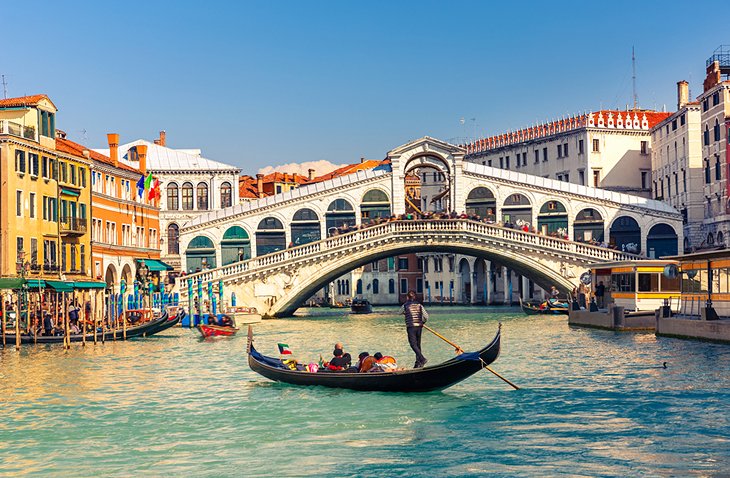
You could easily find enough attractions to spend a week in each of these cities, but you can see the highlights of all three in a well-planned week. The total travel time between Venice and Rome is only three and a half hours, so you can make the maximum use of your time. Of course, you'll want to see the main sights, but do allow some time to stroll through a neighborhood or two and sit in a café to soak up the atmosphere.
For example, after you've ridden the length of the Grand Canal and toured St. Mark's Square and the Doge's Palace , cross Rialto Bridge into the rabbit warren of narrow lanes in San Polo . Here, you'll find mask makers, tiny shops, and artisan studios, as well as churches filled with art and squares where neighborhood children play soccer.
In Rome, after the Colosseum and St. Peter's , explore the streets of the former ghetto of Trastevere , south of the Vatican . In Florence , follow your tours of the Pitti Palace art museums and gardens with a stroll through the Oltrarno neighborhood.
Longer is better, of course, and with a day or two to spare, you can either see more of each of the "Big Three," or you could make a stopover to see Bologna or hilltop Siena . The main train lines between the major cities go right through both. You don't need to stay overnight in either of these, as you can check your luggage at the train station while you tour. To make the most of your time, reserve tickets in advance to big attractions and museums, such as the Uffizi . This itinerary can be followed in either direction.
- Read More: Top-Rated Tourist Attractions in Venice
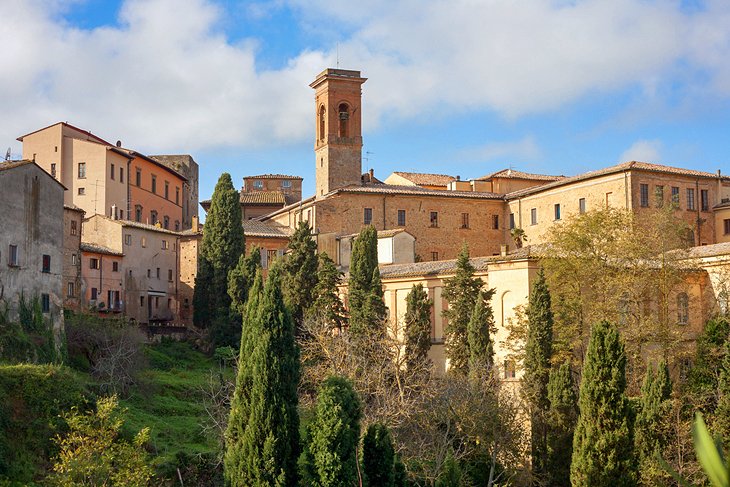
The hilltop towns in Tuscany are legendary for their beauty, their history, and the sheer romance of their settings. Many still retain the walls and castles that were their defense in the Middle Ages and Renaissance, and the art in their churches reflects Tuscany's wealth and power.
A car is the best and sometimes the only way to see many of these towns and the remote abbeys that are also part of Tuscany's heritage. You could easily spend a week exploring the Tuscan countryside and lingering to savor its village life, but you can see a good deal in four or five days.
Begin southwest of Florence in Volterra , whose historic center retains tower houses from the 12th and 13th centuries and which is still famous for its alabaster carving. San Gimignano is a short distance to the north, and one of the best-known of the Tuscan hill towns, mainly for its tall towers and the views across the surrounding countryside.
Colle di Val d'Elsa's old upper town still has some of its 13th-century walls, and the Palazzo Pretorio houses artifacts from a nearby Etruscan cemetery in its Museo Archeológico. Heading south, the little town of Monteriggioni sits inside a complete set of perfectly preserved 13th-century walls with 14 square towers; it's a favorite day trip from Siena .
Siena is worth a day or two stop, filled with medieval and Renaissance buildings and one of Tuscany's finest cathedrals. You'll find more Etruscan artifacts in the Museo Archeologico of Asciano , a fortified hill town south of Siena. The large Olivetan monastery of Monte Oliveto Maggiore was founded in 1313 and remains an active monastic community.
Montalcino is not very big, but it seems to have stepped out of the Middle Ages intact, inside walls built by the Sienese in 1361. Walk the well-preserved walls, visit rooms inside the fortress, and savor views of the Tuscan countryside from the castle.
Just to the south is the Benedictine Abbey of Sant'Ántimo , dating from at least 813, with a Romanesque church. Walled Montepulciano , one of the best known hill towns, shows Renaissance "modernization" to medieval architecture, reflecting the continuing power of its leading families even after other small towns here had declined.
- Read More: Top-Rated Tourist Attractions in Volterra
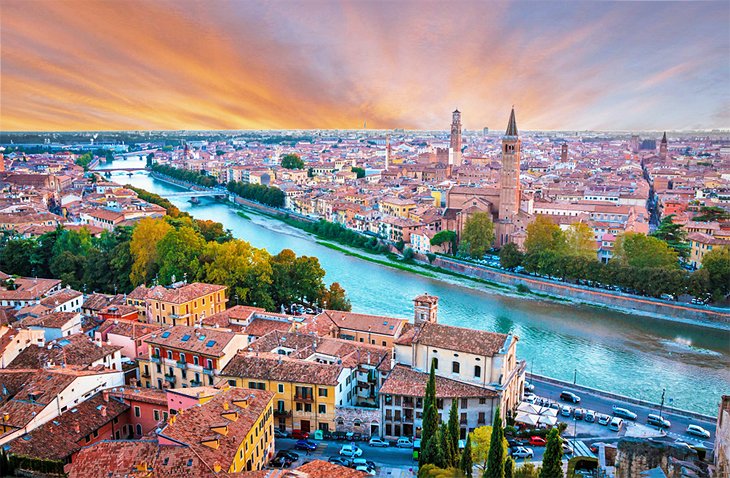
Although you can travel from Milan to Venice by train in two and a half hours, the same train route provides a made-to-order tour of some of northern Italy's most important art and historic attractions. The train line connects major Roman strongholds, centers of medieval and Renaissance culture, religious landmarks, and great centers of learning.
To spend a full day exploring each of these, with time to see the highlights of both Venice and Milan, you should plan at least 10 days, but you can pick from among the stops for a shorter trip. It's easy to see any of these cities without spending the night–you can check baggage at any train station.
Brescia , your first stop, preserves much of its Roman past, with parts of a temple, theater, and its forum still standing, and an exceptionally fine civic museum that includes a Roman villa with mosaic floors . If time allows, a stopover in Desenzano di Garda is a good chance to tour Lake Garda on the boats that leave regularly from the center of town. Highlights on the lake are nearby Sirmione , with a charming little castle and a Roman spa, and Malcesine, with a stone castle and beautiful views of the steep northern shores.
Verona's highlights include one of Italy's finest Roman arenas and a riverside castle–and of course Juliet's house (although the story is pure fiction). Vicenza's claim to fame–and a UNESCO designation–is the architecture of Andrea Palladio . Along with his masterpiece, Basilica Palladiana, are the Teatro Olimpico and the villa La Rotonda.
In Padua (Padova on the station signs), the attractions you shouldn't miss are the Shrine of St. Anthony and Giotto's incomparable frescoes in the Cappella degli Scrovegni (reserve ahead to be sure of admission). If you have time here or in Venice, make a side trip along the Brenta Canal to see the elegant villas and gardens. Leave extra time for Venice if you can, to savor La Dolce Vita at its best.
- Read More: Top-Rated Tourist Attractions in Milan
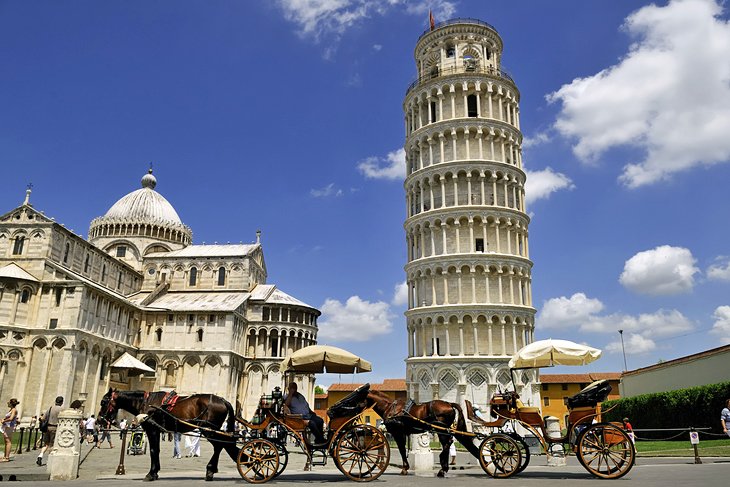
While you could spend a week just seeing all the Renaissance wonders of Florence , you can easily add Pisa and two or three other Tuscan towns in a week's vacation. Handily, they are strung like beads along a route you can follow by train or bus. Because the regional trains don't require seat reservations, you can buy your ticket at the station in Florence and travel any time you wish (be sure to stamp it in the machine on the platform before you board). These towns are only 15 to 45 minutes apart.
After at least two days in Florence, you can see the highlights of Prato and Pistoia easily in the same day. Prato's cathedral is illuminated by two 15th-century fresco cycles that show Filippo Lippi at the height of his artistry.
When you see Pistoia's medieval churches, you may wonder why it's not better known to tourists, but it remains blissfully serene, and you can tour its magnificent 13th-century Cattedrale di San Zeno almost in solitude. Don't miss the silver altar in the adjoining Cappella di San Iácopo or Andrea della Robbia's glazed terra-cotta relief above the central doorway. Across the piazza is a 14th-century baptistery faced with white and green marble.
Lucca , where you will want to stop over for at least a night, will charm you with its medieval towers, beautiful 12th-century church facades, Puccini music (he was born here), and the encircling walls. The tops of these walls are now a city park where locals stroll or ride their bicycles. Climb to the top of the Guinigi Tower for views down into an oval piazza that was once the interior of a Roman amphitheater.
You don't need anyone to tell you what is the main attraction in Pisa, but after you've climbed the Leaning Tower (reserve a timed entrance in advance), be sure to tour the magnificent cathedral and the baptistery, all located in the Campo dei Miracoli (Field of Miracles). The complex is a UNESCO World Heritage site.
- Read More: Top-Rated Tourist Attractions in Florence
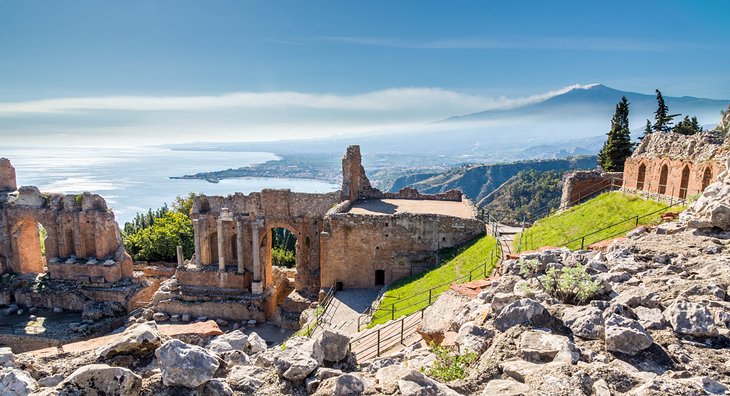
You can see some of the main cities of Sicily –Messina, Taormina, Catania, Syracuse, Trapani, and Palermo–by train, and several others by local bus. But you are tied to schedules more in tune to commuting locals than to tourists, and you'll have trouble getting to the historic sites in the countryside.
A driving tour around the perimeter of the island with stops to tour the major attractions could fill two weeks; you can compress it into a shorter time by skipping some places and seeing just the main features at each.
You'll want a day or two for Palermo and Monreale , where you won't need a car (or want to drive), before heading west to ancient Greek Segesta, with its theater and unfinished temple. Just beyond is the historic port of Trapani on its promontory, and hilltop Erice.
Continuing south along the coast, Marsala and Mazara del Vallo are worth seeing on the way to Selinunte , where you'll find one of the largest of all remaining Greek temples . One of the three most perfect temples in the ancient Greek world is farther along the south coast, at the Valley of the Temples in Agrigento .
From Agrigento, you can either continue along the coast or travel a loop of mountain roads inland to visit the UNESCO World Heritage Site of Villa Romana del Casale in Enna , whose more than 3,500 square meters of mosaics place it high among the best-preserved villas anywhere in the Roman Empire.
Head back south and jump forward more than a millennium to Baroque Ragusa and Modica, before reaching Syracuse . In the archaeological area are one of the world's largest and best preserved Greek theaters, one of Italy's largest Roman amphitheaters , extensive catacombs, and an ancient quarry.
Stop in Catania to see its magnificent Baroque architecture. From pretty Taormina , you can drive up continental Europe's largest active volcano, Mt. Etna . Messina , the closest point to the Italian mainland, is usually overlooked, but it's worth seeing before heading back to Palermo along the scenic north coast, by way of Cefalu .
- Read More: Top-Rated Tourist Attractions in Sicily
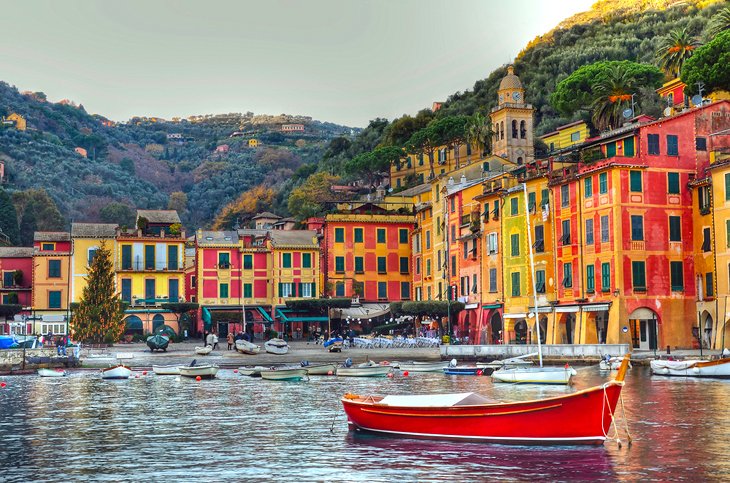
The Mediterranean coast from Sanremo to Portovenere is not just beautiful. It is studded with charming seaside resorts, fishing villages, historic attractions, and artistic treasures, all of them easy to reach by train or boat. If you are traveling with more than a backpack, you may need to choose several bases and backtrack a bit to explore, but that's no problem if you are on a rail pass.
The whole area around Portofino , for example, is easy to reach by boat from a base in Santa Margherita , and the Cinque Terre is easily explored from Portovenere or Sestri Levante. There are no left luggage facilities at any station between Genoa and La Spezia.
Begin near the French border in Sanremo, known as the flower center of the Riviera, where roses, jasmine, carnations, mimosa, and other fragrant flowers bloom on terraces. Rent a bicycle to reach some of the Riviera's best and least crowded beaches between Sanremo and San Lorenzo; most are free.
Genoa is perhaps Italy's most overlooked city, its streets lined with glorious palaces, and its churches and museums filled with priceless art treasures. You can take a ferry from here to the postcard harbor of Portofino and then a local boat to Santa Margherita to stroll its beachside promenade and bask in its gracious old-world atmosphere.
Sestri Levante makes a good base for exploring the Cinque Terre , or choose one of the five towns and hop between them by boat or train. The towns, along with Portovenere, are a UNESCO World Heritage Site . You can move on to Portovenere by train, but by far the most scenic way to arrive is by boat from one of the Cinque Terre towns, traveling beneath the magnificent cliffs and into one of Italy's prettiest harbors. Linger here to climb the narrow lanes, past 12th-century houses, to the citadel high above the town.
- Read More: Visiting the 5 Towns of the Cinque Terre: The Essential Guide
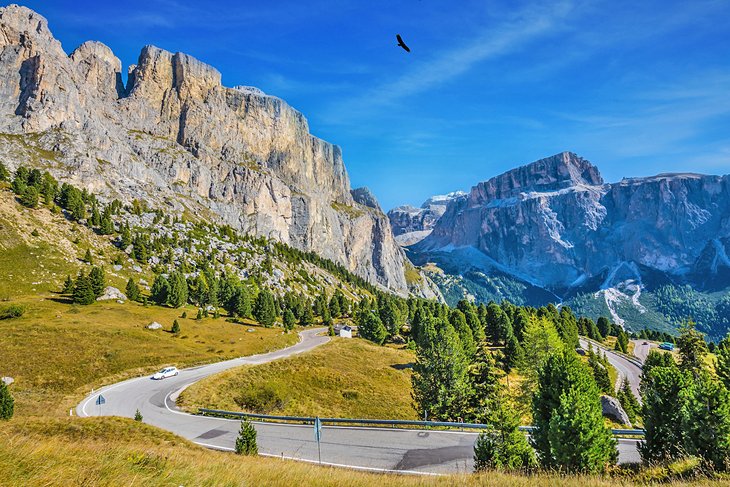
An itinerary for drivers who don't mind winding, steep mountain roads, this is a trip that largely avoids Autostrada traffic, traveling instead through small mountain villages in breathtaking settings. The route combines lovely lake scenery and Garda's holiday atmosphere with the breathtaking mountain views along the UNESCO World Heritage Strada Dolomiti, the Dolomite Road.
Begin in Verona , driving northwest to Peschiera, on the southern shore of Lake Garda , and make a side trip to chic little Sirmione , on a narrow peninsula jutting into the lake. A small but terribly picturesque castle guards its entrance, and at the end of its single street, you can take a tiny train to the ruins of a magnificent Roman villa overlooking the lake.
Return to Peschiera and drive up the east side of Lake Garda, stopping in lively little towns on the way, to Malcecsine . Pause here to climb its medieval streets to the castle and admire the soaring cliffs across the lake. Continue to Riva , worth an overnight stop to savor the lake's holiday vibe. Leave the lake, heading north to Arco, with its hilltop gardens, and continue along the verdant valley to Trento .
Pick up the Autostrada as far as Bolzano , a good stopping point to see the famed Ice Man and tour Castle Roncollo to see some of the finest surviving medieval court frescoes. You'll begin to notice the Germanic influences here, and as you climb through the Alpine villages of the Strada Dolomiti to Cortina d'Ampezzo .
More Alpine villages await on the trip south through the Cadore Valley to Vittorio Veneto , where you'll begin to notice the influence of this region's history as part of the Venetian Republic. Windows and doors around its pretty market square take on the graceful curves seen in the palazzi of Venice.
Conigliano is a charming town with a hilltop castle and excellent restaurants. From Conigliano, continue south past Treviso , where you can either go south to Venice or west through the walled towns of Castelfranco and Citadella to Vicenza . Stop here to tour at least one of Andrea Palladio's magnificent villas before returning to Verona.
- Read More: Top-Rated Tourist Attractions around Lake Garda
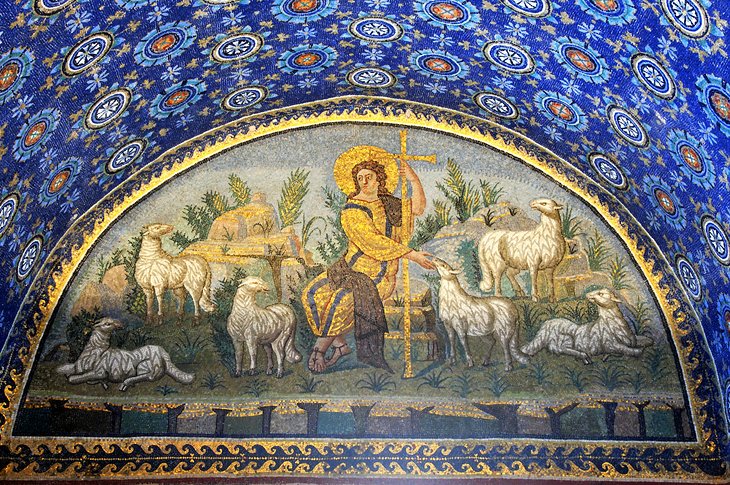
Few driving tours in Italy promise as much variety in a week as the scenic route from Bologna to Florence , along the Adriatic coast and over the Apennine mountains . A week allows a day or two for the medieval towers and beautiful churches of Bologna and time at the end for the Renaissance wonders of Florence. In between these are Roman sites, Europe's finest assemblage of Byzantine mosaics, miles of Adriatic beaches, a fishing village, castles, and the tiny independent republic of San Marino.
Head east from Bologna and stop in Faenza , known for its ceramics. Learn about this craft and see examples by Picasso and Matisse at the Museo delle Ceramiche before moving on to Ravenna . The UNESCO World Heritage Site includes eight churches, each lined with dazzling Byzantine mosaics , so a stopover in Ravenna means you won't have the sensory overload of trying to see them all in the same day.
Farther south along the coast is Cesenatico , whose old fishing harbor, surrounded by seafood restaurants, holds a floating museum of historic boats. Rimini's Roman past is well explained in historic signage as you walk its main street past excavations; the forum; the grand Porta Augusto; and the five-arched bridge, Ponte Tiberini. If the season is right, pause at one of Rimini's famed Adriatic beaches.
Head inland to nearby San Marino , leaving the car to ride the convenient shuttle to its historic center to see the frequent changing of the guard and its three mountaintop castles. Follow the old road, parallel to the Autostrada, through Cesena to Forli , a walled town where the Abbazia di San Mercuriale ( Abbey of San Mercuriale) in the main piazza is worth seeing for its stone carving. From here, follow SS67 over the Apennines to Florence.
- Read More: Top-Rated Tourist Attractions in Bologna
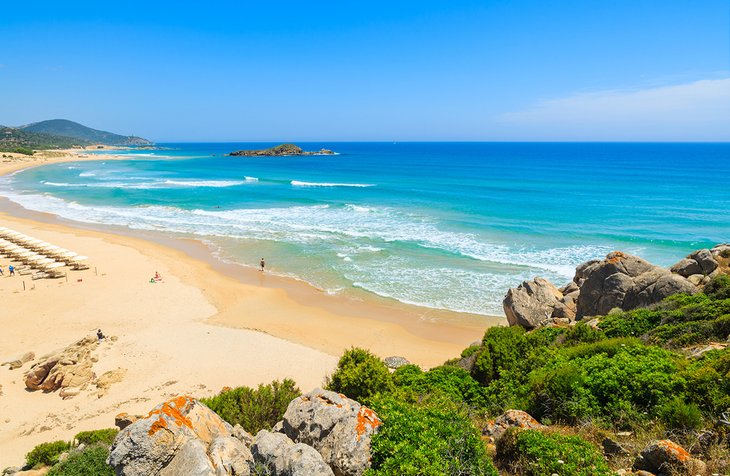
Sardinia may be a part of Italy, but you'll soon feel as though you were in an entirely different country; it even has its own distinct cuisine. Spend at least a day in the capital city of Cagliari for a tour of the main sights, so you'll have some background in Sardinia's unique history and prehistory. To understand the strange nuraghe – the enigmatic stone towers that pepper the entire island–visit the museum in the citadel.
Drive north from Cagliari to see the best of these, Nuraghe su Nuraxi , then head west to Oristano to see the Phoenician/Carthaginian/Roman ruins of Tharros . Continue north to the beautiful town of Bosa , under its castle, and follow the scenic coastal drive to Alghero to walk its walls and stroll its atmospheric stone streets. Take a boat to the impressive sea caves of Grotta di Nettuno before traveling on through Sassari to castle-topped Castelsardo .
Follow the north coast to the fantastic rock formations of Santa Teresa di Gallura and take the ferry to the pink beaches of the Arcipelago di la Maddalena before reaching the Costa Smeralda . Arzachena is a good base here, perhaps at a country inn in the rock-studded mountains above town, as you explore the trendy resort villages and the outstanding prehistoric sites.
A drive south along the east coast brings you to Sardinia's wild and sparsely settled mountains, where a motorway will bring you to Nuoro . This is a good center for a day exploring the precipitous mountain roads to remote towns of the Barbagia . On the way back to Cagliari stop at Nuraghe Losa and the mysterious well of Santa Cristina .
You can do this route in eight days if you leave out some of the prehistoric sites, but 10 gives you more leisure to enjoy Sardinia's unique culture, along with giving you more time to spend in Cagliari with a side trip to the Phoenician city of Nora .
- Read More: Top-Rated Tourist Attractions in Sardinia
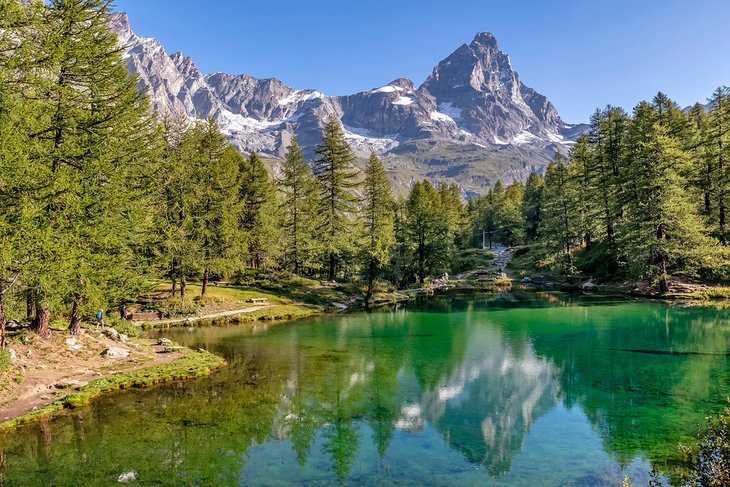
From the royal splendor of Turin , the former Savoy capital, to the natural splendor of Europe's highest peaks, this route follows a valley that has been a major trade route since Roman times. You'll see a Roman theater in Aosta, a string of medieval castles, and the two most famous mountains in the Alps.
Although you could drive from Turin to Mont Blanc (Monte Blanco) in six hours, you should allow three days in addition to your time in Turin. While here, tour the Savoys' Royal Palace , and ride the elevator to the top of the Mole, where you can visit the outstanding cinema museum.
Head north from Turin on the E612 and E25 as far as Chatillion, then drive north to Breuil-Cervinia , at the foot of the Matterhorn . On the way, stop at Lago Blu for one of the best views of the mountain's dramatic south face. A cable car takes you from the village to higher viewpoints.
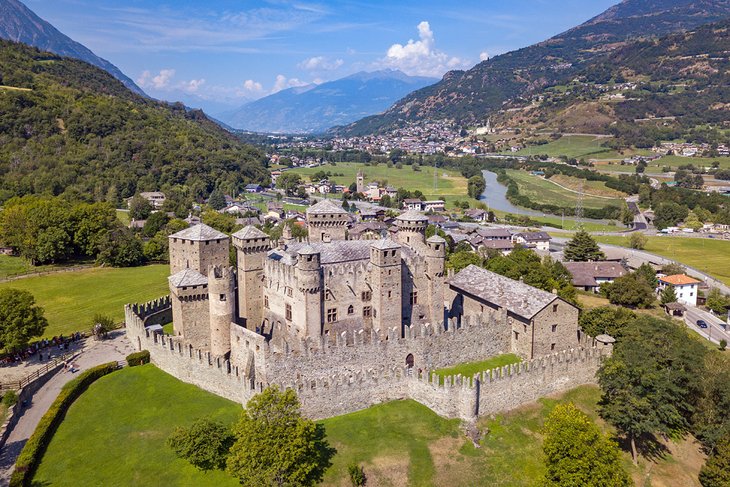
Back in Chatillion, SS 26 follows the river past a succession of villages. Each seems to have its own castle; the first you'll see is the impressive Castello Fénis , a pentagonal fortified manor with towers and battlements, surrounded by crenelated walls. Medieval frescoes decorate the balconies around the courtyard and chapel.
The valley's largest town is Aosta , an ancient Roman post that shows off its past in the well-preserved 1 st -century Arch of Augustus , Roman Theater , towers , and catacombs . The monastic complex of Sant'Orso and the cathedral's mosaics are also worth seeing. From Aosta, you can take a cable car to the 1800-meter summit of Pila for views of the valley and the Alps.
For a glimpse of later history, stop at Sarre Royal Castle , built in the early 18th century and later the hunting lodge of King of Italy Vittorio Emanuele II. A side trip into the Gran Paradiso National Park follows a scenic road from Aymavilles through meadows of wildflowers to the village of Cogne. Here, you'll find a botanical garden of Alpine flora, and hiking trails into the park.
Courmayeur is one of Europe's top ski resorts , a chic ensemble of chalets, boutiques, and cafés, with an interesting Alpine Museum and a 14 th -century church. Outside of ski season, the main attraction is the Skyway Monte Bianco , a set of 360-degree rotating cableways linking three stations ascending Mont Blanc, the highest at 3,466 meters.
More Related Articles on PlanetWare.com
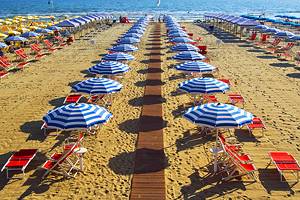
More to See in Italy: While you're touring, you can follow your own special interests with our pages on the Most Beautiful Gardens in Italy and Top-Rated Beach Destinations in Italy . If you are traveling to Italy in winter, see our list of the Top Ski Resorts in Italy .

More on Italy


- Meet the Team
- Work With Us
- Itineraries
- Italy Travel Guide
- Hawaii Travel Guide
- Travel Tips
Planning a Trip to Italy? Here’s Your 10-day Italy Itinerary
The only thing that’s probably holding you back from traveling to Italy is the daunting task of creating your Italy itinerary. We understand. That’s why we’ve taken the work out of it for you by creating a perfect 10-day Italy itinerary that you can follow or use to plan your own trip.
You’re probably wondering all the typical travel things, like when is the best time to go to Italy , what destinations to visit while you’re there, and how to get around.
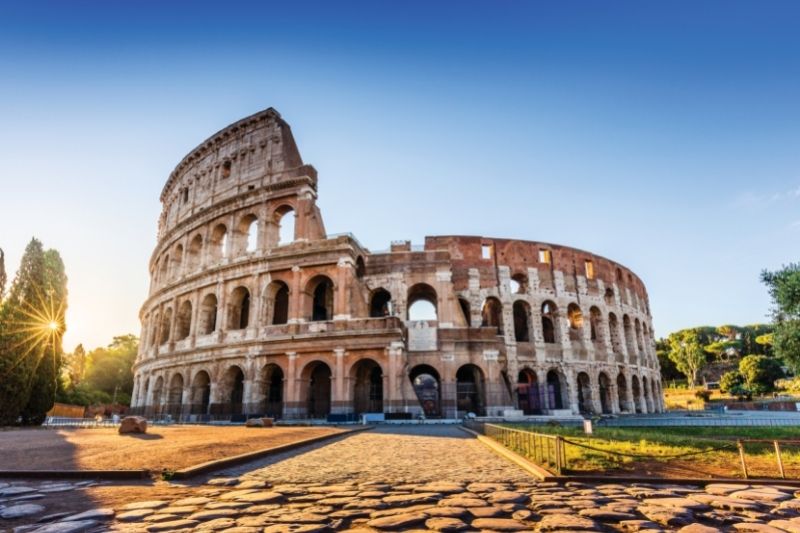
It can all be very overwhelming, but don’t worry, our Italy trip planner will clear up all those questions and help you plan the best way to see Italy in 10 days. If you have other questions about Italy, check out this guide with additional tips for traveling in Italy . Make sure to put these famous foods on your list of things you must try.
You can see a lot in just 10-14 days in Italy without being overwhelmed. It’s not a large country, but there will be a lot of travel to get from place to place. It’s a good thing Italy has a wonderful train system!
If your trip takes you all over Europe, not just to Italy, check out our 2 week itinerary for Europe , which can easily be expanded to one month or more.
Table of Contents
Getting Around in Italy
The best way to get around on your Italy itinerary is to rent a car and drive . I always book through DiscoverCars.com for the best deals. It’s not too difficult driving around in Italy, but you should be prepared for a few things:
- You need an International Driver’s License, which is just a translation of your U.S. or other country license. You can get this at the AAA office, or online.
- Most cars in Italy are manual (stick-shift). You can rent automatics, but there aren’t a lot of them so you have to book in advance.
- The roads are sometimes very narrow and not paved. It’s best to rent a very small car that can easily manuever the roads and parking spots.
Here's more to help you plan
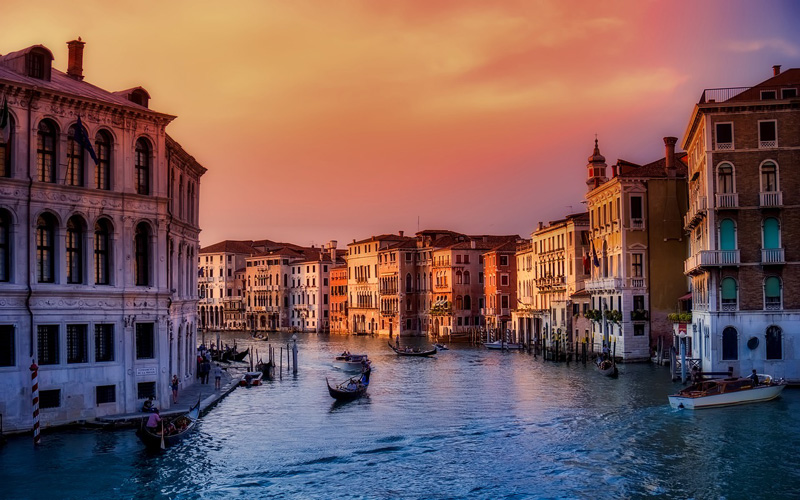
12 Best Cities in Italy: Popular Attractions and Must-See Sights

9 Things to Know When Traveling to Italy

Guide to the Best Wine Regions in Italy
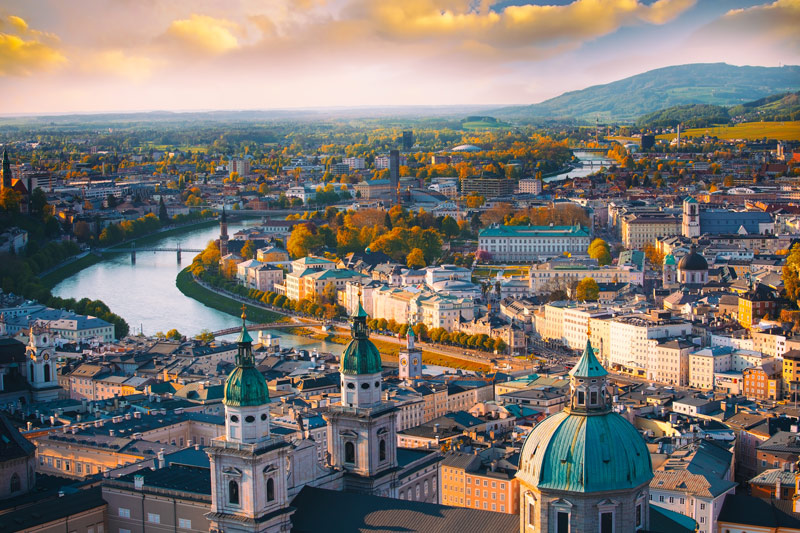
21 of the Best Cities to Visit in Europe
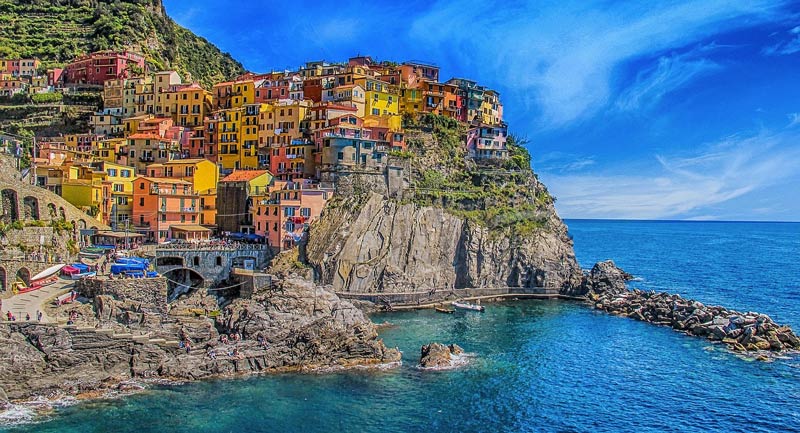
How to Plan a Vacation in Italy
Best time to go to italy.
The first step in planning an Italy vacation is deciding when to go. As with most places, there is a “best” time to go to Italy, but that doesn’t mean you can’t go whenever the mood strikes you.
It really is a year-round travel destination. We’ve been there in all 4 seasons and always have a great time.
If I had to pick one perfect time to go to Italy, it would be late autumn (end of September to November), because it is the height of grape and olive harvest season in Italy, and there’s nothing better than seeing the rolling hillsides covered in ripe bunches of grapes, and the olive trees laden with green fruits.
- Spring (March to May) is a great time to visit, as the temperatures are lower and so is the tourist traffic, which leads to lower prices and shorter lines to get in to popular attractions. May is the rainiest month in Italy, but it’s not enough to ruin your trip.
- In autumn (late September – November), the leaves are changing color and the resulting scenery is nothing short of amazing, plus the harvest is on!
- Summer in Italy gets very hot and humid. It’s also a very busy high season, so you’ll constantly be fighting crowds and you’ll pay more for accommodations. Try to avoid traveling in July and August. Even June can be extremely hot – 100+ degrees F.
- In winter, December to February, there are definitely less tourists, but the weather isn’t prime for that dream Italian vacation.
Getting to Italy
Many top airlines fly to Italy. However, it’s not so easy to find direct flights from the U.S. to Italian cities. The easiest cities to fly into from international destinations are Rome, Bologna, and Milan.
If you don’t mind making a stopover in Frankfurt or Amsterdam, you can fly to just about anywhere you want within Italy. If you want to try to add a free stopover flight on your way to Italy, try it using Skyscanner .
Something to consider, which will help maximize your time in the country, is to fly into one city and out of another, such as flying into Rome and out of Milan. Doing this will save time and money.

Best Places to Visit in Italy
First-time visitors would do best to hit up the most popular sights that are easy to get to via train or a quick domestic flight. Then once you’ve explored the top destinations, you can dig deeper into the more off-the-beaten path locations.
A road trip can be a very rewarding way to see a lot of the country. Here is a list of places to visit in Italy that you should definitely include in any 10-day Italy itinerary.
If you’re not keen to travel on your own, there are many tour agencies that provide tours to these cities. However, it is very easy to travel around Italy via train, so organizing your own trip is recommended.
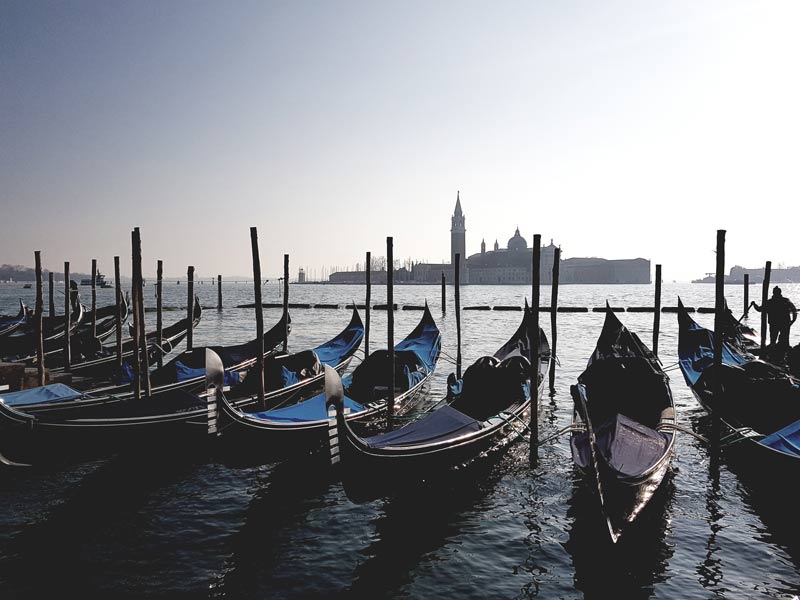
How to Spend 10 Days in Italy
If you’re a frequent traveler, you’ll have no problem planning your own Italy travel itinerary and getting around on your own. There is a small language barrier to deal with in some places, but it’s nothing a savvy traveler can’t handle.
In most large cities, the majority of people you will come in contact with will speak English. Now for your 10-day trip to Italy, which includes Rome, Tuscany, Florence, Bologna, and Venice.
Note: Your tour starts on the day after you arrive, unless you fly in quite early, otherwise you won’t have enough time to see everything in Rome. You need 2 full days to do it.
Day 1-2: Rome

Visiting Rome is like stepping back in time. With so many amazing attractions to see throughout the city, it’s easy to see everything without much fuss. With a good map and a little energy, you can easily walk the entire old city of Rome and see all of the iconic landmarks listed below.
- The Roman Forum: Check out the ruins of the Arch of Titus, the Temple of Vesta and other ruins of a powerful, historical time gone by.
- The Colosseum: You can pay for a guided tour, or just walk around yourself, especially if you’ve done some research ahead of time or have a book along with you.
- Trevi Fountain: This is an absolutely must see, tucked away in a small piazza and crowded with people vying for a chance at a good photo. If you toss a coin into the fountain over your left shoulder using your right hand, you’ll come back to Rome someday.
- The Spanish Steps: Located at the Piazza di Spagna, this steep set of steps climbs up to the Trinita dei Monti church at the top and is surrounded by upscale shopping, tourists lounging on the steps and a wonderful Italian vibe.
- Plaza Navona: You must stop here for photos and for an overpriced drink at one of the cafes, for some of the best people watching in the world.
- The Vatican Museums: If you’re an art and/or architecture lover, you can’t miss a journey through the ancient Roman sculptures and paintings at the Vatican. You’ll see the Gallery of the Maps, Raphael’s Rooms, the stunning Creation of Adam by Michelangelo in the Sistine Chapel , plus St. Peter’s Basilica (if you have time).
Tours & Tickets
You will need tickets for a few of the things on the list. In Rome, I never recommend just walking up to the attraction without tickets, because you could stand in line for hours.
Plan ahead and purchase tickets before you go. The most important ones to secure tickets for are the Colosseum and the Sistine Chapel .
You can book tickets directly through the attraction’s website, or you can use the links below to book our recommended tours through Viator :
- Skip the Line: Ancient Rome and Colosseum Half-Day Walking Tour – Skip the entrance line to the Colosseum and see the first and second levels with a guide (plus ability to add the underground tour), plus tour of the Roman Forum, the House of the Vestal Virgins and a walk along Via Sacre.
- Faster Than Skip-the-Line: Vatican, Sistine Chapel and St. Peter’s Basilica Tour – “Skip the line” with this tour means using a special entrance to bypass even the fast-track line.
- Rome Food Tour – One of my favorite things about Rome is the food culture. Discover all the great food on a guided food tour. You can read about the tour we took here .
What to Eat in Rome

Rome has many food specialties, some that differ from other areas of Italy. If you want to get a real immersion in Rome, you must try these specialties:
- Cacio e Pepe – Cacio e Pepe is a very simple pasta dish that literally means “cheese and pepper”. The pasta noodles are covered in Grana Padano or Parmesan cheese, butter, and ground black pepper.
- Carbonara – Carbonara is made with egg, hard cheese, guanciale, and black pepper.
- Bucatini all’amatriciana – All’amatriciana is a pasta sauce with black pepper, red pepper, guanciale, Pecorino cheese, and tomato.
- Suppli – A fried ball of rice with a filling of tomato sauce and melted mozzarella. You can find really delicious variations at Supplizio.
- Gelato – You will find a gelato stand on nearly every block. Look for ones that aren’t puffed up into a large dome.
- Pizza al Taglio – This pizza is baked in large rectangular pies and cut into squares. You can find it at street food stalls or quick stop shops all over Rome.
Where to Stay in Rome
The best location in Rome depends on what you want to accomplish during your stay, but it’s always best to be centrally located so you can walk to all of the main attractions.
I really like the area around the Spanish Steps. It’s easy to find in case you forget your map or lose your bearings. Two great choices in the affordable luxury range are The Inn at the Spanish Steps (with a gorgeous roof-top pool) and Il Palazzetto .
We also really enjoyed staying at Nerva Boutique Hotel in the popular Rione i Monti area.
- Il Plazzetto ⇒ Read reviews on Trip Advisor | Book a stay
- The Inn at the Spanish Steps ⇒ Read reviews on Trip Advisor | Book a stay
- Nerva Boutique Hotel ⇒ Read reviews on Trip Advisor | Book a stay
- Airbnb: Lovely and cosy apartment at Pantheon Square | Book a stay
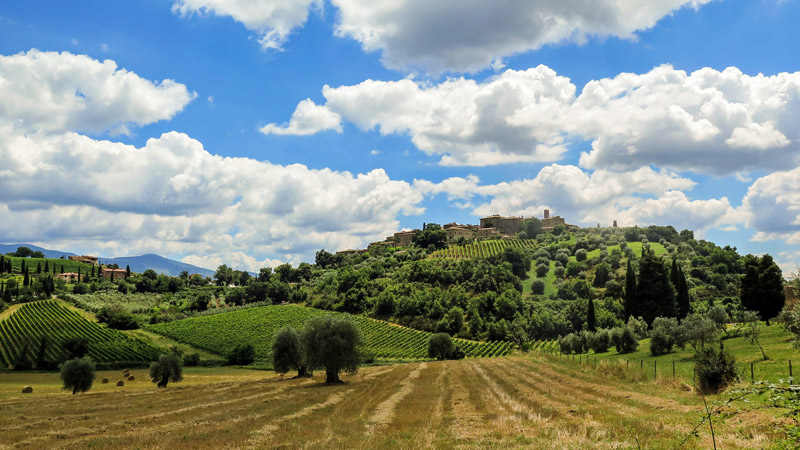
Transfer from Rome to Siena.
The best way to get from Rome to Siena is either to drive or take the train. It’s a 3-hour journey, no matter how you go. If you have a car, you’ll be able to get around within the region easier, but it’s not absolutely necessary to have a car, if you’re planning to go on pre-arranged day trips.
There isn’t a direct train, but you just make one short change in Chiusi and head to Siena, the most well-connected city in the center of Tuscany.
From here you can get to surrounding towns, like Montepulciano and Greve in Chianti, so it’s the perfect base for tourists, no matter what you want to see.
There are tons of restaurants, cafes, hotels, and wineries right inside Siena to explore, if you don’t want to venture far.
What to See in Siena
- Piazza del Campo – Huge and gorgeous medieval square
- Duomo di Siena – Romanesque-Gothic Cathedral
- Pubblico Palace & Mangia Tower – Gothic-style town hall building and tower
- Fonte Gaia – Lovely historic fountain
If you want to taste some wine in Tuscany, it’s best to get outside of Siena and visit the wineries and vineyards. If you have a car, we recommend checking out our list of the top wineries to visit in Tuscany .
If you’d rather stay within Siena, you can visit one of the enotecas in Siena, like Enoteca Emporio Mediterraneo or Vineria Tirabusciò Siena .
We also highly recommend doing a Tuscany cooking class in Siena.
You don’t need tickets to see any of the things listed above, but if you want to get outside Siena and explore Tuscany without a car, you’ll need to book some tours.
Below are some of the tours we recommend:
- Small-Group Brunello di Montalcino Wine-Tasting Trip from Siena – visit 3 wineries, plus lunch at a family-run winery.
- Hot Air Balloon Flight Over Tuscany from Siena – This 1-hour hot air balloon flight from Siena takes you above Tuscany to get a breathtaking view of the low-rolling hills, some clad in grape vines, others crowned by a rustic ancient villa.
- San Gimignano, Chianti and Montepulciano Tour – Visit San Gimignano, Monteriggioni, and Montalcino on a day trip from Siena, and discover medieval architecture, wine, and stunning views of Tuscany.
What to Eat in Tuscany
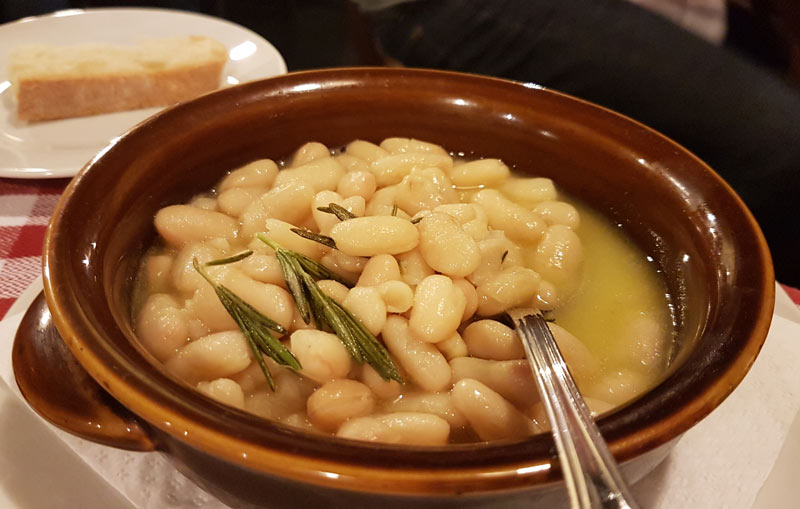
Food and wine are synonymous with Tuscany. You can’t have one with out the other. There are many fantastic dishes, both pasta and not, that you must try.
Many of these you’ll find on almost every traditional menu in Tuscany.
- Ribollita – a vegetable and bread soup
- Fagioli con salsiccia – Baked Cannallini beans with sausage
- Tagliatelle al tartufo – a wide pasta covered in a truffle sauce. Truffles are abundant in Tuscany!
- Tagliatelle al Ragu di Cinghale – Tagliatelle with wild boar ragu
- Pici – a pasta made from flour and water rather than flour and eggs
- Pecorino – Sheep’s milk cheese from Pienza
Where to Stay in Siena
You won’t find any of the top chain hotels in Siena. The accommodations here are rustic Italian charm. You can expect either a very ornate building, or very minimalist decor.
There are two options – stay inside Siena in a hotel or apartment, or stay just on the outskirts of Siena in a farmhouse stay. If you have a car, I encourage staying outside the city center.
Grand Hotel Continental Siena – a Sienese palace steeped in history. The Grand Hotel Continental is part of Starhotels Collezione, Starhotels exceptional luxury hotel group and is the old town’s only 5* hotel and has a privileged position near Siena’s most important attractions. | Trip Advisor reviews | Book here
Aia Mattonata Relais – Located in a restored, historic farmhouse outside Siena, overlooking the countryside and the city, and provided with a salted-water, panoramic swimming pool. | Trip Advisor reviews | Book here
Airbnb: Appartamento Palazzo Casini Piccolomini | Take a look
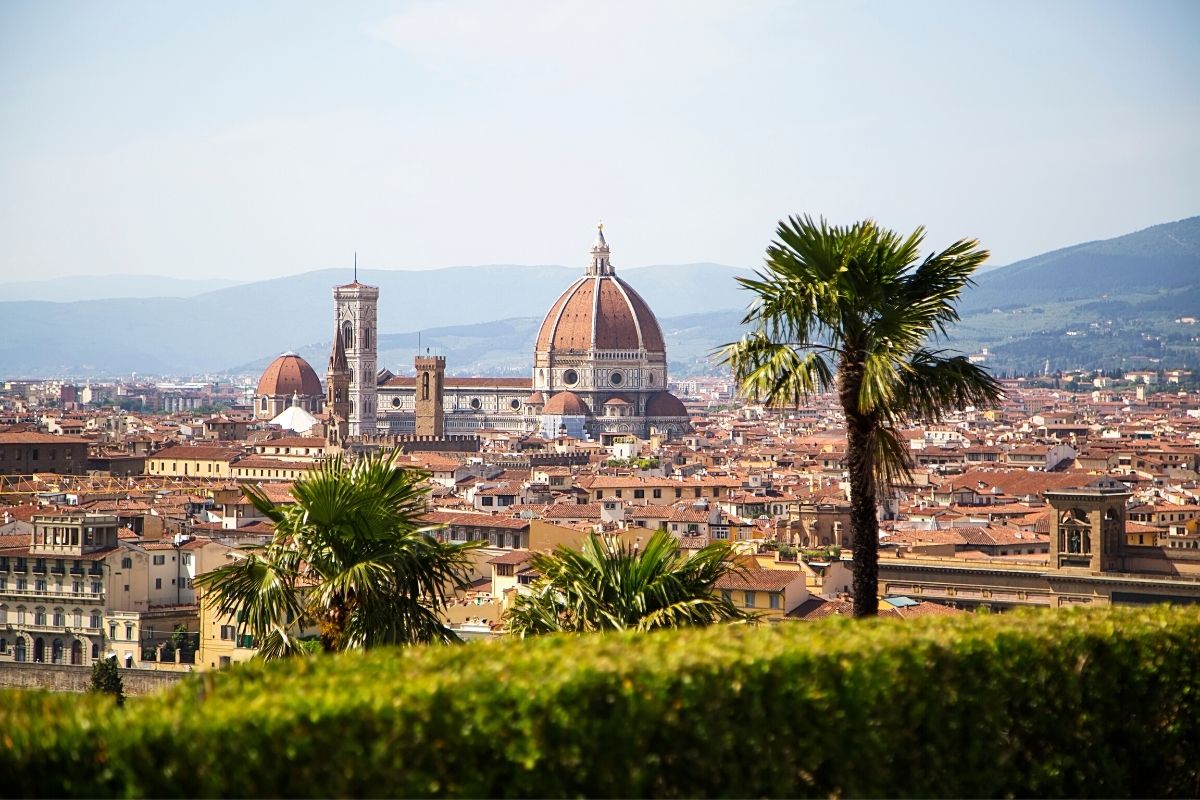
Transfer to Florence: If you have a car, the drive will be about 1 hour 15 minutes.
You can take the 131R train from Siena to Florence in the same amount of time. One of the most beautiful cities in Italy, Florence is known for its art.
The architecturally rich buildings of Florence house some of the world’s most treasured art. So if you’re a museum lover or art history buff, you’ll want to consider how many days to spend in Florence to cover all the top sights .
While 2-3 days is enough for most visitors, to get to all the museums and day trips, you’ll need 5-7.
Spend your time in Florence visiting the sights and museums below. They can be done in this order to make for the most efficient walking route.
- Duomo Santa Maria del Fiore – This vast cathedral towers over the city with its Renaissance dome and Gothic architecture. Entrance is free (tickets needed for the dome).
- Uffizi Gallery – This gallery contains some of the world’s best Renaissance paintings & masterpieces, by the likes of Michelangelo and Leonardo da Vinci.
- Accademia Gallery – This gallery houses some of the most important works of the Renaissance, including works by Leonardo da Vinci, Giotto, Botticelli and Michelangelo’s David statue. Make sure you secure tickets in advance as this is one of the most popular museums in the world.
- Mercato Centrale – This food market is packed with great eating and drinking options. You can peruse the fresh foods and vegetables on the lower floor, then head upstairs to the food court to pick what you want to eat. This is a great place to have lunch.
- Basilica of Santa Croce – A very pretty church, also the final resting place of Michelangelo and Galileo. The memorial to the 19 th century playwright Giovanni Battista Niccolini inside the church is rumored to be the inspiration for the Statue of Liberty. Tickets are 8 Euros and can be purchased here .
- Ponte Vecchio and Palazzo Vecchio – The first is a bridge, the second is the town hall, which is just around the corner from the bridge in Piazza della Signoria. The Piazza is a great place to hang out for a while, because there are sculpture and statues all around, like an open-air art gallery.
You only need to purchase tickets in advance for the Duomo, the Uffizi Gallery, and Accademia Gallery. These are where the long lines are in Florence.
You can book tickets directly through the attraction’s website, or you can use the links below to book our recommended tours through Viator , which are more expensive because they also include a guided tour:
- Best of Florence Walking Tour with Skip-the-Line at Michelangelo’s ‘David’
- Tickets for Uffizi Gallery: Guided Tour + Skip The Line
- The Duomo Complex and Its Hidden Terraces
What to Eat in Florence
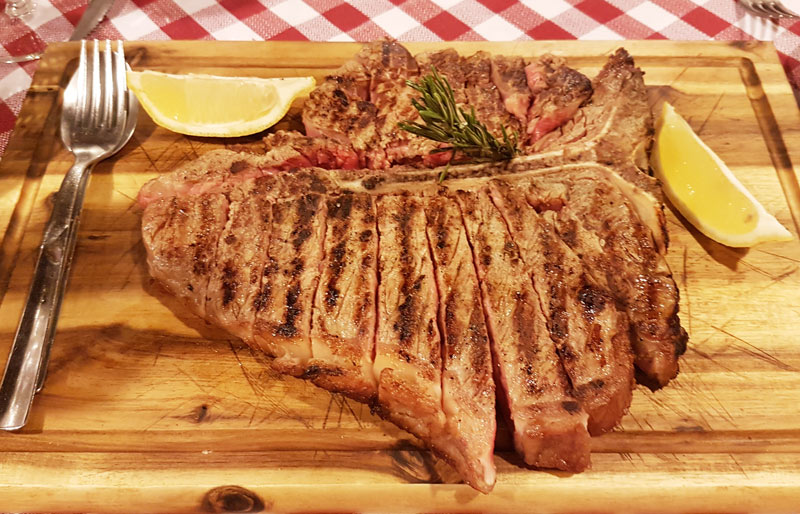
One of the most iconic meals you can have in Florence is a Florentine steak, but there are so many other specialties from this area that you should also be on the lookout for.
- Bistecca Fiorentina – a huge T-bone steak that comes from the local Chianina cattle
- Affettati Misti – A very traditional starter in Florence, this is a plate of cold cuts like lardo, finocchiona, sbriciolona, and prosciutto crudo.
- Appa al pomodoro – a tomato that is thickened with bread and made with tomatoes, olive oil, garlic, and basil.
- Penne strascicate – A Bolognese-type sauce made with vegetables, tomatoes, red wine, and olive oil.
- Ravioli gnudi – Gnocchi made with spinach, ricotta, eggs and parmesan.
Where to Stay in Florence
There is no shortage of amazing, luxury hotels in Florence. You could easily spend half your budget on a couple of nights here.
Firenze Number Nine Hotel and Spa is a smaller boutique hotel in a fantastic location, as is the modern and unique Hotel Garibaldi Blu (where we stayed last time we were there).
If you want to splurge, stay at the Grand Hotel Minerva – perfect location and it has a gorgeous rooftop pool.
- Firenze Number Nine ⇒ Read reviews on Trip Advisor | Book a stay
- Hotel Garibaldi Blu ⇒ Read reviews on Trip Advisor | Book a stay
- Grand Hotel Minerva ⇒ Read reviews on Trip Advisor | Book a stay
- Airbnb: Casina BP – historical centre | Take a look
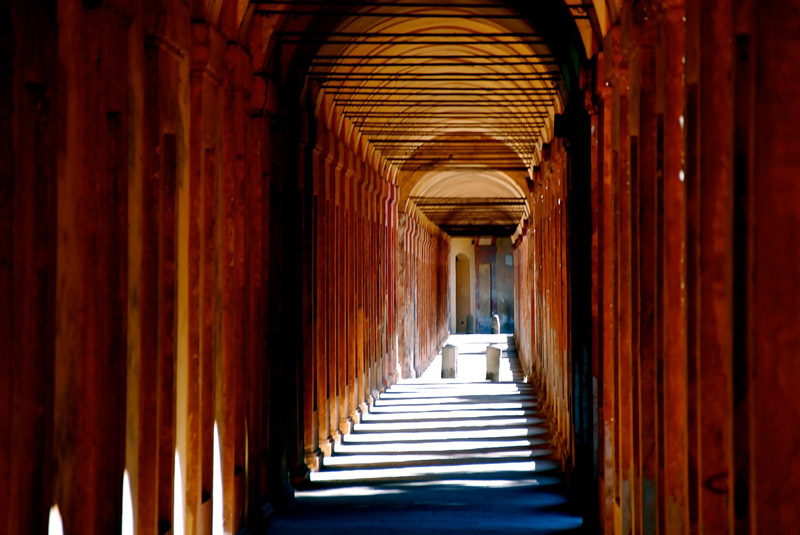
Transfer to Bologna. If you’re driving, it’s about an hour and a half drive to Bologna on the A1. The route has tolls. If you’re taking the train, it’s a quick 35-minute ride on the FR9520 to Bologna Central Station.
For me, Bologna is all about the food . If you love Italian food and want to spend a day learning more about the wonderful DOC products near Bologna, I highly recommend you spend your day in Bologna on this tour .
If you’re not into the food tour, spend your time in Bologna visiting the sights and museums below.
- Piazza Maggiore – this is the center of the action in Bologna and a good place to start exploring.
- Basilica di San Petronio – this gothic basilica is dedicated to the patron saint of the city Saint Petronius. It’s hard to miss, in the center of Piazza Maggiore.
- Fountain of Neptune, Bologna – Next to Piazza Maggiore is the Piazza Neptune, with the monumental fountain of Neptune in the middle.
- Two Towers – One is leaning – Asinelli – and Garisenda. These are great to use as a landmark in city to orient yourself. You can also climb to the top of them for great views.
- Bologna’s porticos – The porticoes, nominated as a UNESCO World Heritage Site, make the architecture of Bologna unique. You can find them all over the city, starting in Piazza Maggiore.
- FICO World Eataly – Just outside the city and easy to reach by train is the Eataly World – a whole warehouse dedicated to food in Italy, with demonstrations, food stalls, and cooking classes. 8-10€ entrance fee.
What to Eat in Bologna

Bologna is home to some really fantastic foods that you don’t typically find elsewhere in Italy – at least in the same form. Tortellino, for instance, is very much a Bologna dish, make with fresh egg pasta. There are also many DOP products made nearby.
- Tortellino – This dish is the star of the show in Bologna. It’s basically tortellini (both big and small), filled with meat and cheese, served in a light broth.
- Tagliatelle al Ragù – Another very popular dish in Bologna, this dish is made with wide egg noodles and slow-cooked meat with tomato, milk, butter, white wine, carrots, celery and onion.
- Parmigiano-Reggiano – This hard, aged cheese is a DOP product that can only be made in Parma, Reggio Emilia, Modena and parts of the provinces of Mantua and Bologna.
- Traditional Balsamic Vinegar of Modena – True DOP balsamic must be aged for a minimum of 12 years. Over that time, it ages in a series of five barrels called a battaria.
- DOP Prosciutto – Pancetta, pork cheek, and disossato are all DOP products made only in this region.
- Mortadella – the original sausage from Bologna .
Where to Stay in Bologna
It’s a good idea to stay in the center of the historic district in Bologna, so you’re walking distance to the main attractions.
- Hotel Al Cappello Rosso – One of Bologna’s oldest boutique hotels, yet with modern facilities and very unique design, next to Piazza Maggiore ⇒ Read reviews on Trip Advisor | Book a stay
- Grand Hotel Majestic – Bologna’s oldest hotel. Ornate only beings to describe this opulent hotel. Close walking distance to the main square and the Two Towers ⇒ Read reviews on Trip Advisor | Book a stay
- Airbnb: Bologna Altana Deluxe | Take a look
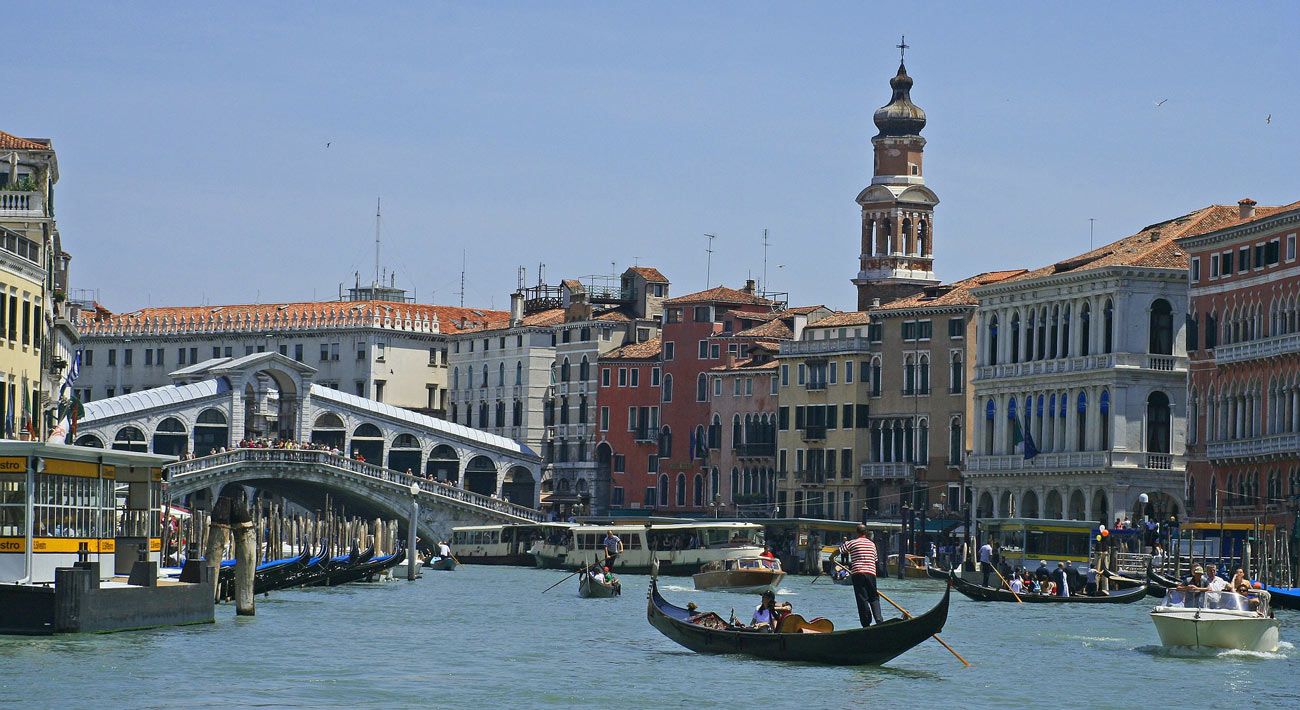
Transfer to Venice. If you’re driving, it’s a 2-hour drive on the A13 to Venice. The route has tolls. If you’re taking the train, it’s an hour and a half on the FR9414 to Santa Lucia train station in central Venice.
I often think Venice is singlehandedly responsible for Italy’s romantic allure, with its winding waterways and canals, arched bridges and amazing architecture.
Since no cars are allowed in the city, it’s an escape from the normal hustle and bustle of blaring horns and angry traffic snarls. Instead, you wander through the narrow cobblestone streets on foot or glide around the waterways on a gondola.
⇒ See our infographic guide to visiting Venice .
Here’s what to see in Venice.
- St. Mark’s Square – The most iconic square in Venice , it’s also home to St. Mark’s Basilica and it is a true sight to behold. It’s very touristy, so I wouldn’t recommend eating in the square, but you can always stop for an overpriced drink.
- Doge’s Palace – This Venetian Gothic style palace is now a huge museum with floors worth of incredible things to see.
- Bridge of Sighs – According to local lore, if you kiss beneath this bridge at sunset, you’ll enjoy eternal love.
- Peggy Guggenheim Collection features masterpieces by Picasso, Salvador Dalí, and Jackson Pollock.
- Murano and Burano – There’s an island in the Venetian Lagoon called Murano, where glass has been made for more than 700 years. Definitely worth a visit.
You will need tickets for a few of the things on the list. Venice is very crowded, almost year round, so it’s not recommended to arrive without tickets to the main attractions, because you could stand in line for hours. Plan ahead and purchase tickets before you go.
The most important ones to secure tickets for are St. Mark’s Basilica and Doge’s Palace, plus a trip out to islands, if you want to do that.
You can book tickets directly through the attraction’s website, or you can use the links below:
- Legendary Venice St. Mark’s Basilica and Doge’s Palace – This tour affords you skip-the-line tickets to both of these popular attractions.
- Murano & Burano Islands Half Day Guided Tour by Private Water Taxi – You can visit these islands by yourself taking the water taxi, but it can be very difficult to get on and off the taxi when there are a lot of people waiting. It’s much easier to do a private tour.
- The 10 Tastings of Venice With Locals: Private Food Tour – Explore food and wine along with facts about Venice.
- Venice Gondola Ride and Serenade – Book ahead to make sure you don’t have to wait in long lines to take the ride you’ve been wanting to take forever.
What to Eat in Venice
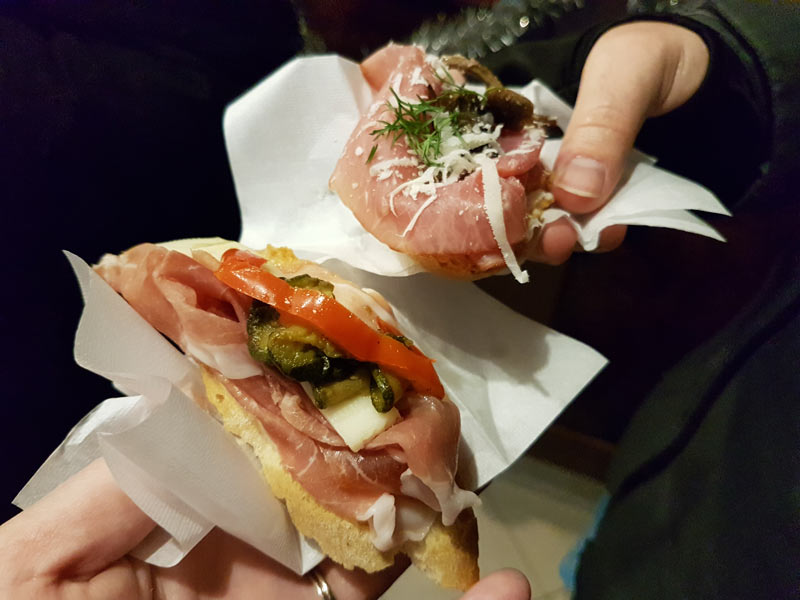
Venice is known for their cicchetti bars. Ciccetti are small snacks or side dishes that are served at the bar in between meals, or even replacing a meal when you’re out with friends. Be sure to grab some cicchetti and an Aperol spritz while visiting Venice.
- Aperol or Venetian Spritz – A spritz is made with 3 parts Prosecco, 2 parts Aperol or Select, 1 part soda, and an orange wedge for garnish.
- Cicchetti – small bites that are typically served in bars alongside a spritz or a small glass of wine.
- Baccala Mantecato – This spread is made from cod, which is soaked and whipped into an airy and light spread that is served on a slice of bread.
- Nero di Seppia – Squid ink pasta
- Sarde in Saor – Fresh sardine fillets marinated in vinegar and served with cooked white onions, and sometimes raisins and pine nuts.
Where to Stay in Venice
The choices of where to stay in Venice are vast, but we can narrow down where to stay in the city to two areas. When you look up hotels on Booking.com, you’re looking at Venice city center.
We narrow that down to the areas around Rialto Bridge and St. Mark’s Square. Below are the only two places you need to know. The first is an apartment-style rental and the 2nd is a hotel.
- Ai Patrizi di Venezia – If you’re staying for 3+ nights, I highly recommend this apartment. It’s in the perfect location, is incredibly comfortable and clean, and has a kitchenette. We sometimes prefer an apartment to a hotel so we’re not being bothered by housekeeping. This place is a gem. | Read Reviews or Book a Stay
- Hotel Londra Palace – If you’d rather stay in a hotel because you like the extra amenities, then Hotel Londra Palace is a great choice. It’s in a very good location, only 5 min walk from St. Mark’s Square, with free wifi and a restaurant. Some rooms have a balcony and an incredible view. | Read Reviews or Book a Stay
- Airbnb: Beautiful 2 bedroom very near Rialto Bridge | Take a look
Unfortunately, now it’s time to fly back home. If you booked a multi-city flight, you can return home from the Venice airport. If not, you will have to fly or take the train back to Rome in order to fly back home.
How to Get Around in Italy
The best way to travel around Italy is by train. You can save money on train travel in Italy with a Eurail pass specifically for Italy. The passes allow you to travel for a specific number of days within a month – from three to eight. See all Italy Eurail passes here .
These passes are meant for non-European passengers only. Order it in advance of your trip and it’s delivered right to your door, so you’re ready to travel when you get there.
Some trains require reservations (high-speed and overnight). So be sure to thoroughly check your preferred trains for rules. As long as there is a train linking each of your chosen cities, you’ll be able to easily travel around the country, and in all of the cities listed here the train drops you off right in the center of the city.
Driving in Italy
If you’re planning on renting a car in Italy, make sure you obtain an International Driving License before you go.
In the United States , you can get one of these at AAA offices as well as from the National Automobile Club, for a small fee. It’s good for 1 year. Italian law requires drivers that don’t have a European Union driving license to show their home country license as well as an International Driving Permit if (or when) they’re pulled over.
The rental car company may not require one to rent, but it’s up to you to have the correct paperwork.
Tipping in Italy
If you’re from the United States, Canada , or another country where tipping is customary, you should be aware that tipping in Italy is not compulsory.
A service charge is often added to the bill, which can be from 10-12%, and it will be noted as a service charge. There can also be fees added for various services, like sitting in on a dining terrace, or getting bread or water for the table.
Be Prepared For Travel Planning is the most important part of any successful trip. Do it the easy way:
🧳 Travel Packing List | ✔️ Why You Need Travel Insurance | ✈️ What to Do Before You Leave Home
- Find and book the best hotel (our favorite booking site is Expedia)
- Research flight options (our favorite tool is Skyscanner )
- Book a tour (we always use Viator to find the best tours)
- Rent a car through Discover Cars (they search the best deals for you!)
There are many ways to experience and enjoy your Italy vacation, now that you know how to plan a trip to Italy. But if the task overwhelms you, rest assured that this 10-day trip to Italy will take you to some of the top places to visit in Italy, and will prepare you for a second visit.
YOU MIGHT ALSO LIKE

8 Best Day Trips from Bologna Italy
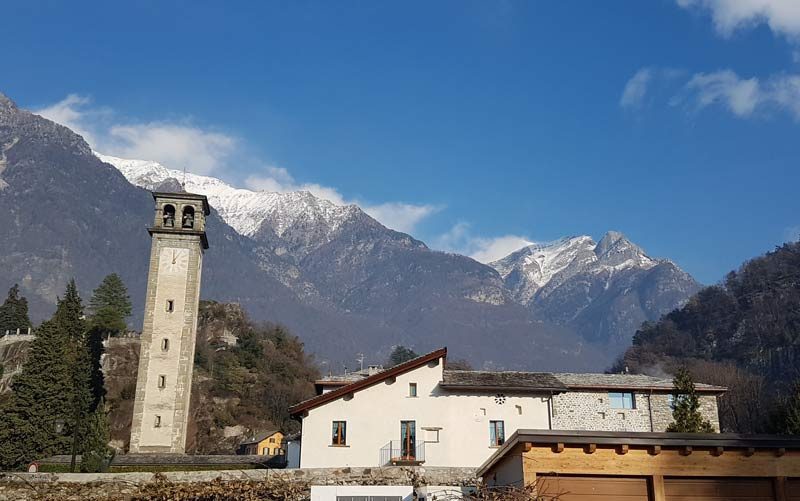
How to Spend A Long Weekend in Valtellina, Italy

Like this post? Why not save it to your Pinterest board for later!

Laura Lynch, creator and writer of Savored Journeys, is an avid world traveler, certified wine expert, and international food specialist. She has written about travel and food for over 20 years and has visited over 75 countries. Her work has been published in numerous guidebooks, websites, and magazines.
Leave a Reply Cancel reply
Your email address will not be published. Required fields are marked *
Save my name, email, and website in this browser for the next time I comment.
- Travel Resources
- Skip to right header navigation
- Skip to main content
- Skip to primary sidebar
Follow Me Away
Couples Travel & Travel Photography Blog
- Middle East
- North America
- South America
- Photography
- Travel Tips
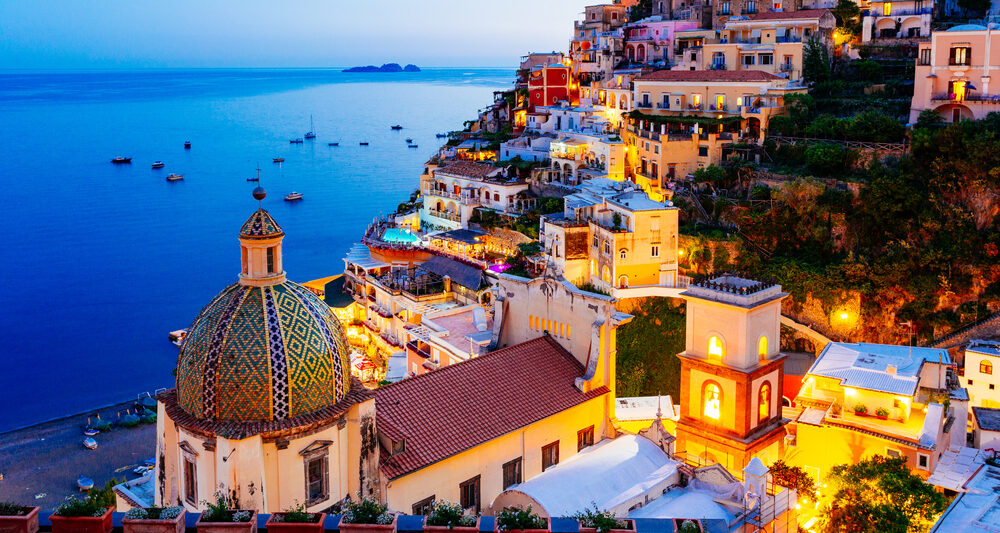
Planning a Trip To Italy: 9 Big Mistakes To Avoid
January 23, 2023 // by Follow Me Away // 8 Comments
There is plenty of information on the web about planning a trip to Italy, but most of it focuses on what you should do.
We even have an Ultimate 10 Day Italy Itinerary that tells you what to do and how to plan.
But this Italy travel guide is different. This is going to tell you what you should AVOID doing when Italy vacation planning.
Planning your trip to Italy last minute?
Make sure to book your hotels and tours in Italy in advance to ensure availability! Here are my top picks for your trip!
Tickets you MUST book in advance:
- Vatican Museums And Sistine Chapel (A MUST in advance)
- Colosseum Entry Tickets (Another MUST! Book online in advance!)
- Michelangelo’s David Tickets (Often sells out in Florence)
- Skip-The-Line Uffizi Gallery Tickets (Buy online to save time!)
- Doge’s Palace Entry Ticket (Very busy, can sell out)
- Milan Cathedral And Rooftop Tickets (Sells out and a must-see!)
Top picks for places to stay in Italy:
- Rome: Hotel Relais Dei Papi (Amazing Vatican location)
- Florence: Relais Pizza Signoria (City center location)
- Venice: Hotel Carlton Grand Canal (Grand Canal views!)
- Dolomites: Parkhotel Laurin (Central location with pool!)
- Cinque Terre: Affittacamere Casa Dane’ (Affordable location)
- Milan: Collini Rooms (Just 10 min from Milan airport!)
Don’t worry, it isn’t all as scary as you may think. Italy is an easy-going country to visit, but there are a few things to keep in mind when planning your Italy itinerary.
We have been to Italy countless times at this point and have made countless mistakes. This [unfortunately] has given us first-hand knowledge of what you should NOT DO when planning a trip to Italy.
Italy was one of the three countries we visited on our first trip to Europe ever [along with France and Ireland] and we have since been back many times.
From the prettiest islands in Italy to the villages of Cinque Terre , these Italy travel planning tips will help improve your vacation!
Now, here are some tips on how to plan a trip to Italy!
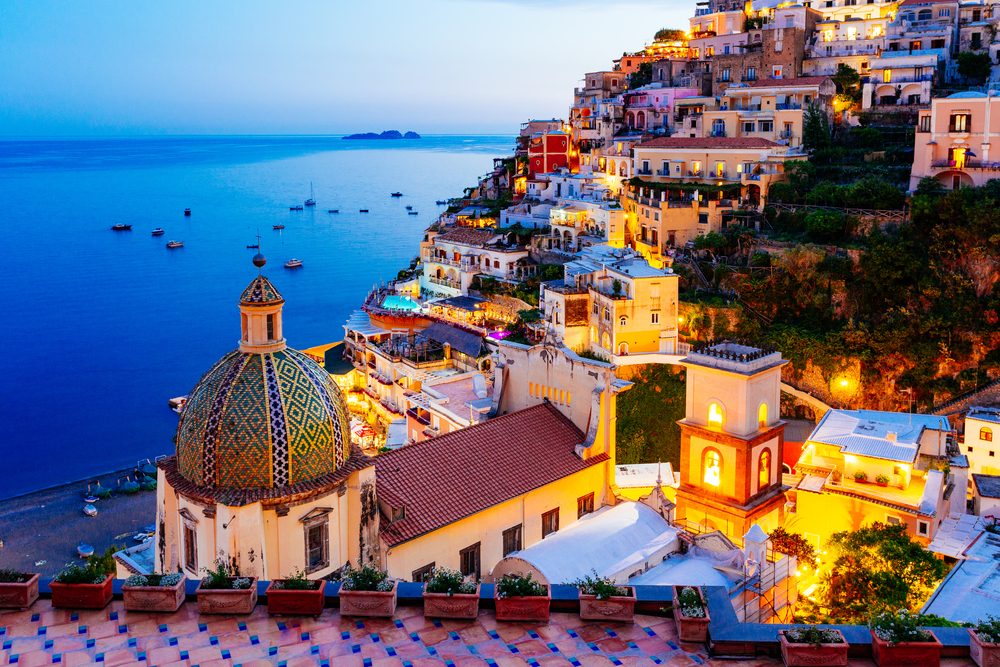
Mistake #1: Spending Too Much Time In Rome
Don’t get us wrong, Rome is an absolutely amazing city to see.
When we were planning a trip to Italy for the first time, we were warned not to spend too much time in the city. Did we listen? Of course not! We spent four days in Rome and it was bordering on too much.
There is a TON to see and do in Rome like all the famous monuments and the Vatican City.
However, some people plan to spend between 5-7 days in Rome and sacrifice seeing some of the other best things to see in Italy!
Spending too much time in Rome is a common mistake people make when planning a trip to Italy.
Rome can feel quite touristy very quickly if you aren’t careful. If you have a shorter amount of time in Italy, we beg you not to spend half of your trip in Rome.
Go for a quick introduction then head out to see the rest of what Italy has to offer. At the very least, take some day trips from Rome .
When working on your Italy trip planner, consider spending between 2-3 days in Rome for a good first-time experience without feeling too rushed.
Whether you are planning your 10 days in Italy , have a bit more time and are spending 2 weeks in Italy , or renting a car and doing an Italy road trip , we do recommend seeing Rome, but not for a super long period of time!
If you do choose to spend your 1-3 days in Rome, we recommend the below hotels. We also have a complete list of where to stay in Rome by area.
Where To Stay In Rome:
Near Vatican: Domus Porta Angelica . Check Rates: Booking.com
Mid-Range: B&B La Scalinatella . Check Rates: Booking.com
Upscale: The Westin Excelsior Rome . Check Rates: Booking.com
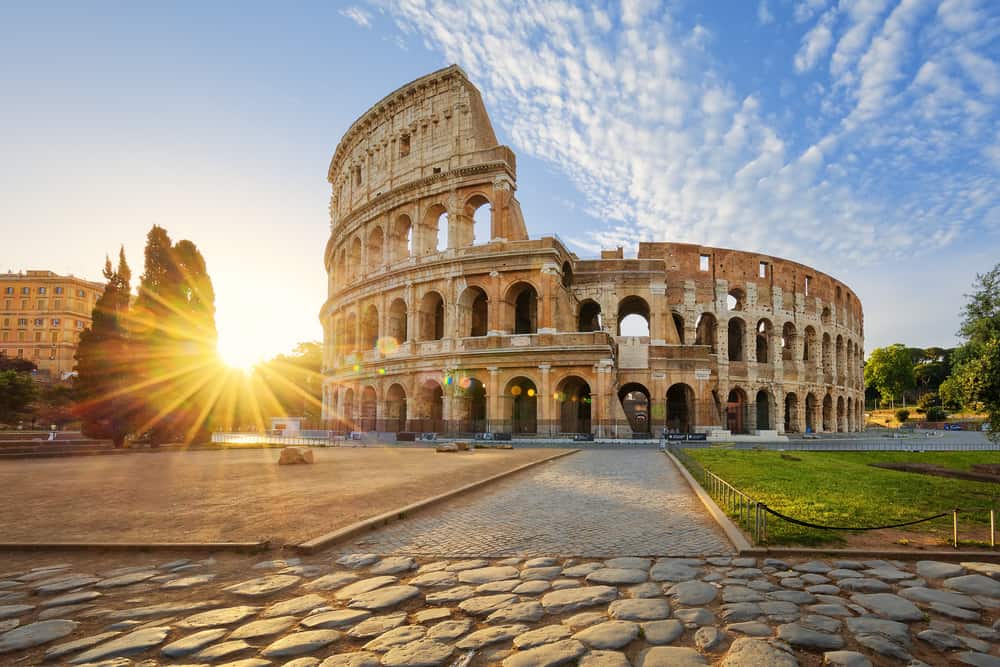
Mistake #2: Trying To Do Too Much In One Trip
Another of the top mistakes in Italy people make is trying to pack in too much during one trip.
Again, how do we know this? Because we did it too and constantly see others doing the same thing.
Italy may look small on the map, but it is actually quite big when you have to explore the whole thing.
There is also so much to see and do. This is why we have been back to Italy so many times! We have never been able to experience all we want in one trip so we have to go back.
When making Italy travel plans, we highly recommend NOT burning out.
By burning out, we mean trying to do way too much in a short amount of time.
We recommend choosing a few things to do and spending longer at those things rather than choosing a lot of things to do and only getting a few hours at each.
Of course, whatever type of trip you want is completely up to you, but slower travel will really let you know more about Italy and it will be much more enjoyable.
While you are planning your trip to Italy, we recommend choosing your highlights and then going from there.
Choose the places you must see and make those a priority. If they are all spread throughout the country and you have only a short amount of time, you may want to rethink your Italy itinerary.
Sometimes it is better to do the top half or the bottom half of the country if you only have a short time, say, 5 days.
If your main reason to visit Italy is to see fantastic scenery, then make that your priority. Don’t try to fit in the beach, museums, and wineries all in a few days.
This will make you feel burnt out and at the end of the day, you really won’t enjoy the nature you traveled all the way to Italy to see.
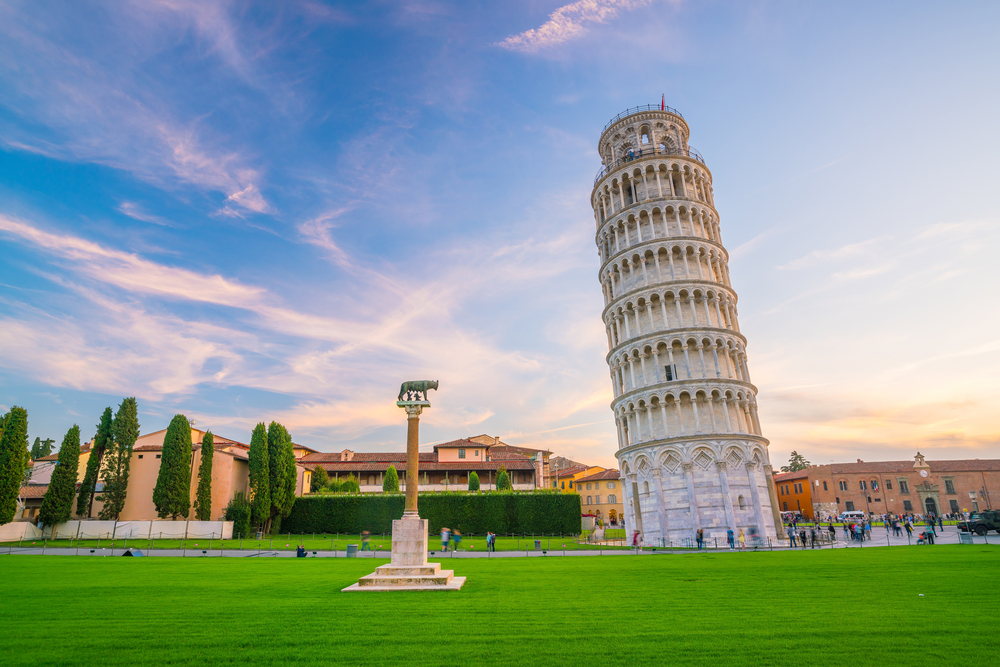
Mistake #3: Being Scared To Use/Not Understanding Public Transportation
Many Americans planning a trip to Italy are very confused about the Italian public transportation system.
We are from Florida and public transport here are some crappy buses that don’t run on time.
The best experience many people in North America get with public transportation is seeing it in a big city such as New York City or Toronto.
This makes people like us not understand what public transportation is all about in Italy.
When planning a trip to Italy on a budget, public transportation is widely available and affordable!
On our first trip to Italy, we took the train all the way from Rome to PARIS! That is really far in case you didn’t know, and it didn’t cost that much.
We stopped in a few cities along the way but the point was to show you how connected Italy really is.
Let’s say you fly into Rome. There are affordable public transportation options to get you from the Rome airport into the city center.
When you are in Rome you can either take the bus or the metro [subway] around the city.
When it is time to head to say, Florence/Venice/Naples/wherever, don’t worry! You will catch a local bus/metro to the larger train station.
You will find your train and ride it to your destination. Once you arrive at your destination such as Florence, you will walk out of the station and there will be local public transportation HERE for you too!
Even the smaller towns in Italy have great local transportation options and are very affordable.
When planning a first trip to Italy, keep this in the back of your mind, especially if you live somewhere that doesn’t rely on public transportation for transit.
You will not show up at a train station and then be left with no option to connect you to your hotel or the city center.
Italy isn’t like North America and this country is well-connected!
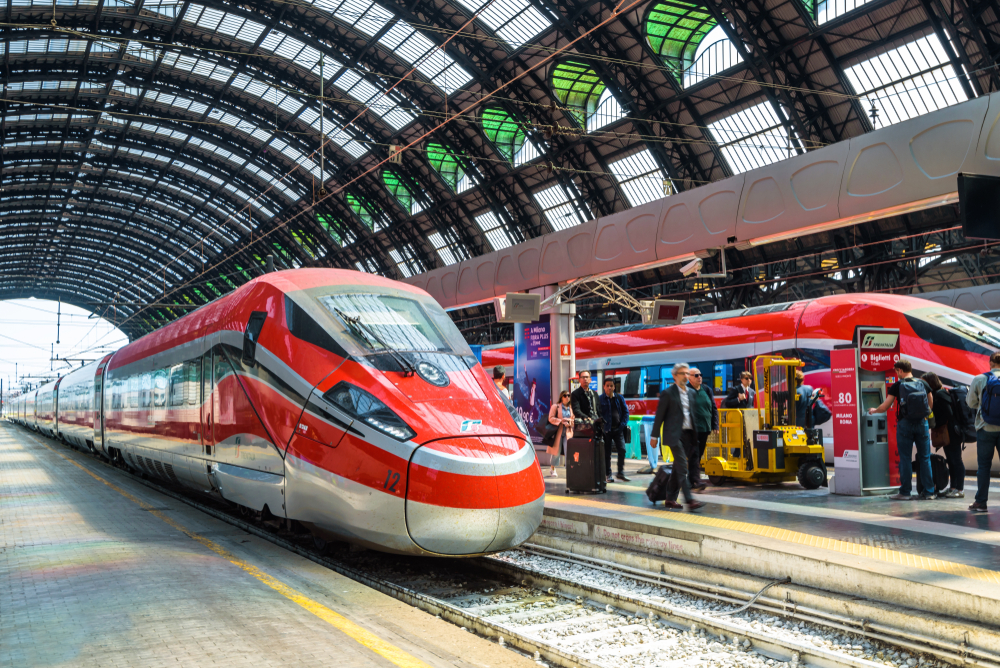
Mistake #4: Spending Too Much Money On An International Cell Service Plan
Luckily, with Sprint and T-Mobile, we get free international data and text messages so we don’t have to pay for a pricey international plan like others who have AT&T or Verizon.
If you have a phone carrier with an expensive international plan, DO NOT GET IT when traveling to Italy on a budget!
You don’t need it. Spending too much money on a pricey international cell phone plan is one of the biggest mistakes people make when planning a trip to Italy.
We were spared from making this mistake because our plans had it included, but know many people who don’t know this simple trick we are about to share.
We highly recommend getting a LOCAL sim card in Italy.
You can simply take out your sim card from your phone and pop in a local one. This allows you to use local 4G networks just like the local Italians.
We love using sim cards from local countries as they allow you fast, easy, and affordable network connection.
When buying a sim card, you can usually purchase one in the airport or in any downtown metro area.
The best network for sim cards in Italy is TIM . This sim card costs around $25 for 30 days of usage and comes with 4G speeds and 15GB of data usage.
This is a WONDERFUL deal and oftentimes much cheaper and faster than using your own plan’s international data.
Plans such as Verizon don’t really exist in Italy which will cause your experience to be frustrating and slow.
Plans such as TIM do exist and are the main network used in the country so you can be sure to have an enjoyable and affordable experience.
WORD FROM THE WISE: Make sure that your smartphone is “unlocked” for International SIM card usage.
This involves calling or tweeting your cell carrier to ensure that it is unlocked for SIM additions.
Simply tell them you are traveling abroad and want to get an international SIM and that you need your phone unlocked.
This is one of the easiest tips we have for you when planning a trip to Italy because it makes getting around so much easier.
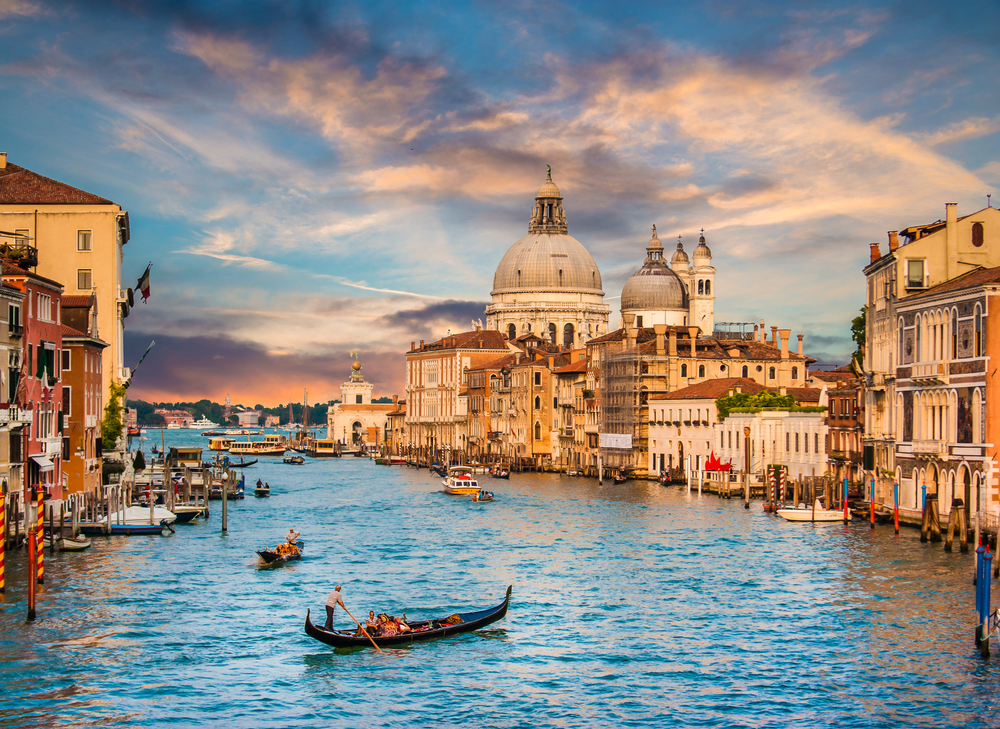
Mistake #5: Only Traveling To Italy In The Summer
Most people think they can only plan a trip to Italy during the summer.
Why? Because that is when it will be the best weather and when the experience will be most enjoyable.
We are here to tell you that this isn’t exactly true.
You can plan a trip to Italy any time of year, and we highly recommend visiting during the off-season.
During the summer or warmer months, the entire island is crowded with locals off work for holidays and the heat made hotels without air conditioning unbearable.
When visiting Italy in the off-season, we had a fantastic time every single time we visited.
The weather was cool and pleasant, the tourist season was low, prices were cheaper, and we didn’t need AC in the hotel.
We recommend checking out Skyscanner to find the best and most affordable time of year to visit Italy. Use this tool to discover the best flights for your trip and easily compare rates.
We also suggest booking your Italy itinerary on a travel credit card so you can earn points toward future travel! These are the travel credit cards we personally use!
We planned a trip to Italy once in the early spring and the experience was just great. The weather was beyond fantastic and there were hardly any other visitors.
On the other hand, when we visited in mid-June, we were fighting with crowds of tourists and everything was overcrowded and super hot.
However, if you are planning a trip to Italy and want to head into the Dolomites/Italian Alps, then the winter/spring will not be the best time for the experience.
The mountains will be buried in snow. Perfect if you want to ski, though!
If you want a lighter tourist time to visit the Dolomites in Italy, consider visiting at the end of summer or during early fall.
You will still get the same stunning experience but it won’t be nearly as busy as visiting during peak season.
Just don’t try and visit the Dolomites in early spring and expect them to be free of snow!
If summer is the only time you have when planning a trip to Italy then please, feel free!
But we just want you know summer isn’t the ONLY time you have to plan your trip.
Italy is essentially a year-round destination. We have had great experiences visiting when the air is cooler and more pleasant outside.
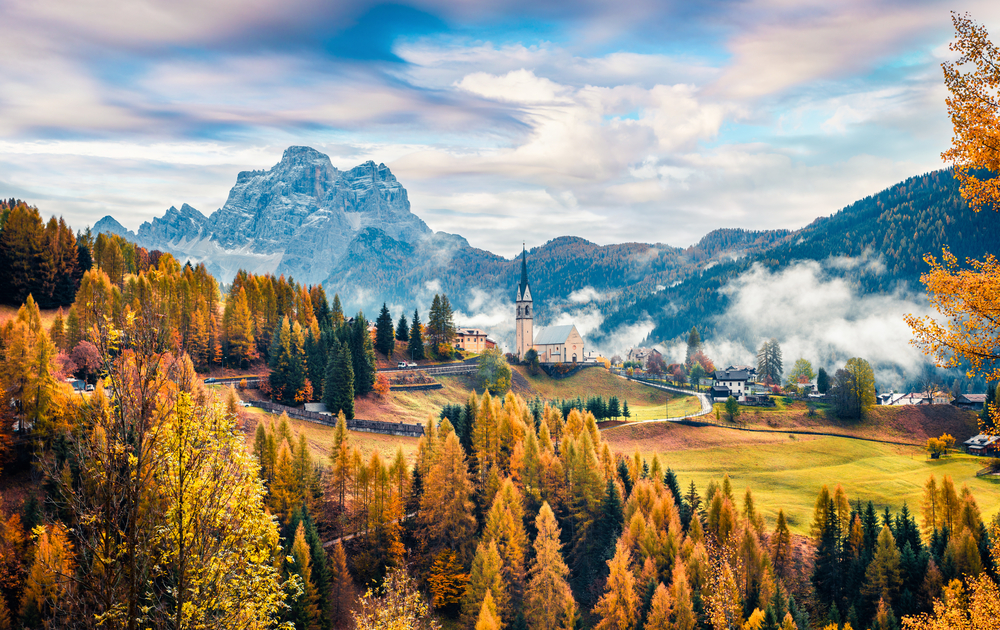
Mistake #6: Completely Writing Off Renting A Car In Italy
Another mistake people make when planning a trip to Italy is completely writing off renting a car.
This is a HUGE MISTAKE for Italy trips because renting a car will provide you with so much freedom. It is the best way to tour Italy!
If a guided tour is more your style then that is totally fine. There are some great tours in Italy that will take you around with ease if you are only in Italy for a few days.
As we mentioned above, Italy has some FANTASTIC public transportation you should 100% use. But great public transportation can only take you so far.
We suggest checking out AutoEurope.com to find the best and most affordable rate when renting a car in Italy.
It allows you to compare rates across a variety of popular car rental websites including Hertz, Sixt, Europcar, Alamo, Dollar, Enterprise, and more.
This way, you can see a bunch of different prices without skipping around through a bunch of different websites.
Make sure to check out the larger cities such as Rome and Milan for the best deals on car rentals in Italy!
We personally love renting a car as often as possible! From Iceland and Peru to Alaska and Ireland, we have rented cars all around the world and love the freedom they provide.
We have often used public transport in Italy and while it is great, you still must stick to a schedule and the buses and trains only take you so far.
We are photographers and hikers and love getting deep into the landscape and renting a car in Italy allows us to do just that.
For example, when we rented a car in Trentino in the Italian Alps/Dolomites, we spent 5-6 hours a day driving up to the tip-top of the mountains, seeing quaint villages, driving past cliff-side vineyards, finding random castle ruins, and more.
A WORD FROM THE WISE: While renting a car in Italy can be affordable, some tolls are steep! We are talking $25 a pop.
If you choose to rent a car, budget at least $200 for tolls, especially if you are driving anywhere out of Milan.
Some parts of Italy have more expensive toll roads while others are much more affordable.
Of course, we understand that renting a car in Italy isn’t for everyone!
If you are going to Italy for the first time, and you just want to see the highlights such as Rome, Florence, and Venice then you really won’t need a car because the trains and buses are great.
If you are looking for an Italy road trip planner, we have a great itinerary for a road trip in Italy .
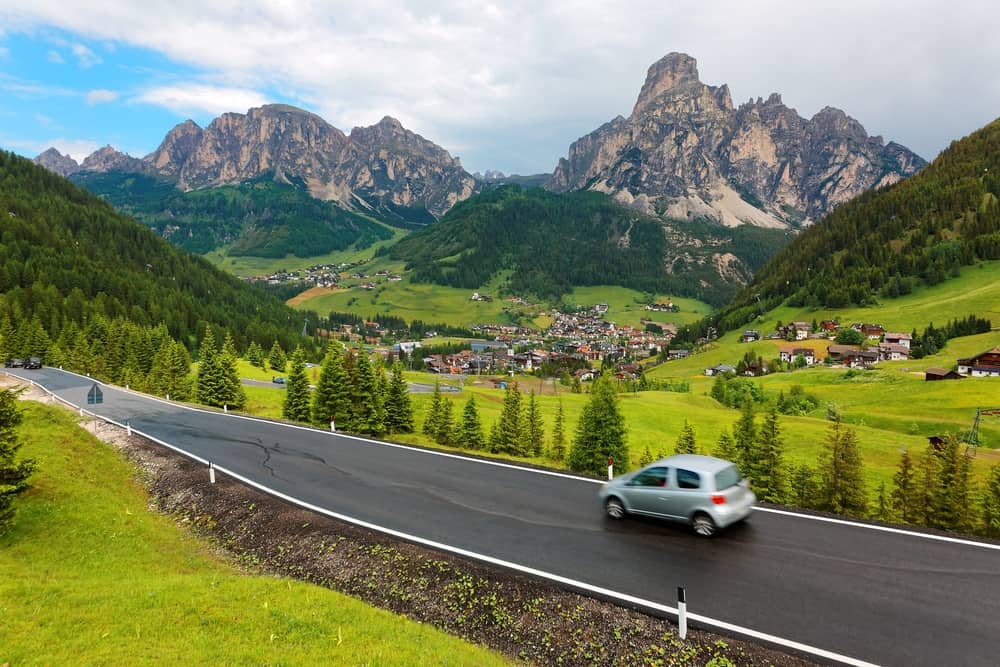
Mistake #7: Only Visiting The Tourist Hot Spots And Nowhere Else
We will be the first to say that we LOVE touristy locations. Why? Because they are usually touristy for a reason such as the Vatican in Rome or the canals in Venice.
That being said, a huge mistake people make when planning a trip to Italy is ONLY visiting these touristy locations and nowhere else!
How do we know? Because that is exactly what we did on our first trip to Italy!
Since then, we have been back additional times and have purposefully done a blend of famous and lesser-known spots. This was a much better mix that allowed us to get a feel for “real” Italy.
So, what is touristy in Italy? Cities like Rome/Florence/Milan/Naples/Pisa are tourist hotspots for obvious reasons.
While we would never suggest you plan a trip to Italy without visiting at least one of these cities, we highly recommend getting out and seeing different parts of Italy.
For example, if you are planning on visiting Florence, consider taking a look at this Tuscany Road Trip Itinerary and go visit a sleepy Florentine town.
There are so many amazingly quaint towns just 30-45 minutes away many people planning a trip to Italy miss.
While the large tourist meccas are popular for a reason, we highly recommend taking the time to visit smaller towns or natural places in Italy that not everyone visits.
Even if you choose to skip a HUGE tourist center for a smaller tourist area that is okay as it still takes you to the small towns in Italy you may have missed.
Not seeing the hidden gems of Italy IS indeed a big mistake. You will miss out on some of the best parts of the country!
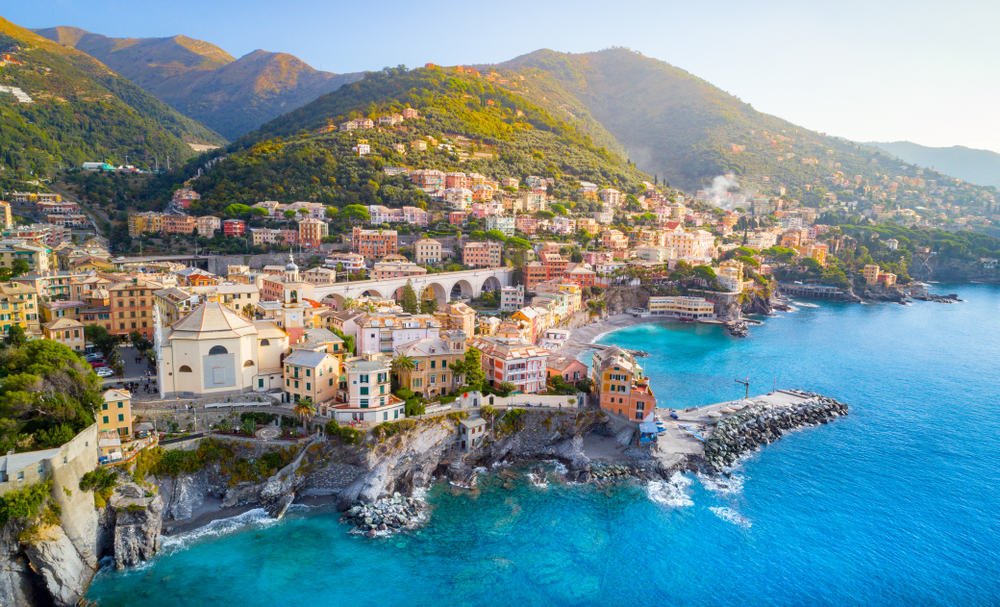
Mistake #8: Not Planning a Budget in Advance
Planning a budget is important for any trip, including Italy. Things can really add up and get expensive if you do not have a plan ahead of time.
If you are planning a trip to Italy on a budget, don’t worry. We have a full, comprehensive article that covers the cost of a trip to Italy .
The article breaks everything down based on how much you are willing to spend.
First, keep in mind the big expenses like flights, hotels, and rental cars.
Then, plan a daily budget for food and activities. You can easily save money by grocery shopping and exploring free things to do.
If you know in advance the average cost of meals, transportation, lodging, and activities, you will know what to expect and how to plan your spending.
Whether you are traveling to Italy on a budget or plan on going all out for a honeymoon in Italy , you will still have a fun and memorable time!
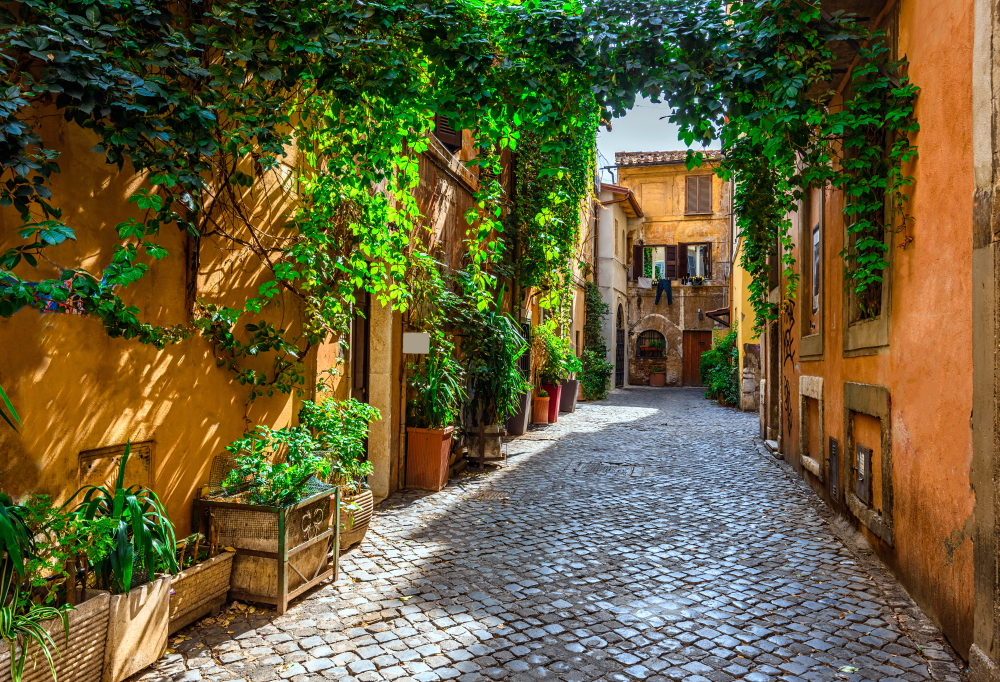
Mistake #9: Not Booking Some Activities in Advance
Because Italy is such a big tourist destination, many of the most popular attractions can book up fast.
This includes things like vising the Colosseum in Rome or touring the Duomo in Florence .
Once you have your Italy itinerary set, you should book your top activities ahead of time to secure a spot on the day you want.
Sometimes, you can also save a little money when you book things online in advance.
Consider booking major experiences like wine tastings and day trips beforehand as well.
Having your must-see attractions and things to do booked in advance takes away the stress of getting tickets at the last minute, waiting in line, and possibly missing out on activities.
Below is a list by city of some of the top attractions you should consider booking in advance to make your trip smoother.
Book Here: Vatican: Museums & Sistine Chapel Entrance Ticket
Book Here: Colosseum, Roman Forum & Palatine Hill Entry Tickets
Book Here: Accademia Gallery Priority Entry Ticket
Book Here: Cathedral, Duomo Museum, and Baptistery Tour
Book Here: From Florence: Tuscany Highlights Full-Day Tour
Book Here: Grand Canal by Gondola with Commentary
Book Here: Doge’s Palace Reserved Entry Admission Ticket
Book Here: From Naples: Pompeii Ruins & Mount Vesuvius Day Tour
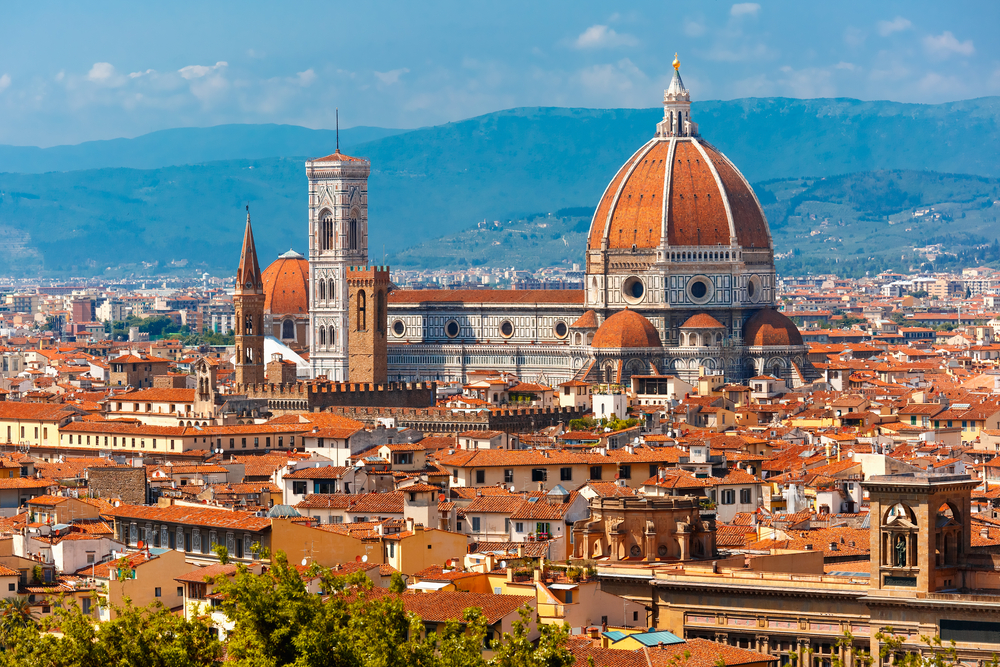
Packing Tips For Your Trip To Italy
Here are some of our favorite items that you should consider packing for Italy !
These are essential travel items we use and love, and you should make sure to consider them for your travels.
A concealed travel pouch may be one of the most important items you bring with you!
This unisex RFID-blocking concealed travel pouch is lightweight and comes in several colors.
It has lots of organization to give you peace of mind. You can keep your most valuable documents safe and secure next to your body.
If you have a pouch already you may not want to or need to invest in a new one. If it does not come with RFID protection , these RFID sleeves would be handy to prevent identity theft.
This configuration comes with enough passport and credit card sleeves that the entire family would be protected.
They are slim too, so they will easily fit into your current pouch or wallet. These are the kind our family uses not only when traveling but at home as well.
If you have a camera on your packing list, you need to add additional memory cards to your list as well.
Unless you are packing a computer for your trip, you will not be able to upload photos and clear your existing memory card.
Purchasing additional memory cards cost under $20 and take up no space in your luggage. Having a backup can have the potential to save you a lot of heartache if something goes awry!
There is nothing worse than coming across that perfect moment and then finding out you don’t have enough space to capture it on your camera!
Similarly, if you are planning to capture your trip on a smartphone, we beg you to bring some way to back up your memories.
The best way to do this is with a portable smartphone flash drive . A flash drive is a small storage device that you can connect to your smartphone and then safely and easily download photos onto this device.
If you are planning on taking a lot of pictures with your phone you will definitely want to consider an external charging battery .
This Anker high-speed phone charging battery is the exact one we carry with us on all of our trips . It can be used on a variety of phones, not just an iPhone like we have. And wow is it fast!
We like that it holds its charging capabilities for several uses so we do not have to worry about it while out and about. And if we forget to recharge it at night, it will still be good to go the next day.
My mom was never a fan of packing cubes until she tried them out! Now she is sold . These Bagail packing cubes are the exact ones she uses whenever she travels and she travels a lot.
She cannot believe how much more organized she is now! And she will never leave without them anymore.
We never leave home on a trip without our Bobble filtration bottle. The 18.5-ounce size is perfect for travel. It will fit nicely in the pocket of a backpack or your purse.
Also when filled with water, it is not too heavy to carry. And the Bobble carbon filter ensures fresh clean water whenever and wherever you fill the Bobble. You can find filter replacements here.
Perhaps you are traveling a long distance and packing space is a premium. Then this set of collapsible silicone foldable water bottles would work well for you.
Would not take up much space in your suitcase at all. And you will be receiving a set of two.
You will want to bring a backpack or daypack with you to store snacks, your water bottle, phone, extra clothes, etc.
This foldable water-resistant backpack would be great. It is very affordable and is available in many color options for you to choose from. The fact that it folds down into a zippered pouch will make it easy to pack.
Perhaps you need a more substantial backpack for your international travel.
This antitheft backpack has a charging port, is water-resistant, and can comfortably carry up to a 15.6″ laptop. It comes in a range of colors to choose from and it is inexpensive as well.
We all need to protect our eyes from the sun’s harmful UVA/UVB rays. These unisex polarized sunglasses come in a lot of lens colors and frame designs and are extremely affordable too.
If you are fond of the aviator-style of sunglasses these polarized aviators may interest you.
We like polarized sunglasses because they remove the glare of the water and help you to see things more clearly.
Don’t forget to bring along a universal power adapter if you are traveling abroad. This worldwide power plug is a great example and will charge your phone at the end of your busy days.
And this world traveler adapter kit can charge several devices at the same time.
This is what you will need when there are several people traveling in your group. Or if you bring several electronic devices on your trip that require charging at the same time.
We hope this post helped you learn how to plan a vacation to Italy.
Italy is one of the first places that we visited abroad and remains one of our favorite countries without fail.
We can’t wait for you to experience it and we hope that these tips help you when planning your Italy itinerary.
They aren’t meant to scare you, but to make you “think” about a few alternative mindsets as you write your trip planner for Italy!
Pin this post:
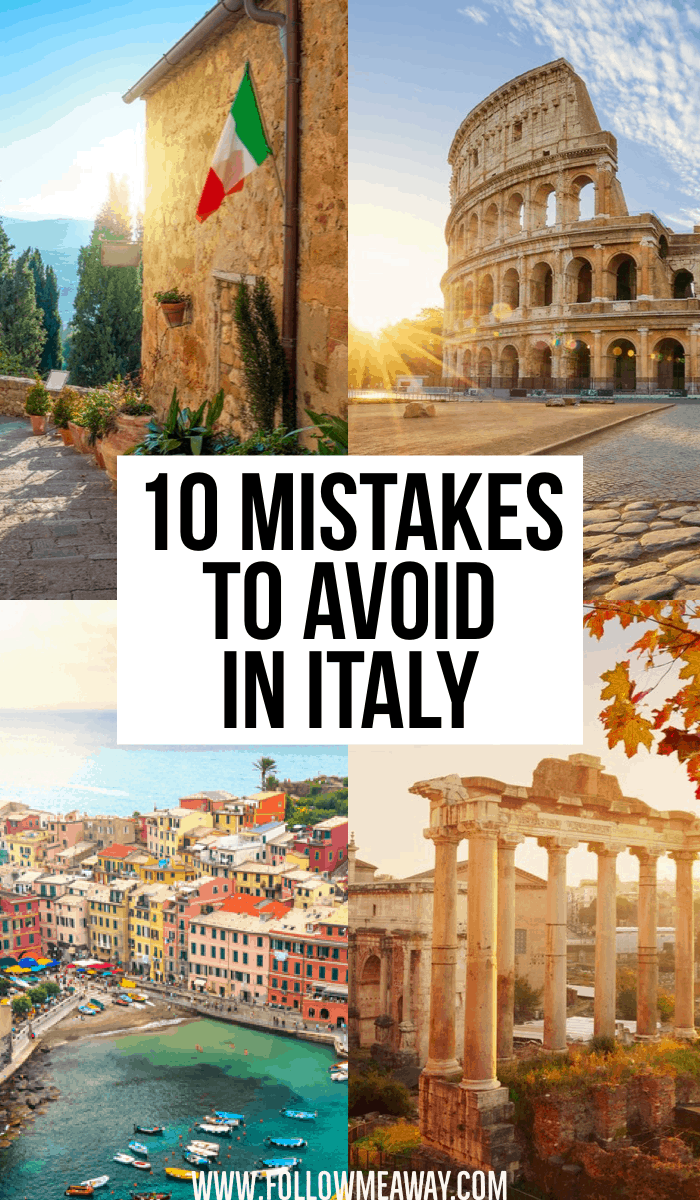
Reader Interactions
March 1, 2019 at 10:54 am
Victoria – I haven’t yet been to Italy but thanks for arming me with some ideas for what NOT to do!
March 4, 2019 at 7:42 am
I loved your article. I agree with you, being a guide of rome and Milan I always suggest my clients and friend to visit also smaller towns using local trains. Also when is possible hire a guide it’s really a way to get to know the place with a friend. Thanks Lara grom
March 29, 2019 at 5:12 am
Completely agreed with everything! I see people make these mistakes all the time and as someone who loves Italy and has visited many times, it always makes me sad to think about how much they are missing out on!
May 3, 2019 at 2:48 am
These are common mistakes anyone who goes to Italy might do. You wrote such an interesting article touching the most common mistakes. One mistake I would add to your list is referring to food, and that is to avoid eating only pizza and pasta, because Italy has so much many other tasty and gorgeous food that you have to try when you visit Italy.
June 27, 2019 at 10:59 pm
Thank you si much for the useful info. I know it takes long to write these kinds of post MSN’s but they are good really appreciated. I’m planning my next trip to Italy and will definitely visit Tuscany.
July 3, 2019 at 5:03 pm
I have been in Italy twice and nothing has ever gone according to plan or schedule which means I have missed Milan, Venice, Florence & Naples, but have seen Rome, Siena, Ravenna, San Marino and a bunch of nameless places along the Swiss border. My daughter saw Assissi under similar circumstances as well. All of it was very worthwhile. But I need to go back!
October 26, 2019 at 11:56 pm
Hello Great suggestions for a trip. What makes the backpack you suggested “anti-theft”?
Thanks William
October 27, 2019 at 3:58 pm
This antitheft backpack has a charging port, is water-resistant and can comfortably carry up to a 15.6″ laptop. It comes in a range of colors to choose from and it is inexpensive as well.
Leave a Reply Cancel reply
Your email address will not be published. Required fields are marked *
Save my name, email, and website in this browser for the next time I comment.
This site uses Akismet to reduce spam. Learn how your comment data is processed .
Should you plan your own Italy trip or book a tour?
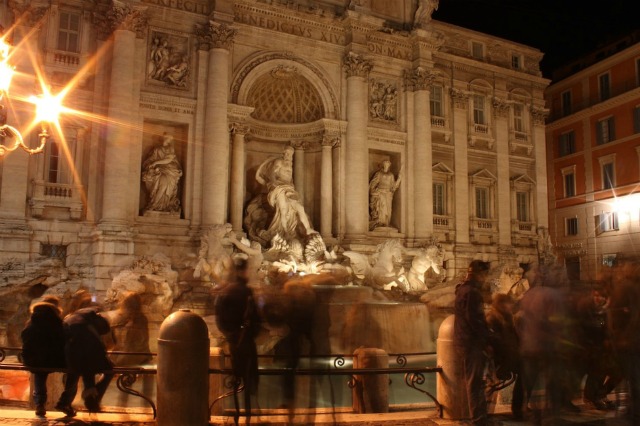
- Browse Italy tours options
- Learn how to plan your own Italy itinerary
And now, yes, here’s my longer answer. I genuinely believe that planning and booking your own trips, no matter where you’re going, results in more rewarding travel experiences. This is partly because you, as the traveler, get to see the process through the whole way, from sowing the seeds right up to harvest. It’s extremely gratifying to do your research to find, say, a secret ticket window in Florence that lets you get reservations to bypass the line in front of the Uffizi – I give you permission to feel a bit smug when it works just like you heard it would. Besides the personal satisfaction of a job well done, however, there is the simple fact that when you’re on an organized tour you don’t have the leeway that’s required for spontaneity. If you’re lucky, you’ll get a few hours of free time each day, but asking serendipity to adhere to a schedule sort of defeats the purpose. Making your own agenda (or making up your mind not to have one) gives you the freedom to explore whatever strikes your fancy. Spend longer in a cafe because you’re having a great conversation with a stranger, seek out a suburban flea market to look for treasures, or take a wrong turn on purpose just to see where it goes. In my own experience, it’s these unexpected detours that have led to some of my most cherished travel memories – and most would have been impossible if I were being shepherded around on a tour. All of this waxing on about the merits of planning your own trip, and I still think “it depends?” Absolutely. Planning your own trip to Italy does require more work than booking a package trip, there’s no getting around that. If you’re one of the many over-worked people who barely has time to do the grocery shopping, let alone research hotels in Venice , you might feel a panic attack coming on at the very thought of figuring out all the details involved in trip planning. Folks, travel is supposed to be fun . The best kinds of trips include challenges, I firmly believe that, but the overall feeling shouldn’t be one of dread, obligation, or discomfort. The bottom line is that you need to listen to your gut – what are you comfortable doing? Do you get excited about planning your own trip, or does the very idea make you want to stay home? The answer to that question will tell you whether you should go DIY or book a tour. Either way, so long as you’re getting out and seeing the world, that’s a good thing. photo by pmorgan67

Everyone dreams of going to Italy. From the food to the history to the breathtaking beaches and scenery, Italy has it all.
It’s no surprise that Italy – romantic, historic, cultural Italy - is one of the most sought-after travel destinations. With its exceptional combination of diverse natural landscapes, world-renowned art and architecture, rich cultural and historical heritage, bustling markets, and fabulous cuisine, Italy offers something for every style and budget.

Rome's charm extends beyond its historical sites to encompass the delectable culinary delights and enchanting ambiance that graces every nook and cranny of the city.

Because of its beauty and its convenient location, Sorrento buzzes with tourists from all over the world throughout the year.

Cinque Terre

With its crystal, turquoise waters and rugged hills, Positano is a seaside paradise and a favorite spot for American tourists.

Noted for its history, culture, architecture, and culinary scene, Palermo is also a good base for day trips around the area.

Naples was founded in the 9th century BC by Greek sailors who gave it the name "Neopolis" meaning “New City.”

San Gimignano

With its undeniable medieval charm, this town is full of history, churches, quaint streets, museums, and stately villas.
Trip Planner - Italy
Create your perfect trip to rome, italy.
Easily plan your trip based on your preferences, budget, and style
Plan your trip with RoutePerfect’s AI and optimize it by using RoutePerfect’s crowdsourced database, based on proven and enjoyable, well-crafted itineraries of thousands of travelers.
Explore Italy’s famous cities, roam through its cobblestone streets, and discover large, medieval squares, frescoed churches, legendary art museums, and extraordinary ancient ruins - and be sure to soak in the atmosphere at a quaint street side café while sipping the world famous espresso!
As part of your Italian adventure, the more remote places are a must, too. Combine your culture-based city tours with a tranquil day at the beach, lake, or in the stunning countryside. Travel to Northern Italy to experience the rustic mountain scenery of the Dolomites and the Alps, the crystalline lakes, vineyard-covered hills, and breathtaking coastlines. Enjoy the Mediterranean flavor of Southern Italy, including the Amalfi Coast and Le Cinque Terre, with its picture-perfect beaches, charming coastal islands, and variety of historic cities and towns. Cruise the canals of Venice ; take a wine tour or go truffle hunting through Tuscany .
If you’re wondering about the ideal time of year to visit Italy, the summer and transition months – as with many destinations - are most popular for tourists, though July and August can be quite warm in many parts of the country. Don’t rule out travel to Italy during the winter months! Because Italy has a Mediterranean climate, the winter isn’t particularly harsh, especially in the southern part of the country, and you’ll find lower rates. If you’re a ski enthusiast, you can find great ski conditions in some of Italy’s resorts.
Looking for guidance? Whether you’re an art-lover, foodie, history aficionado, or a traveler looking for the best off-the-beaten-track spots - or some of each, Routeperfect is your address for planning, organizing, and booking your personalized dream vacation to Italy. Unlike any other company, Routeperfect offers exclusive popular itineraries written by tourism professionals and experienced travelers to jumpstart your planning, helping you to customize your travel and book your accommodations so that you can experience the country YOUR way.
Regions in Italy
Attractions in italy, popular itineraries in italy.
or with email

Italy Travel Restrictions: What Travelers Need To Know
Updated December 18, 2022
Italy was one of the first countries to be hit hard by the coronavirus pandemic and has subsequently worked hard to get the disease under control. At this point, the country has largely reopened, which means that travelers can enjoy the fantastic food, culture, and history that makes Italy such an electric destination.
Is It Safe To Travel To Italy Right Now?
As COVID travel restrictions go, Italy has lifted most of them and travel feels much like it did pre-pandemic. But is Italy safe to visit?
When the coronavirus pandemic first emerged in 2020, it hit Italy especially hard with a devastating first wave in March 2020. Like most places, Italy has seen more waves of COVID over the past few years. But strict travel restrictions and a vaccination campaign that has resulted in 80% of the country fully vaccinated as of September 2022 have helped keep the virus at bay as much as possible.
At this point, the CDC gives Italy a Level 3 rating , which means that cases are high. They recommend that all travelers get vaccinated before going to Italy .
So what kind of COVID travel policies does Italy have in place? And what should travelers expect when they arrive in cities like Rome, Venice, or Naples?
Italy Travel Restrictions To Know Before Your Arrival
Both vaccinated and unvaccinated travelers may visit Italy (although the CDC recommends vaccination before travel). Neither vaccinated nor unvaccinated travelers need to present a negative COVID test.
Right now, the only nationwide requirement to keep in mind is that FFP2 masks are required on public transportation and in healthcare settings. Individual businesses are also allowed to require masks at their discretion.
What To Expect On A Trip To Italy
Travel in Italy feels almost like it did pre-COVID. More people wear masks (and they’re still required in some places). It’s smart to pack COVID rapid tests and be mindful of the local case levels. If you happen to get COVID during your trip, you’ll need to self-isolate for 5 - 14 days .
But day to day, you can take a passeggiata in the evenings, go for a cappuccino at a corner cafe in the mornings, visit museums, and enjoy long leisurely meals like you could before the pandemic.
That said, things could change at any time and it’s important for travelers to respect local rules and regulations.
Why Travel To Italy Right Now
Things to do in Italy range from exploring the rich history in Rome to feasting on seafood in Venice, soaking in the art scene in Florence, or simply sitting down and ordering some handmade pasta.
Plus, you’ll find some fantastic places to stay in Italy. If you love old cities, history, and good food, you can’t beat going to Rome. If you’re looking for rolling countryside and heart-stopping sunsets, then maybe you’ll want to go to Tuscany. Then again, it’s hard to beat the glitz and glam of Milan.
All in all, travelers will still be able to plan an Italy trip that fits their travel style. If you’re looking to get out of the cities and avoid crowds, Italy has tons of places to visit that you’ll like. But if you’re ready to see the world again and dive into an Italian city, then you can find that, too.
Leave a comment:

Select Account Type
Sign-up with
Almost there!
Find booking.
How should we contact you?
Thank you! We'll get back to you as soon as possible!
Click here to register and track your question!
If you would like to follow up with us:
+1 (855) 782-3006
Forgot your password?
Enter your email address below and we'll send you a reset link:
We earn a commission for products purchased through some links in this article.
The best solo travel destinations, according to a long-time solo traveller
Travelling alone can be one of life's most rewarding experiences, says Tracey Davies, editor of 101 Singles Holidays

Solo travel is having a real renaissance right now. According to American Express’ latest Global Travel Trends report , 69 per cent of travellers are planning to go it alone this year, with women in the post-45 age bracket leading the charge. There are many reasons women choose to travel on their own: separation from a partner, a sabbatical from work, seeking empowerment and freedom, or simply wanting to do things their own way for a change.
So, if you’re looking for a yoga retreat in Spain , want to explore the Golden Triangle in India , or even snuffle for truffles in the forests of Slovenia , there are a million and one solo holiday ideas to garner inspiration from. Here are some of my favourites…

History in Edinburgh , thronging nightlife in Glasgow, heather-strewn glens in the Highlands – Scotland is a brilliant place to explore, period. Solo adventures to be had in Scotland could include a walking holiday in Glencoe, monster-spotting in Loch Ness or island hopping around the Hebrides .
See the best of the Highlands on a four-day Good Housekeeping tour this July, which includes a ride on the world-famous Jacobite steam train from Fort William to Mallaig. The train passes the stunning slopes of Ben Nevis, numerous dazzling lochs and the 21-arch Glenfinnan Viaduct (pictured), made famous by the Harry Potter film franchise.
Other highlights of this tour include a ride on the Falkirk Wheel boat lift and a cruise along the Firth of Clyde on the PS Waverley, the world's last ocean paddle steamer.

Spain hits the top spot as one of the easiest places to travel solo. It has Mediterranean beach resorts, buzzing cities abundant with cool bars and restaurants (like Granada, pictured), and small towns and picturesque villages that are perfect for pottering.
Add in a straightforward and reliable transport network, a plethora of solo accommodation options and friendly residents, it's easy to see why Spain is a great choice for a solo sojourn.
The Healthy Holiday Company offers numerous wellness trips throughout Spain. One of the best for solo travellers is Shanti Som, a small, boutique retreat in Andalusia. With just 15 rooms it offers an intimate experience plus has a yoga pavilion and gorgeous little spa that offers different treatments and therapies. FIND OUT MORE

Italy is incredibly welcoming to the solo traveller. Have you read the book or seen the movie Eat, Pray, Love ? Our hero Elizabeth Gilbert fell in love with the country’s great food, romantic language and utterly charming locals. Italy's also an easy country to get around in, thanks to its excellent transport network.
One of my favourite cities in Italy is Bologna (pictured). Known as La Grassa ('the fat one'), the northern city is a mecca for gastronomes . As well as feasting on hearty pasta dishes and locally-made wine, Good Housekeeping's six-day foodies tour (which begins and ends in Bologna) visits producers of Parma ham, balsamic vinegar and Parmesan, and includes an Italian cooking class in the neighbouring city of Modena.
FIND OUT MORE

Considered one of the safest countries in the world, Norway is the perfect destination for solo travellers, especially those looking to embrace friluftsliv , the Norwegian concept of enjoying the great outdoors.
Like other Nordic countries, Norway is incredibly well organised, efficient and easy to traverse. It also has a fantastic, solo-friendly dining scene with a focus on home-grown, seasonal produce.
Norway is one of the best places on earth to witness the Northern Lights , so join Good Housekeeping on this fantastic 12-day Norway cruise with no single supplement.
Departing November 2024 , you'll sail on a Hurtigruten ship, stopping off at the UNESCO-listed port of Bergen, the Lofoten Islands and Tromsø. As you cross the Arctic Circle, the chances of spotting the aurora borealis are almost guaranteed.
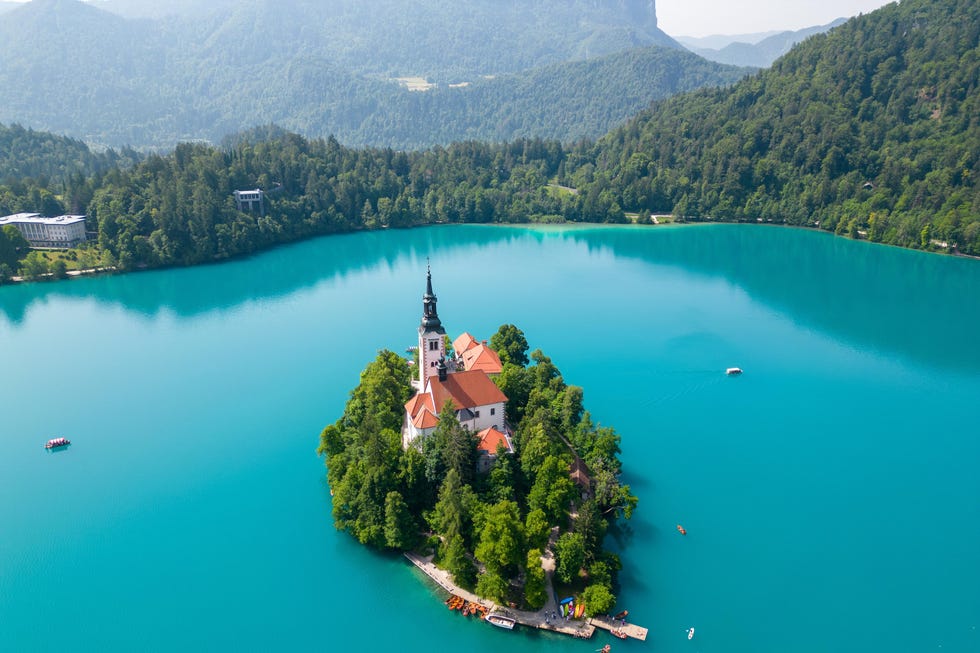
Famously welcoming, Slovenia is the perfect destination when travelling alone.
Bordering Hungary, Italy, Austria and Croatia , this small but mighty country is relatively straightforward to explore, thanks to its efficient transport system. The fact that there's also plenty to see and do – and that most people speak English – means it should be on any solo adventurer’s must-visit list.
This six-day guided Slovenia adventure , departing in October 2024, is a great introduction to Central and Southeastern Europe. The trip begins and ends in Ljubljana, Slovenia's cobblestoned capital, and includes tours of Triglav National Park, Lake Bled (pictured) and the UNESCO-listed Skocjan caves.
You’ll also enjoy wine tasting in the Vipava Valley and an afternoon learning about the art of truffle hunting.

For the original Shirley Valentine experience, look no further than Greece and its beautiful islands. Greece is ideal for solo travellers, whether you want to hoover up the ancient history in Athens or hop around the islands, relaxing on beaches and dining Shirley-style in traditional tavernas.
With an abundance of sprawling beach resorts, white-washed fishing harbours and rugged mountain villages to pick from on the islands, the hardest part is choosing which one to visit.
If you're looking to explore your creative side, check out learning holidays company Skyros . Staying in a rustic eco-lodge, this week-long holiday on Skyros (pictured), in the southern Sporades, includes creative writing sessions, stand-up comedy workshops and relaxing yoga classes.

As our closest continental neighbours, France is a good place to start when venturing abroad solo. It's easy to get around, dining alone is welcomed and the French are very accustomed to tourists.
Follow in the footsteps of Claude Monet on this four-day Good Housekeeping holiday taking in Paris and Giverny. Great for single travellers with a passion for art, the base for the trip (departing in July 2024) is the four-star Château de Montvillargenne in the heart of the Chantilly forest.
Excursions include a visit to Château de Chantilly and the market town of Senlis plus a guided tour of Monet's gardens in Giverny (pictured) led by gardening expert and writer Paula McWaters.

Considered to be one of the most captivating landscapes on the planet, Iceland is a must for any adventurer, including those going it alone.
With incredibly welcoming locals, Iceland is known as the Land of Fire and Ice, and offers visitors the chance to bathe in hot springs, climb sheer glaciers or come face-to-face with feisty volcanoes. To see this vast landscape in style, it's well worth joining a group tour (ideal for solo travellers) or hiring a car.
Soak in the famous Blue Lagoon (pictured), see the Skógafoss waterfall and hike up the Sólheimajökull glacier on an exhilarating five-day tour of Iceland. Hosted by Regent Holidays , this is a great option for solo travellers aiming to tick off a range of Iceland activities.

India was one of the first countries I ever travelled around alone (talk about throwing myself in at the deep end!) and while it was challenging in parts, it was also rewarding and transformative.
Whether you're looking to hike the Himalayas, 'find yourself' through yoga and meditation on a retreat or marvel at the Taj Mahal, India's unique culture and vibrancy is bucket list-worthy.
One of the easiest ways to explore India on your own is on an escorted tour. Solos Holidays itineraries are made specifically for the single traveller, and their Splendour's of Rajasthan tour explores the Golden Triangle of Jodhpur, Jaipur and Agra. Highlights include seeing the Taj Mahal at sunrise (pictured) and visiting the Amber Fort in the Aravalli Hills.

Gorgeous white beaches, rugged national parks and perhaps the prettiest medieval walled city in the world (hello, Dubrovnik ), Croatia is one of my favourite places in Europe to explore by myself.
Croatia is an easy country to get around, whether you want to go island hopping by ferry, catch a coach along the Adriatic Coast or hire a car to explore the country’s rugged interior.
If you want to see Croatia with a some like-minded folk, consider booking an escorted tour with Just You , a solo holidays specialist. Their Croatia and the Markarska Riviera trip focuses on the Dalmatian Coast and is bookended by stays in Zadar and Dubrovnik. It also includes a brilliant boat trip to Hvar and Brac (pictured), and a visit to Krka National Park.
More travel ideas:
- The best cruises for 2024
- Venice's hidden gems
- The 2025 holidays worth booking in advance
- The best mother-daughter holiday ideas
- Amazing holidays with celebrity guests

@media(max-width: 64rem){.css-o9j0dn:before{margin-bottom:0.5rem;margin-right:0.625rem;color:#ffffff;width:1.25rem;bottom:-0.2rem;height:1.25rem;content:'_';display:inline-block;position:relative;line-height:1;background-repeat:no-repeat;}.loaded .css-o9j0dn:before{background-image:url(/_assets/design-tokens/goodhousekeeping/static/images/Clover.5c7a1a0.svg);}}@media(min-width: 48rem){.loaded .css-o9j0dn:before{background-image:url(/_assets/design-tokens/goodhousekeeping/static/images/Clover.5c7a1a0.svg);}} Travel

Top food holidays for gourmands
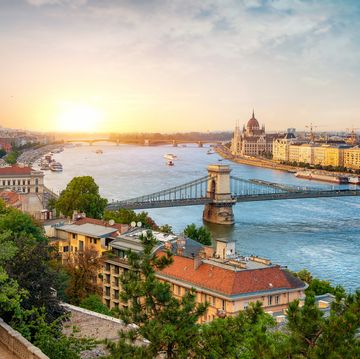
The most beautiful Danube cities and towns
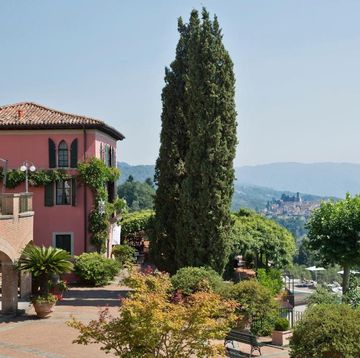
The best hotels in Tuscany
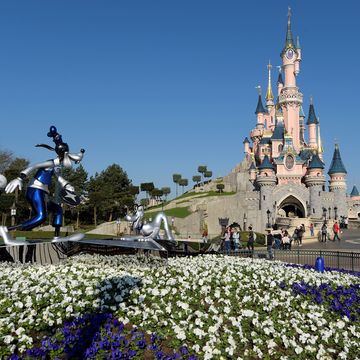
The nearest hotel to Disneyland Paris
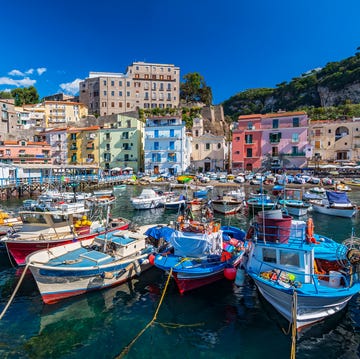
The best hotels in Sorrento

Spain's most beautiful holiday destinations

The most amazing Mediterranean islands
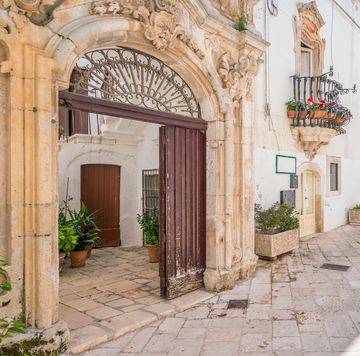
This humble Puglian town is Italy's prettiest

The best luxury hotel offers

14 of the most stylish weekend bags

The best Lake Como hotels

How To Plan Your Own 'Eat, Pray, Love' Vacation
T here may come a time in your life when you find yourself overwhelmed by the chaos of being, longing for the transformation that travel provides. Times of difficulty may call for you to step outside of your comfort zone and open yourself to new experiences that will ultimately lead to deep healing and growth.
Perhaps you've recently ended a long-term relationship, and you're heartbroken and unsure of what's next. Maybe the death of a loved one has left you grief-stricken, or you wake up one day and realize that the career you've spent your entire life building no longer fulfills you. In these moments Elizabeth Gilbert's memoir "Eat, Pray, Love" might speak to your heart and inspire you to book your own transformational journey.
Elizabeth Gilbert's dark night of the soul came in the form of a difficult divorce, depression, and a realization that she'd lost touch with herself. She set out on a self-discovery journey that eventually inspired her best-selling book. While her journey was incredibly personal, millions of people related to her experience, and the "Eat, Pray, Love" phenomenon inspired many to pack their bags.
If you're feeling called to create your own transformational trip, designing an itinerary with your personal growth as the focus is essential. Your experience should be specific to you and designed with your personal growth in mind. "Ruin is a gift," Gilbert wrote. "Ruin is the road to transformation." As your journey along that road, you might just find yourself along the way.
Read more: It's Time To Ditch These 10 Outdated Travel Tips
Choose Destinations That Inspire You
"Eat, Pray, Love" isn't a travel guidebook, but it can serve as a blueprint to create your own life-changing experience through travel. Instead of following in Elizabeth Gilbert's footsteps, consider choosing destinations you feel personally called to visit.
You don't have to travel to Italy, India, and Indonesia to find yourself. Perhaps you've always dreamed of hiking through the Alaskan wilderness or working on a sustainable farm in the rainforests of Costa Rica . Instead of indulging in piles upon piles of pasta, you might dream of treating yourself to a vintage shopping spree on the streets of London . You don't even have to visit three destinations — choose as many destinations as you desire.
The "eat" portion of your trip can involve indulging in pleasure and fun. When choosing a destination, focus on reconnecting with what brings you joy. For Gilbert, that was eating all the Italian food, buying bigger jeans, and forging new friendships. The "pray" portion of your trip can be any destination that inspires you spiritually. It doesn't have to be a religious experience, but it certainly can be. For some, this may look like a spiritual pilgrimage, while for others, it could be connecting with oneself in the solitude of nature. While Gilbert eventually learns to love again in the final portion of her trip, the most important relationship she forges during her travels is the self-love and acceptance she finds for herself.
Embrace The Sweetness Of Doing Nothing
Trying to jam-pack your schedule full of activities is an easy mistake to make when traveling. After all, there's so much to do, see, and experience, and you want to take advantage of everything. Even so, over-scheduling yourself during your travels can quickly become exhausting, and you might miss out on some of the magic of simply being in a new environment. During your trips, make sure to set aside some unscheduled and unscripted time to wander the city.
Sometimes the most impactful moments during travel happen when you're doing nothing at all, or as Gilbert learned and later wrote about in "Eat, Pray, Love" — embracing "dolce far niente," or the "pleasure of doing nothing." You might wander the streets of an unfamiliar city, allowing yourself to get lost in the twists and turns. Perhaps you'll stumble across a quaint cafe where you can sip an espresso and watch the locals or meet a new acquaintance who will become a lifelong friend. Simply relaxing on the balcony of your hotel while soaking up the morning sunshine and snacking on treats from a local bakery as you take in the city might become one of your favorite moments during your trip.
Museums, tourist attractions, and must-see spots are worth visiting, but make sure you have time to relax and just be. Allowing yourself the freedom to explore without a destination or objective can be a profound experience.
Consider Learning Something New
Elizabeth Gilbert chose to learn Italian while experiencing delicious food and passionate Italian culture. During her painful divorce, learning Italian became a welcomed distraction — something that occupied her mind and held her focus enough to function as a life raft while her life imploded around her. As her passion for the language grew, she became increasingly inspired to travel and continue to learn.
Travel and education expand our minds and allow us to move outside our comfort zones. For your "Eat, Pray, Love" experience, consider focusing on trying something new or learning a new skill. Have you always dreamed of getting your scuba certification or signing up for a language immersion program? Look into art classes, writer's workshops, cooking courses, or anything else that inspires you. Let this be your chance to try something new and fulfill a lifelong goal. The sky's the limit regarding the things you can learn while traveling.
Explore Your Spiritual Side
Elizabeth Gilbert longed for spiritual fulfillment and a personal connection with God, which she found through living in an Ashram in India. She intended to find peace through spirituality and was surprised by the challenges she faced and the insights she gained through exploring her meditation practice. Your spiritual journey doesn't have to mimic hers — it should align with your personal spiritual beliefs.
Even if you aren't religious, you can still find spiritual fulfillment through connecting with yourself, other people, or the natural world. If you find spirituality intimidating or don't know where to start, consider signing up for a volunteer experience that aligns with your morals. Giving back to a meaningful cause is a beautiful way to connect with yourself and the world around you.
The Peace Corps offers a variety of volunteer opportunities around the world, including room and board, but you often have to commit to volunteering for at least two years. For shorter-term volunteer opportunities, check out reputable and well-established organizations in the community you will be serving.
Focus On Learning To Love Yourself Through Solo-Travel
Solo travel is the perfect opportunity to find yourself, but it isn't always comfortable. You're sure to make plenty of friends along the way, but there will be times when you will feel utterly alone. Embracing the discomfort of loneliness and learning to depend on yourself in new situations is an excellent way to develop a deeper connection with yourself.
While we all may dream of finding true love during our travels like Elizabeth Gilbert eventually did in Bali, try to keep your focus on developing a sense of self-love. Learn to be your best friend, and treat yourself with all the love you would a friend, family member, or partner. Pour all of that love into your own cup. Take yourself on a cute date to a new restaurant and avoid the urge to spend the meal looking at your phone so that you can learn to love your own company.
"People think a soulmate is your perfect fit, and that's what everyone wants," Gilbert wrote. "But a true soul mate is a mirror, the person who shows you everything that is holding you back, the person who brings you to your own attention so you can change your life." Sometimes, that person turns out to be you.
Read the original article on Explore .


IMAGES
VIDEO
COMMENTS
Learn how to plan your own trip to Italy with this step-by-step guide. Find out when to go, how much it will cost, what to do, where to stay and more tips and resources.
How to get around Italy - Using extra-urban public transport. Decide when to rent a car in Italy. Decide what to pack, essential when planning a trip to Italy. Tailor your own Italy itinerary. Set your budget: average cost of a trip to Italy. Find the right accommodation in Italy. Book your tours and tickets ahead.
The ideal length of a trip to Italy greatly depends on your travel desires and time constraints. For a decent first visit, aim for at least 7 to 10 days, which will let you cover the country's major cities such as Rome , Florence, and Venice with a day or two for exploring smaller towns.
Exploring Italy's hill towns could soak up a week. For mountains, make tracks to the Dolomites. And if you've always wanted to ascend Pisa's Leaning Tower, now's the time for the climb. Depending on the length of your trip, and taking geographic proximity into account, here are my recommended priorities: 4 days: Rome, Florence; 6 days, add: Venice
Welcome to Untold Italy. Planning trips to Italy is always exciting, no matter if it is your first or fifteenth. Whether you're charmed by its fascinating cities or incredible landscapes there is a corner of Italy waiting to be discovered. Please join us on our popular Italy Travel Planning Community, read our blog and listen to our Untold ...
Step 1: Check visa requirements. Based on the geographic readership of this blog, odds are that the vast majority of you will not need a visa to visit Italy for up to 90 days for tourism purposes. This includes citizens of the USA, Canada, the UK, Australia, and of course, anyone from an EU member state. Italy is part of the Schengen Zone, and ...
2.Determine when you want to go. 3.Check the Visa requirements for Italy and obtain one if needed. 4.Ensure that your passport is valid and up to date. 5.Establish a budget for your trip, including accommodation, transportation, food, and activities. 6.Book your flight ticket to Italy. 7.Start planning your itinerary.
Untold Italy's ultimate travel PLANNER. Get organized and start planning your trip to Italy without the overwhelm with our printable PDF planner. We've poured all our expertise gained from over 30 trips to Italy into our planner so you have tried and true methods for ensuring you have all the details covered off for your trip.
With Wanderlog's mobile travel planner on Android and iOS, access and edit your trips wherever you go — even while offline. 4.9 on App Store, 4.7 on Google Play. Keep your places to visit, flight/hotel reservations, and day-by-day itineraries for your trip to Italy in our web and mobile app vacation planner.
Here's an estimate for two people weekly in Italy: Budget Trip: For a budget-style trip for two, plan to spend $1000 to $2000 weekly. This covers stays, meals, transport, and some attractions. Opt for budget lodgings, pizzerias, street foods, simple trattorias, and public transport.
Northern Italian lakes - scenic lakes close to alpine mountain ranges. As a general rule, for a 3-5 day trip choose one destination - a city or area. If you have a week to 10 days then 1-3 places in either the north OR south of Italy. For a 2 week trip you could cover 3-4 places and see both north and south.
Step 1: when to go to Italy and deciding your budget. Step 2: decide where to go in Italy and the type of trip. Step 3: confirm the number of days/weeks. Step 4: book your flights. Step 5: book your accommodation. Step 6: check your passport and whether you need a visa. Step 7: research and book transport.
Planning Your Trip. Best Time to Visit: The best months to visit Italy depend on your preferences as a traveler. Springtime and early summer—April, May, and June—sees gorgeous weather, mostly mild temperatures and crowds that range from moderate to dense.
Step 3: Plot Those Places on Your Map. This is when the rubber begins to meet the proverbial road. Take the list you created in step two and find those places on the map you procured in step one. Use push-pins, post-it flags, or Google's teardrop icons - whatever suits you, so long as it's removable.
1. Venice, Florence & Rome by Train. You could easily find enough attractions to spend a week in each of these cities, but you can see the highlights of all three in a well-planned week. The total travel time between Venice and Rome is only three and a half hours, so you can make the maximum use of your time.
These Italy trip packages feature top sights, guided programs, downtown hotels, and private transfers. You might even want to call them all-inclusive trips to Italy, as the list of inclusions is lengthy. So get ready to explore the best of Italy with your choice of program. Whether it's as short as a 7-day trip to Italy or a 2-week trip to ...
Best for: Sun seekers, sea lovers and honeymooners. Places visited: Amalfi Coast, Sorrento, Capri, Pompeii, Naples, Rome. Start/end in: Naples or Rome. Try to arrange flights into one and out of other. Recommended transport: Private transfer to Amalfi Coast, local ferries, private driver, train to Rome.
Italy travel requirements. Before you get too excited about planning your Italy trip, make sure you have the right documentation.. To visit Italy, you need a passport with at least six months' validity from your arrival date. USA and Canadian passport holders can stay in the country for 90 glorious gelato-filled days without a visa.
Now for your 10-day trip to Italy, which includes Rome, Tuscany, Florence, Bologna, and Venice. Note: Your tour starts on the day after you arrive, unless you fly in quite early, otherwise you won't have enough time to see everything in Rome. You need 2 full days to do it.
Mistake #6: Completely Writing Off Renting A Car In Italy. Another mistake people make when planning a trip to Italy is completely writing off renting a car. This is a HUGE MISTAKE for Italy trips because renting a car will provide you with so much freedom. It is the best way to tour Italy!
Absolutely. Planning your own trip to Italy does require more work than booking a package trip, there's no getting around that. If you're one of the many over-worked people who barely has time to do the grocery shopping, let alone research hotels in Venice, you might feel a panic attack coming on at the very thought of figuring out all the ...
Trip Planner - Italy. Easily plan your trip based on your preferences, budget, and style. Plan your trip with RoutePerfect's AI and optimize it by using RoutePerfect's crowdsourced database, based on proven and enjoyable, well-crafted itineraries of thousands of travelers. Explore Italy's famous cities, roam through its cobblestone ...
What To Expect On A Trip To Italy. Travel in Italy feels almost like it did pre-COVID. More people wear masks (and they're still required in some places). It's smart to pack COVID rapid tests and be mindful of the local case levels. If you happen to get COVID during your trip, you'll need to self-isolate for 5 - 14 days.
According to American Express' latest Global Travel Trends report, 69 per cent of travellers are planning to go it alone this year, with women in the post-45 age bracket leading the charge ...
Elizabeth Gilbert's memoir "Eat, Pray, Love" chronicles her soul-searching journey across Italy, India, and Indonesia. Here's how you can make your own.